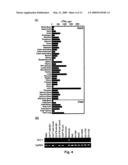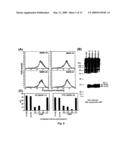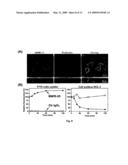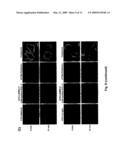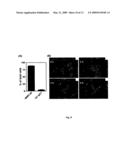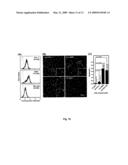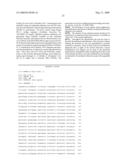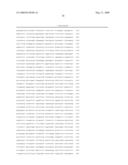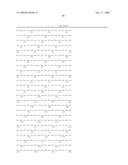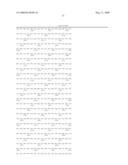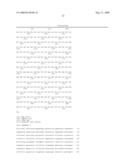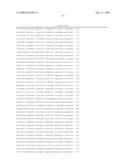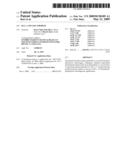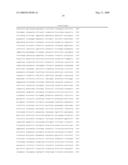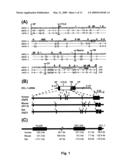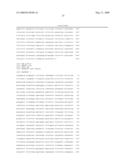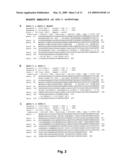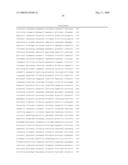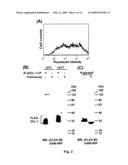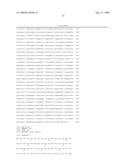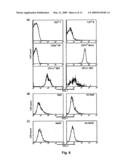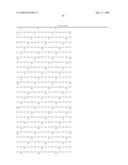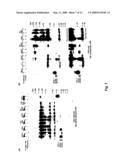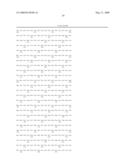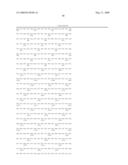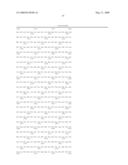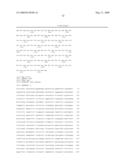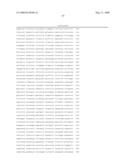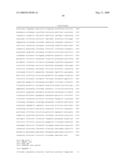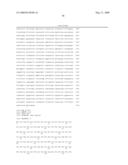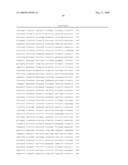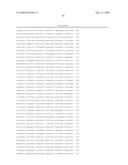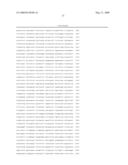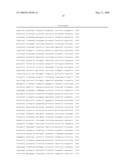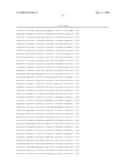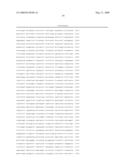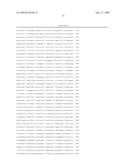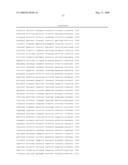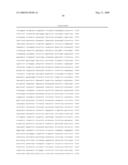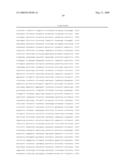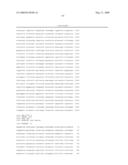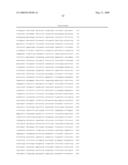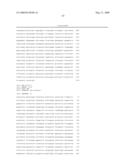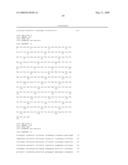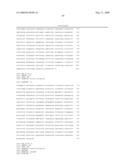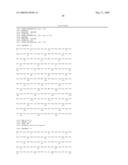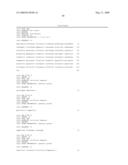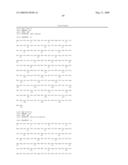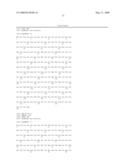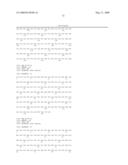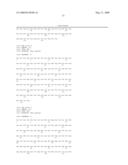Patent application title: DCL-1 and uses thereof
Inventors:
Derek Nigel John Hart (Dutton Park, AU)
Masato Kato (South Brisbane, AU)
IPC8 Class: AA61K39395FI
USPC Class:
4241391
Class name: Drug, bio-affecting and body treating compositions immunoglobulin, antiserum, antibody, or antibody fragment, except conjugate or complex of the same with nonimmunoglobulin material binds antigen or epitope whose amino acid sequence is disclosed in whole or in part (e.g., binds specifically-identified amino acid sequence, etc.)
Publication date: 2009-05-21
Patent application number: 20090130109
Claims:
1. A method for modulating an immune function of a cell that expresses
DCL-1, the method comprising exposing the cell to an agent that modulates
the level or functional activity of DCL-1, wherein the agent is selected
from the group consisting of:a) a proteinaceous molecule comprising an
amino acid sequence which has at least 75% sequence identity to the
sequence set forth in any one of SEQ ID NOs: 8, 12, 15 or 16 and which
modulates at least one immune function selected from the group consisting
of endocytosis, phagocytosis, cell adhesion and cell migration;b) a
proteinaceous molecule comprising an amino acid sequence which is encoded
by a nucleotide sequence that hybridizes under high stringency conditions
to the sequence set forth in any one of SEQ ID NOs: 7, 10, 11, 13, 14, 17
or 18 and which modulates at least one immune function selected from the
group consisting of endocytosis, phagocytosis, cell adhesion and cell
migration;c) an antibody or fragment thereof which specifically binds to
the amino acid sequence defined in a) or b);d) a nucleic acid molecule
comprising a nucleotide sequence that encodes the amino acid sequence
defined in a) or b);e) a nucleic acid molecule comprising a nucleic acid
sequence that hybridizes under high stringency conditions to the
nucleotide sequence defined in d); andf) a nucleic acid molecule which
comprises a nucleotide sequence that is antisense to the nucleotide
sequence defined in d) or e).
2. The method of claim 1, wherein the immune function is endocytosis.
3. The method of claim 1, wherein the immune function is phagocytosis.
4. The method of claim 1, wherein the immune function is cell adhesion.
5. The method of claim 1, wherein the immune function is cell migration.
6. A method of modulating an immune response, comprising exposing a cell that expresses DCL-1 to an agent that modulates the level or functional activity of DCL-1, wherein the agent is selected from the group consisting of:a) a proteinaceous molecule comprising an amino acid sequence which has at least 75% sequence identity to the sequence set forth in any one of SEQ ID NOs: 8, 12, 15 or 16 and which modulates at least one immune function selected from the group consisting of endocytosis, phagocytosis, cell adhesion and cell migration;b) a proteinaceous molecule comprising an amino acid sequence which is encoded by a nucleotide sequence that hybridizes under high stringency conditions to the sequence set forth in any one of SEQ ID NOs: 7, 10, 11, 13, 14, 17 or 18 and which modulates at least one immune function selected from the group consisting of endocytosis, phagocytosis, cell adhesion and cell migration;c) an antibody or fragment thereof which specifically binds to the amino acid sequence defined in a) or b);d) a nucleic acid molecule comprising a nucleotide sequence that encodes the amino acid sequence defined in a) or b);e) a nucleic acid molecule comprising a nucleotide sequence that hybridizes under high stringency conditions to the nucleotide sequence defined in d);f) a nucleic acid molecule which comprises a nucleotide sequence that is antisense to the nucleotide sequence defined in d) or e); andg) an inhibitory RNA molecule that is specific to the nucleotide sequence defined in d) or e).
7. A method of treating or preventing a disease associated with an aberrant immune response in a subject, the method comprising administering to the subject an immune response-modulating effective amount of an agent that modulates the level or functional activity of DCL-1, wherein the agent is selected from the group consisting of:a) a proteinaceous molecule comprising an amino acid sequence which has at least 75% sequence identity to the sequence set forth in any one of SEQ ID NOs: 8, 12, 15 or 16 and which modulates at least one immune function selected from the group consisting of endocytosis, phagocytosis, cell adhesion and cell migration;b) a proteinaceous molecule comprising an amino acid sequence which is encoded by a nucleotide sequence that hybridizes under high stringency conditions to the sequence set forth in any one of SEQ ID NOs: 7, 10, 11, 13, 14, 17 or 18 and which modulates at least one immune function selected from the group consisting of endocytosis, phagocytosis, cell adhesion and cell migration;c) an antibody or fragment thereof which specifically binds to the amino acid sequence defined in a) or b);d) a nucleic acid molecule comprising a nucleotide sequence that encodes the amino acid sequence defined in a) or b);e) a nucleic acid molecule comprising a nucleotide sequence that hybridizes under high stringency conditions to the nucleotide sequence defined in d);f) a nucleic acid molecule which comprises a nucleotide sequence that is antisense to the nucleotide sequence defined in d) or e); andg) an inhibitory RNA molecule that is specific to the nucleotide sequence defined in d) or e).
8. A method of treating or preventing a disease associated with an unwanted immune response in a subject, the method comprising administering to the subject an immune response-modulating effective amount of an agent that modulates the level or functional activity of DCL-1, wherein the agent is selected from the group consisting of:a) a proteinaceous molecule comprising an amino acid sequence which has at least 755% sequence identity to the sequence set forth in any one of SEQ ID NOs: 8, 12, 15 or 16 and which modulates at least one immune function selected from the group consisting of endocytosis, phagocytosis, cell adhesion and cell migration;b) a proteinaceous molecule comprising an amino acid sequence which is encoded by a nucleotide sequence that hybridizes under high stringency conditions to the sequence set forth in any one of SEQ ID NOs: 7, 10, 11, 13, 14, 17 or 18 and which modulates at least one immune function selected from the group consisting of endocytosis, phagocytosis, cell adhesion and cell migration;c) an antibody or fragment thereof which specifically binds to the amino acid sequence defined in a) or b);d) a nucleic acid molecule comprising a nucleotide sequence that encodes the amino acid sequence defined in a) or b);e) a nucleic acid molecule comprising a nucleotide sequence that hybridizes under high stringency conditions to the nucleotide sequence defined in d);f) a nucleic acid molecule which comprises a nucleotide sequence that is antisense to the nucleotide sequence defined in d) or e); andg) an inhibitory RNA molecule that is specific to the nucleotide sequence defined in d) or e).
9. The method according to claim 7 or claim 8, wherein the disease is cancer.
10. The method according to claim 7 or claim 8, wherein the disease is an infectious disease.
11. The method according to claim 7 or claim 8, wherein the disease is associated with an unwanted or deleterious immune response.
12. The method according to claim 7 or claim 8, wherein the agent is the antibody or antibody fragment, which is coupled to, or otherwise associated with, an antigen that corresponds to at least a portion of a target antigen that associates with the disease.
13. The method of any one of claims 1, 6, 7 or 8, wherein the proteinaceous molecule of a) comprises an amino acid sequence which has at least 80% sequence identity to the sequence set forth in any one of SEQ ID NOs: 8, 12, 15 or 16.
14. The method of any one of claims 1, 6, 7 or 8, wherein the proteinaceous molecule of a) comprises an amino acid sequence which has at least 85% sequence identity to the sequence set forth in any one of SEQ ID NOs: 8, 12, 15 or 16.
15. The method of any one of claims 1, 6, 7 or 8, wherein the proteinaceous molecule of a) comprises an amino acid sequence which has at least 90% sequence identity to the sequence set forth in any one of SEQ ID NOs: 8, 12, 15 or 16.
16. The method of any one of claims 1, 6, 7 or 8, wherein the proteinaceous molecule of a) comprises an amino acid sequence which has at least 95% sequence identity to the sequence set forth in any one of SEQ ID NOs: 8, 12, 15 or 16.
17. A method of screening an agent for ability to modulate an immune response, comprising:a) contacting a cell expressing a nucleic acid molecule that comprises (a) a nucleotide sequence encoding an amino acid sequence which has at least 75% sequence identity to the sequence set forth in any one of SEQ ID NOs: 8, 12, 15 or 16 and which modulates at least one immune function selected from the group consisting of endocytosis, phagocytosis, cell adhesion and cell migration; or (b) a nucleotide sequence that hybridizes under high stringency conditions to the sequence set forth in any one of SEQ ID NOs: 7, 10, 11, 13, 14, 17 or 18 and which encodes an amino acid sequence that modulates at least one immune function selected from the group consisting of endocytosis, phagocytosis, cell adhesion and cell migration, with the agent; andb) detecting a change in the level and/or activity of an expression product of the nucleic acid molecule, relative to a normal or reference level and functional activity in the absence of the agent, wherein the change indicates that the agent modulates the immune response.
18. The method of claim 17, wherein the nucleic acid molecule expressed by the cell of a) encodes an amino acid sequence which has at least 75% sequence identity to the sequence set forth in any one of SEQ ID NOs: 8, 12, 15 or 16.
19. The method of claim 17, wherein the nucleic acid molecule expressed by the cell of a) encodes an amino acid sequence which has at least 80% sequence identity to the sequence set forth in any one of SEQ ID NOs: 8, 12, 15 or 16.
20. The method of claim 17, wherein the nucleic acid molecule expressed by the cell of a) encodes an amino acid sequence which has at least 85% sequence identity to the sequence set forth in any one of SEQ ID NOs: 8, 12, 15 or 16.
21. The method of claim 17, wherein the nucleic acid molecule expressed by the cell of a) encodes an amino acid sequence which has at least 90% sequence identity to the sequence set forth in any one of SEQ ID NOs: 8, 12, 15 or 16.
22. The method of claim 17, wherein the nucleic acid molecule expressed by the cell of a) encodes an amino acid sequence which has at least 95% sequence identity to the sequence set forth in any one of SEQ ID NOs: 8, 12, 15 or 16.
Description:
CROSS-REFERENCE TO RELATED APPLICATIONS
[0001]This application us a Continuation-in-Part of U.S. application Ser. No. 10/537,839, which is a U.S. National Phase of International Application No. PCT/AU2003/001634, filed Dec. 5, 2003 and published in English, which claims priority to Australian Provisional Application No. 2002953223 filed Dec. 6, 2002. The entire contents of each and all these applications being hereby incorporated by reference herein in their entirety as if fully disclosed herein.
FIELD OF THE INVENTION
[0002]The present invention relates generally to a novel lectin and to derivatives, homologues, analogues, chemical equivalents and mimetics thereof and, more particularly, to a novel type I C-type lectin, herein referred to as "DCL-1". In particular, the present invention relates to the use of DCL-1 in therapeutic, prophylactic and diagnostic applications.
BACKGROUND OF THE INVENTION
[0003]The reference to any prior art in this specification is not, and should not be taken as, an acknowledgment or any form of suggestion that that prior art forms part of the common general knowledge in Australia.
[0004]The C-type lectins represent a large family of Ca++-dependent lectins that share primary structural homology in their carbohydrate-recognition domains. This very large family, which includes many endocytic receptors, many proteoglycans, and all known collectins and selecting, is found throughout the animal kingdom. Most of the members of this family differ, however, with respect to the types of carbohydrate structures that they recognize with high affinity. The C-type lectin family is diverse and is associated with many immune-system functions, such as inflammation and immunity to tumor and virally infected cells.
[0005]To date, more than 20 different proteins containing a C-type lectin carbohydrate-recognition domain have been identified in humans and corresponding homologs have also been found in many other higher animals. In addition, C-type lectins occur in many other vertebrates, including reptiles, and in invertebrates. From the genomic sequencing of Caenorhabditis elegans, approximately 150 C-type lectin genes have been identified. These many C-type lectins in higher animals are classified into subfamilies, based on their function or unique localization.
[0006]A growing list of proteins containing the C-type carbohydrate-recognition domain has been identified on human and rodent lymphocytes. For the most part, the functions of these proteins are poorly understood and their ability to bind carbohydrate has not been demonstrated.
[0007]DCL-1 (DEC-205-associated C-type lectin), also known as CD302, is a member of the C-type lectin receptor superfamily of cell surface proteins. DCL-1 is highly conserved amongst the human, mouse and rat homologues. The human DCL-1 gene, composed of 6 exons, is located in a cluster of type I transmembrane C-type lectin genes on chromosomal band 2q24. DCL-1 is known to be expressed by phagocytic white blood cells, which provide vital roles in innate and adaptive immune defenses.
SUMMARY OF THE INVENTION
[0008]As explained in more detail below, the present invention is based on the discovery that DCL-1 behaves as an endocytic and phagocytic receptor and co-localizes with F-actin structures on filopodia, lamellipodia and podosomes. Thus the present inventors have determined that DCL-1 is involved in endocytosis, phagocytosis, cell adhesion and cell migration mediated by cells including immune cells such as antigen-presenting cells. Moreover, the inventors believe that DCL-1 as well as agonists and antagonists thereof can be used to modulate endocytosis, phagocytosis, cell adhesion and/or migration, and that these activities can be used as surrogate markers of DCL-1 level or activity. Thus, the present invention relates to the use of DCL-1 or a biologically fragment or derivative thereof, an antibody or fragment thereof which specifically binds thereto, a nucleic acid molecule encoding DCL-1 or a biologically active fragment or derivative thereof and/or a nucleic acid molecule antisense thereto to modulate endocytosis, phagocytosis, cell adhesion and/or cell migration mediated by cells including immune cells (e.g., antigen-presenting cells).
[0009]Moreover, the inventors hypothesize that DCL-1 or an antibody which specifically binds thereto, or a nucleic acid molecule encoding DCL-1 or a nucleic acid molecule antisense thereto, are targets for therapeutic manipulation and thus have use in the treatment, prevention and/or diagnosis of several diseases, including those associated with fungal or parasitic infections, cancer, hematologic and oncologic diseases, lymphoproliferative diseases, and diseases associated with transplantation, autoimmunity and inflammation.
[0010]Accordingly, in one aspect, the present invention provides a method for modulating an immune function of a cell that expresses DCL-1, the method comprising exposing the cell to an agent that modulates the level or functional activity of DCL-1, wherein the agent is selected from the group consisting of: [0011]a) a proteinaceous molecule comprising an amino acid sequence which has at least 75% sequence identity to the sequence set forth in any one of SEQ ID NOs: 8, 12, 15 or 16 and which modulates at least one immune function selected from the group consisting of endocytosis, phagocytosis, cell adhesion and cell migration; [0012]b) a proteinaceous molecule comprising an amino acid sequence which is encoded by a nucleotide sequence that hybridizes under high stringency conditions to the sequence set forth in any one of SEQ ID NOs: 7, 10, 11, 13, 14, 17 or 18 and which modulates at least one immune function selected from the group consisting of endocytosis, phagocytosis, cell adhesion and cell migration; [0013]c) an antibody or fragment thereof which specifically binds to the amino acid sequence defined in a) or b); [0014]d) a nucleic acid molecule comprising a nucleotide sequence that encodes the amino acid sequence defined in a) or b); [0015]e) a nucleic acid molecule comprising a nucleic acid sequence that hybridizes under high stringency conditions to the nucleotide sequence defined in d); and [0016]f) a nucleic acid molecule which comprises a nucleotide sequence that is antisense to the nucleotide sequence defined in d) or e).
[0017]In some embodiments, the immune function is selected from the group consisting of endocytosis, phagocytosis, cell adhesion and cell migration.
[0018]In some embodiments, the cell is an immune cell, which is suitably but not exclusively an antigen-presenting cell (e.g., dendritic cells and macrophages).
[0019]Another aspect of the present invention provides a method of modulating an immune response, comprising exposing a cell that expresses DCL-1 to an agent that modulates the level or functional activity of DCL-1, wherein the agent is selected from the group consisting of: [0020]a) a proteinaceous molecule comprising an amino acid sequence which has at least 75% sequence identity to the sequence set forth in any one of SEQ ID NO: 8, 12, 15 or 16 and which modulates at least one immune function selected from the group consisting of endocytosis, phagocytosis, cell adhesion and cell migration; [0021]b) a proteinaceous molecule comprising an amino acid sequence which is encoded by a nucleotide sequence that hybridizes under high stringency conditions to the sequence set forth in any one of SEQ ID NOs: 7, 10, 11, 13, 14, 17 or 18 and which modulates at least one immune function selected from the group consisting of endocytosis, phagocytosis, cell adhesion and cell migration; [0022]c) an antibody or fragment thereof which specifically binds to the amino acid sequence defined in a) or b); [0023]d) a nucleic acid molecule comprising a nucleotide sequence that encodes the amino acid sequence defined in a) or b); [0024]e) a nucleic acid molecule comprising a nucleotide sequence that hybridizes under high stringency conditions to the nucleotide sequence defined in d); [0025]f) a nucleic acid molecule which comprises a nucleotide sequence that is antisense to the nucleotide sequence defined in d) or e); and [0026]g) an inhibitory RNA molecule that is specific to the nucleotide sequence defined in d) or e).
[0027]In another aspect the invention provides a method of treating or preventing a disease associated with an aberrant immune response in a subject, the method comprising administering to the subject an immune response-modulating effective amount of an agent that modulates the level or functional activity of DCL-1, wherein the agent is selected from the group consisting of: [0028]a) a proteinaceous molecule comprising an amino acid sequence which has at least 75% sequence identity to the sequence set forth in any one of SEQ ID NOs: 8, 12, 15 or 16 and which modulates at least one immune function selected from the group consisting of endocytosis, phagocytosis, cell adhesion and cell migration; [0029]b) a proteinaceous molecule comprising an amino acid sequence which is encoded by a nucleotide sequence that hybridizes under high stringency conditions to the sequence set forth in any one of SEQ ID NOs: 7, 10, 11, 13, 14, 17 or 18 and which modulates at least one immune function selected from the group consisting of endocytosis, phagocytosis, cell adhesion and cell migration; [0030]c) an antibody or fragment thereof which specifically binds to the amino acid sequence defined in a) or b); [0031]d) a nucleic acid molecule comprising a nucleotide sequence that encodes the amino acid sequence defined in a) or b); [0032]e) a nucleic acid molecule comprising a nucleotide sequence that hybridizes under high stringency conditions to the nucleotide sequence defined in d); [0033]f) a nucleic acid molecule which comprises a nucleotide sequence that is antisense to the nucleotide sequence defined in d) or e); and [0034]g) an inhibitory RNA molecule that is specific to the nucleotide sequence defined in d) or e).
[0035]In another aspect the invention provides a method of treating or preventing a disease associated with an unwanted immune response in a subject, the method comprising administering to the subject the subject an immune response-modulating effective amount of an agent that modulates the level or functional activity of DCL-1, wherein the agent is selected from the group consisting of: [0036]a) a proteinaceous molecule comprising an amino acid sequence which has at least 75% sequence identity to the sequence set forth in any one of SEQ ID NOs: 8, 12, 15 or 16 and which modulates at least one immune function selected from the group consisting of endocytosis, phagocytosis, cell adhesion and cell migration; [0037]b) a proteinaceous molecule comprising an amino acid sequence which is encoded by a nucleotide sequence that hybridizes under high stringency conditions to the sequence set forth in any one of SEQ ID NOs: 7, 10, 11, 13, 14, 17 or 18 and which modulates at least one immune function selected from the group consisting of endocytosis, phagocytosis, cell adhesion and cell migration; [0038]c) an antibody or fragment thereof which specifically binds to the amino acid sequence defined in a) or b); [0039]d) a nucleic acid molecule comprising a nucleotide sequence that encodes the amino acid sequence defined in a) or b); [0040]e) a nucleic acid molecule comprising a nucleotide sequence that hybridizes under high stringency conditions to the nucleotide sequence defined in d); [0041]f) a nucleic acid molecule which comprises a nucleotide sequence that is antisense to the nucleotide sequence defined in d) or e); and [0042]g) an inhibitory RNA molecule that is specific to the nucleotide sequence defined in d) or e).
[0043]In yet another aspect the invention provides the use of an agent that modulates the level or functional activity of DCL-1, wherein the agent is selected from the group consisting of: [0044]a) a proteinaceous molecule comprising an amino acid sequence which has at least 75% sequence identity to the sequence set forth in any one of SEQ ID NOs: 8, 12, 15 or 16 and which modulates at least one immune function selected from the group consisting of endocytosis, phagocytosis, cell adhesion and cell migration; [0045]b) a proteinaceous molecule comprising an amino acid sequence which is encoded by a nucleotide sequence that hybridizes under high stringency conditions to the sequence set forth in any one of SEQ ID NOs: 7, 10, 11, 13, 14, 17 or 18 and which modulates at least one immune function selected from the group consisting of endocytosis, phagocytosis, cell adhesion and cell migration; [0046]c) an antibody or fragment thereof which specifically binds to the amino acid sequence defined in a) or b); [0047]d) a nucleic acid molecule comprising a nucleotide sequence that encodes the amino acid sequence defined in a) or b); [0048]e) a nucleic acid molecule comprising a nucleotide sequence that hybridizes under high stringency conditions to the nucleotide sequence defined in d); [0049]f) a nucleic acid molecule which comprises a nucleotide sequence that is antisense to the nucleotide sequence defined in d) or e); and [0050]g) an inhibitory RNA molecule that is specific to the nucleotide sequence defined in d) or e),in the treatment, prevention and/or diagnosis of a disease associated with an aberrant immune response.
[0051]In yet another aspect the invention provides the use of an agent that modulates the level or functional activity of DCL-1, wherein the agent is selected from the group consisting of: [0052]a) a proteinaceous molecule comprising an amino acid sequence which has at least 75% sequence identity to the sequence set forth in any one of SEQ ID NOs: 8, 12, 15 or 16 and which modulates at least one immune function selected from the group consisting of endocytosis, phagocytosis, cell adhesion and cell migration; [0053]b) a proteinaceous molecule comprising an amino acid sequence which is encoded by a nucleotide sequence that hybridizes under high stringency conditions to the sequence set forth in any one of SEQ ID NOs: 7, 10, 11, 13, 14, 17 or 18 and which modulates at least one immune function selected from the group consisting of endocytosis, phagocytosis, cell adhesion and cell migration; [0054]c) an antibody or fragment thereof which specifically binds to the amino acid sequence defined in a) or b); [0055]d) a nucleic acid molecule comprising a nucleotide sequence that encodes the amino acid sequence defined in a) or b); [0056]e) a nucleic acid molecule comprising a nucleotide sequence that hybridizes under high stringency conditions to the nucleotide sequence defined in d); [0057]f) a nucleic acid molecule which comprises a nucleotide sequence that is antisense to the nucleotide sequence defined in d) or e); and [0058]g) an inhibitory RNA molecule that is specific to the nucleotide sequence defined in d) or e), [0059]in the treatment, prevention and/or diagnosis of a disease associated with an unwanted immune response.
[0060]In some embodiments the disease is selected from cancers, infectious diseases and diseases associated with unwanted or deleterious immune responses.
[0061]In some embodiments the proteinaceous molecule or antibody or antibody fragment as broadly described above is coupled to, or otherwise associated with, an antigen that corresponds to at least a portion of a target antigen that associates with the disease.
[0062]In some embodiments the proteinaceous molecule comprises an amino acid sequence which has at least 80%, 85%, 90% or 95% sequence identity to the sequence set forth in any one of SEQ ID NOs: 8, 12, 15 or 16.
[0063]In another aspect the invention provides a method of screening an agent for ability to modulate an immune response, comprising: [0064]contacting a cell expressing a nucleic acid molecule that comprises (a) a nucleotide sequence encoding an amino acid sequence which has at least 75% sequence identity to the sequence set forth in any one of SEQ ID NOs: 8, 12, 15 or 16 and which modulates at least one immune function selected from the group consisting of endocytosis, phagocytosis, cell adhesion and cell migration; or (b) a nucleotide sequence that hybridizes under high stringency conditions to the sequence set forth in any one of SEQ ID NOs: 7, 10, 11, 13, 14, 17 or 18 and which encodes an amino acid sequence that modulates at least one immune function selected from the group consisting of endocytosis, phagocytosis, cell adhesion and cell migration, with the agent; and [0065]detecting a change in the level and/or activity of an expression product (e.g., transcript or polypeptide) of the nucleic acid molecule, relative to a normal or reference level and functional activity in the absence of the agent, wherein the change indicates that the agent modulates the immune response.
[0066]In some embodiments the nucleic acid molecule expressed by the cell of a) encodes an amino acid sequence which has at least 80%, 85%, 90% or 95% sequence identity to the sequence set forth in any one of SEQ ID NOs: 8, 12, 15 or 16.
[0067]Another aspect of the present invention provides a novel nucleic acid molecule in isolated form wherein said nucleic acid molecule comprises a novel DEC-205 intergenic splice variant.
[0068]In another aspect there is provided a novel nucleic acid molecule in isolated form wherein said nucleic acid molecule comprises a DEC-205/DCL-1 intergenic splice variant.
[0069]Yet another aspect provides a nucleic acid molecule or derivative, homologue or analogue thereof comprising a nucleotide sequence encoding an amino acid sequence substantially as set forth in SEQ ID NO: 2 or SEQ ID NO: 5 or a derivative, homologue or mimetic thereof having at least about 45% or greater similarity to at least 30 contiguous amino acids in SEQ ID NO: 2 or SEQ ID NO: 5.
[0070]Still another aspect provides a novel nucleic acid molecule or a derivative, homologue or analogue thereof in isolated form comprising a nucleotide sequence substantially as set forth in SEQ ID NO: 1 or SEQ ID NO: 4 or a nucleotide sequence having at least about 50% similarity to all or part thereof or a nucleotide sequence capable of hybridizing to the sequence set forth in SEQ ID NO: 1 or SEQ ID NO: 4 under low stringency conditions at 42° C.
[0071]Yet still another aspect of the present invention contemplates a nucleic acid molecule or derivative, homologue or analogue thereof comprising a nucleotide sequence substantially as set forth in SEQ ID NO:1 or SEQ ID NO:4 or a derivative thereof or capable of hybridizing to SEQ ID NO: 1 or SEQ ID NO:4 under low stringency conditions at 42° C. and which encodes an amino acid sequence corresponding to an amino acid sequence set forth in SEQ ID NO:2 or SEQ ID NO:5 or a sequence having at least about 45% similarity to at least 10 contiguous amino acids in SEQ ID NO:2 or SEQ ID NO:5.
[0072]Still yet another aspect of the present invention contemplates a nucleic acid molecule comprising a sequence of nucleotides substantially as set forth in SEQ ID NO: 1 or SEQ ID NO:4.
[0073]A further aspect of the present invention provides a novel cDNA or a derivative, homologue or analogue thereof in isolated form comprising a nucleotide sequence substantially as set forth in SEQ ID NO: 1 or SEQ ID NO: 4 or a nucleotide sequence having at least about 50% similarity to all or part thereof or a nucleotide sequence capable of hybridizing to the sequence set forth in SEQ ID NO: 1 or SEQ ID NO: 4 under low stringency conditions at 42° C.
[0074]Another further aspect of the present invention provides a nucleic acid molecule or derivative, homologue or analogue thereof comprising a nucleotide sequence encoding an amino acid sequence substantially as set forth in SEQ ID NO: 8 or a derivative, homologue or mimetic thereof having at least about 45% or greater similarity to at least 30 contiguous amino acids in SEQ ID NO: 8.
[0075]In another aspect there is provided a nucleic acid molecule or derivative, homologue or analogue thereof comprising a nucleotide sequence encoding an amino acid sequence substantially as set forth in SEQ ID NO: 12 or a derivative, homologue or mimetic thereof having at least about 45% or greater similarity to at least 30 contiguous amino acids in SEQ ID NO: 12.
[0076]In still another aspect there is provided a nucleic acid molecule or derivative, homologue or analogue thereof comprising a nucleotide sequence encoding an amino acid sequence substantially as set forth in SEQ ID NO: 15 or a derivative, homologue or mimetic thereof having at least about 45% or greater similarity to at least 30 contiguous amino acids in SEQ ID NO: 15.
[0077]In yet another aspect, the present invention provides a novel nucleic acid molecule or a derivative, homologue or analogue thereof in isolated form comprising a nucleotide sequence substantially as set forth in SEQ ID NO: 7 or a nucleotide sequence having at least about 50% similarity to all or part thereof or a nucleotide sequence capable of hybridizing to the sequence set forth in SEQ ID NO: 7 under low stringency conditions at 42° C.
[0078]In still yet another aspect, the present invention provides a novel nucleic acid molecule or a derivative, homologue or analogue thereof in isolated form comprising a nucleotide sequence substantially as set forth in SEQ ID NO: 11 or a nucleotide sequence having at least about 50% similarity to all or part thereof or a nucleotide sequence capable of hybridizing to the sequence set forth in SEQ ID NO: 11 under low stringency conditions at 42° C.
[0079]In still another aspect, the present invention provides a novel nucleic acid molecule or a derivative, homologue or analogue thereof in isolated form comprising a nucleotide sequence substantially as set forth in SEQ ID NO: 14 or a nucleotide sequence having at least about 50% similarity to all or part thereof or a nucleotide sequence capable of hybridizing to the sequence set forth in SEQ ID NO: 14 under low stringency conditions at 42° C.
[0080]A further aspect of the present invention contemplates a nucleic acid molecule or derivative, homologue or analogue thereof comprising a nucleotide sequence substantially as set forth in SEQ ID NO:7 or a derivative thereof capable of hybridizing to SEQ ID NO:7 under low stringency conditions at 42° C. and which encodes an amino acid sequence corresponding to an amino acid sequence set forth in SEQ ID NO:8 or a sequence having at least about 45% similarity to at least 30 contiguous amino acids in SEQ ID NO:8.
[0081]In another further aspect the present invention contemplates a nucleic acid molecule or derivative, homologue or analogue thereof comprising a nucleotide sequence substantially as set forth in SEQ ID NO: 11 or a derivative thereof capable of hybridizing to SEQ ID NO:11 under low stringency conditions at 42° C. and which encodes an amino acid sequence corresponding to an amino acid sequence set forth in SEQ ID NO: 12 or a sequence having at least about 45% similarity to at least 30 contiguous amino acids in SEQ ID NO:12.
[0082]In still another further aspect the present invention contemplates a nucleic acid molecule or derivative, homologue or analogue thereof comprising a nucleotide sequence substantially as set forth in SEQ ID NO:14 or a derivative thereof capable of hybridizing to SEQ ID NO:14 under low stringency conditions at 42° C. and which encodes an amino acid sequence corresponding to an amino acid sequence set forth in SEQ ID NOs:15 or 16 or a sequence having at least about 45% similarity to at least 30 contiguous amino acids in SEQ ID NOs:15 or 16.
[0083]Yet another further aspect of the present invention contemplates a nucleic acid molecule comprising a sequence of nucleotides substantially as set forth in SEQ ID NO:7, SEQ ID NO:11 or SEQ ID NO:14.
[0084]Still another further aspect of the present invention is directed to an isolated protein selected from the list consisting of: [0085](i) An isolated DEC-205 intergenic splice variant or a derivative, homologue, analogue, chemical equivalent or mimetic thereof. [0086](ii) An isolated DEC-205/DCL-1 intergenic splice variant or a derivative, homologue, analogue, chemical equivalent or mimetic thereof. [0087](iii) A protein having an amino acid sequence substantially as set forth in SEQ ID NO: 2 or SEQ ID NO: 5 or a derivative, homologue or mimetic thereof or a sequence having at least about 45% similarity to at least 30 contiguous amino acids in SEQ ID NO: 2 or SEQ ID NO: 5 or a derivative, homologue, analogue, chemical equivalent or mimetic of said protein. [0088](iv) A protein encoded by a nucleotide sequence substantially as set forth in SEQ ID NO: 1 or SEQ ID NO:4 or a derivative, homologue or analogue of said nucleotide sequence or a derivative, homologue, analogue, chemical equivalent or mimetic of said protein. [0089](v) A protein encoded by a nucleotide sequence substantially as set forth in SEQ ID NO: 1 or SEQ ID NO: 4 or a derivative, homologue or analogue thereof or a sequence encoding an amino acid sequence having at least about 45% similarity to at least 30 contiguous amino acids in SEQ ID NO: 2 or SEQ ID NO: 5 or a derivative, homologue, analogue, chemical equivalent or mimetic of said protein. [0090](vi) A protein encoded by a nucleic acid molecule capable of hybridizing to the nucleotide sequence set forth in SEQ ID NO:1 or SEQ ID NO:4 or a derivative, homologue or analogue thereof under low stringency conditions at 42° C. or a derivative, homologue, analogue, chemical equivalent or mimetic of said protein. [0091](vii) A protein encoded by a nucleic acid molecule capable of hybridizing to the nucleotide sequence as set forth in SEQ ID NO: 1 or SEQ ID NO:4 or a derivative, homologue or analogue thereof under low stringency conditions at 42° C. and which encodes an amino acid sequence substantially as set forth in SEQ ID NO:2 or SEQ ID NO:5 or a derivative, homologue or mimetic thereof or an amino acid sequence having at least about 45% similarity to at least 30 contiguous amino acids in SEQ ID NO:2 or SEQ ID NO:5. [0092](viii) A protein having an amino acid sequence substantially as set forth in SEQ ID NO: 8, SEQ ID NO: 12, or SEQ ID NOs: 15 or 16 or a derivative, homologue or mimetic thereof or a sequence having at least about 45% similarity to at least 30 contiguous amino acids in SEQ ID NO: 8, SEQ ID NO: 12, or SEQ ID NOs: 15 or 16 or a derivative, homologue, analogue, chemical equivalent or mimetic of said protein. [0093](ix) A protein encoded by a nucleotide sequence substantially as set forth in SEQ ID NOs: 7, 10, 11, 13, 14, 17 or 18 or a derivative, homologue or analogue of said nucleotide sequence or a derivative, homologue, analogue, chemical equivalent or mimetic of said protein. [0094](x) A protein encoded by a nucleotide sequence substantially as set forth in SEQ ID NOs: 7, 11 or 14 or a derivative, homologue or analogue thereof or a sequence encoding an amino acid sequence having at least about 45% similarity to at least 30 contiguous amino acids in SEQ ID NOs: 8, 12, 15 or 16 or a derivative, homologue, analogue, chemical equivalent or mimetic of said protein. [0095](xi) A protein encoded by a nucleic acid molecule capable of hybridizing to the nucleotide sequence set forth in SEQ ID NOs: 7, 10, 11, 13, 14, 17 or 18 or a derivative, homologue or analogue thereof under low stringency conditions at 42° C. or a derivative, homologue, analogue, chemical equivalent or mimetic of said protein [0096](xii) A protein encoded by a nucleic acid molecule capable of hybridizing to the nucleotide sequence as set forth in SEQ ID NOs:7, 11 or 14 or a derivative, homologue or analogue thereof under low stringency conditions at 42° C. and which encodes an amino acid sequence substantially as set forth in SEQ ID NOs:8, 12 or 15 or 16 or a derivative, homologue or mimetic thereof or an amino acid sequence having at least about 45% similarity to at least 30 contiguous amino acids in SEQ ID NOs:8, 12, 15 or 16. [0097](xiii) A protein as defined in any one of paragraphs (i) to (xii) in a homodimeric form. [0098](xiv) A protein as defined in any one of paragraphs (i) to (xii) in a heterodimeric form.
[0099]Another aspect of the present invention contemplates a method of modulating DEC-205 SV expression or DEC-205 SV functional activity in a mammal, said method comprising administering to said mammal an agent for a time and under conditions sufficient to up-regulate, down-regulate or otherwise modulate expression of DEC-205 SV or functioning of DEC-205 SV.
[0100]Yet another aspect of the present invention is directed to a method for modulating DCL-1 expression or DCL-1 functional activity in a mammal, said method comprising administering to said mammal an agent for a time and under conditions sufficient to up-regulate, down-regulate or otherwise modulate said expression or functioning.
[0101]Still another aspect of the present invention contemplates a method for regulating cellular activity in a subject said method comprising administering to said subject an effective amount of an agent for a time and under conditions sufficient to modulate DEC-205 SV expression of DEC-205 SV functional activity.
[0102]In yet another aspect there is contemplated a method of regulating cellular activity in a subject said method comprising administering to said subject an effective amount of an agent for a time and conditions sufficient to modulate DCL-1 expression or DCL-1 functional activity.
[0103]In yet still another aspect there is provided a method for the treatment and/or prophylaxis of a condition characterized by aberrant, unwanted or otherwise inappropriate functioning of DEC-205 SV or DCL-1 in a subject, said method comprising administering to said subject an effective amount of an agent as hereinbefore defined for a time and under conditions sufficient to modulate the expression of DEC-205 SV or DCL-1 and/or functioning of DEC-205 SV or DCL-1.
[0104]In still yet another aspect there is provided a method for the treatment of Hodgkin's lymphoma in a mammal, said method comprising administering to said mammal an effective amount of a cytolytic and/or cytotoxic agent which agent interacts or otherwise associates with DEC-205 SV, for a time and under conditions sufficient for said agent to lyse, apoptose or otherwise kill Hodgkin and Reed-Sternberg cells.
BRIEF DESCRIPTION OF THE DRAWINGS
[0105]The patent or application file contains at least one drawing executed in color. Copies of this patent or patent application publication with color drawings will be provided by the Office upon request and payment of the necessary fee.
[0106]FIG. 1 (A-C) shows a DCL-1 protein and gene comparison amongst different species. (A) Amino acid comparison of human (h), mouse (m) and rat (r) DCL-1 homologues. Identical amino acids are shown in dashes. Conservatively substituted amino acids are highlighted in grey. Deleted amino acids are shown in dots. Conserved cysteine and acidic amino acids are indicated by asterisks and open circles, respectively. Conserved serine/threonine and tyrosine phosphorylation sites are shown in open and closed diamonds, respectively. A potential N-glycosylation site is boxed. Putative endocytosis and late endosome-targeting signals are single and double-underlined, respectively. SP, signal peptide; CTLD, C-type lectin like domain; TM, transmembrane domain; CP cytoplasmic domain. The bold bars indicate untranslated regions. (B) DCL-1 gene structural comparison between human, mouse and rat. In the top panel, boxes indicate structural domains of DCL-1 protein in the complete DCL-1 mRNA. In the lower panels, black boxes and horizontal lines indicate exons and introns, respectively. Numbers indicate exon numbers. Hatched lines indicate exons encoding DCL-1 domains. The chromosomal localization is shown in brackets. (C) C-type lectin gene cluster comparison among human, mouse and rat. Black boxes and horizontal lines indicate C-type lectin genes and intergenic sequences, respectively.
[0107]FIG. 2 (A-C) shows a BLAST2 analyses of the human (h), mouse (m) and rat (r) homologs. (A) hDCL-1 (SEQ ID NO: 23) aligned with mDCL-1 (SEQ ID NO: 26). (B) hDCL-1 (SEQ ID NO: 23) aligned with rDCL-1 (SEQ ID NO: 24). (C) mDCL-1 (SEQ ID NO: 27) aligned with rDCL-1 (SEQ ID NO: 25).
[0108]FIG. 3 (A-C) shows characterization of hDCL-1 protein expressed in tCHO-hDCL-1 transfectants. (A) Surface hDCL-1 protein expressed on HB12 cells was detected with anti-FLAG mAb M2 by flow cytometry (bold line). The grey fill indicates an isotype control staining. (B) Characterization of hDCL-1 protein expressed by HB12 cells. Cell lysate from HB12 cells was immunoprecipitated with anti-hDCL-1 cytoplasmic domain (DCL-1 CP) or preimmune rabbit antibody (Preimmune) and protein A beads, fractionated by SDS-PAGE in reducing (+DTT) or non-reducing conditions (-DTT), followed by Western blotting with anti-FLAG mAb M2 and HRP-conjugated goat anti-mouse IgG. The signals were detected by enhanced chemiluminescence. Asterisks indicate non-specific bands. (C) Effect of N-glycosidase F digestion on HB12-derived hDCL-1 protein. The DCL-1 protein immunoprecipitated from HB12 was digested with N-glycosidase F (N-glyase F) and subjected to Western blot analysis as above. The positions of molecular mass standards are shown on the right. IP, immunoprecipitation; WB, Western blotting.
[0109]FIG. 4 (A-B) shows expression of hDCL-1 mRNA. (A) Expression of hDCL-1 mRNA in multiple tissues. The multiple tissue expression array was probed with [32P]hDCL-1 cDNA and the signals were detected by scintillation counting. (B) Expression of hDCL-1 mRNA in leukocytes. FACS purified leukocytes (purity>98%) and monocyte-derived DC and macrophages (Mph) were subjected to semi-quantitative RT-PCR for hDCL-1 mRNA expression and fractionated by agarose gel electrophoresis. GAPDH was used to normalize the cDNA input.
[0110]FIG. 5 (A-C) shows production and characterization of monoclonal antibodies against hDCL-1 protein. (A) HB12 cells were stained with a series of anti-hDCL-1 mAb (MMRI-18, 19, 20 and 21) and subjected to flow cytometry analysis. The grey fills indicate an isotype control staining. (B) Immunoprecipitation of hDCL-1 protein from PBMC using the anti-DCL-1 mAb. Cell surface biotinylated PBMC lysate was immunoprecipitated with the anti-hDCL-1 mAb or an isotype control IgG1 (Ctr IgG1), subjected to Western blotting in non-reduced conditions. The positions of molecular mass standards are shown on the left. Arrows indicate the specific hDCL-1 protein bands. (C) Inhibition of PE-conjugated MMRI-19 and FITC-conjugated MMRI-20 binding to HB12 by unconjugated anti-hDCL-1 mAb. HB12 cells were preincubated with unconjugated anti-DCL-1 mAb (10 μg/ml), stained with PE-conjugated MMRI-19 (left panel) and FITC-conjugated MMRI-20 (right panel) and their binding detected by flow cytometry. An isotype control IgG1 (Ctr IgG1) was used as negative control.
[0111]FIG. 6 (A-C) shows expression of hDCL-1 on human leukocytes by flow cytometry. (A) Blood leukocytes and lineage negative cells. PBMC were stained with FITC-MMRI-20 in combination with lineage markers as described in Materials and Methods. (B) Expression of hDCL-1 on monocyte-derived Mph. Mph differentiated from CD14+ Mo with CSF-1 were incubated without (Mph) or with LPS (Act Mph) and stained with FITC-MMRI-20. (C) Expression of hDCL-1 on MoDC. MoDC differentiated from CD14+Mo with GM-CSF and IL-4 were incubated without (Mph) or with LPS (Act Mph) and stained with FITC-MMRI-20. The bold line and grey fill indicate MMRI-20 staining and an isotype control staining, respectively.
[0112]FIG. 7 (A-B) shows detection of hDCL-1 in leukocyte lysate by immunoprecipitation/Western blot analysis. (A) Cell lysate from FACS-purified leukocytes, monocyte-derived Mph and MoDC (400 and 133 μg/ml, indicated by black triangles) was immunoprecipitated with anti-hDCL-1 cytoplasmic domain ((DCL-1 CP) or pre-immune rabbit antibody (Preimmune) and protein A beads, fractionated by SDS-PAGE in non-reducing conditions, followed by Western blotting with MMRI-20. HB12 cells were used as a positive control. (B) FACS purified leukocytes, monocyte-derived Mph and MoDC were cell surface-biotinylated and lysed in a lysis buffer. The cell lysate containing equal amount of protein (100 μg/ml) was immunoprecipitated with MMRI-20 or an isotype control antibody (Ctr IgG1) and protein G beads, fractionated by SDS-PAGE in reducing conditions, followed by Western blotting with HRP-conjugated streptavidin and enhanced chemiluminescence detection for short (10 min) and long exposures (16 h). HB12 cells were used as a positive control. Arrows indicate the specific hDCL-1 protein bands. The positions of protein molecular mass standards are shown on the right. Asterisks indicate non-specific bands. Arrowheads indicate potential hDCL-1-associated proteins, coimmunoprecipitated with hDCL-1. IP, immunoprecipitation; WB, Western blotting.
[0113]FIG. 8 (A-C) shows hDCL-1 colocalizes with F-actin and is internalized when bound with hDCL-1 mAb in HB12 cells. (A) Colocalization of hDCL-1 with F-actin in HB12 cells. The cells cultured on cover slips were fixed with PFA, permeabilized and stained with MMRI-21 and AF488-GAM (green), followed by counterstained with Texas red-phalloidin (red) and DAPI (blue). The cells were analyzed by LSM with x-y-z sectioning using a 100× objective. Top panels, x-y sectioning at basal cell surface; bottom panels, x-z sectioning. (B) hDCL-1 internalization by HB12 cells by flow cytometry. The cells were incubated with FITC-conjugated MMRI-20 or an isotype control IgG1 (Ctr IgG1) at 37° C. for various time periods. At the time points, cells were chilled, harvested in cold MACS buffer and stained with biotinylated MMRI-21 followed by APC-conjugated streptavidin for flow cytometry. (C) hDCL-1 internalization by HB12 cells by LSM. The cells cultured on cover slips were incubated with FITC-conjugated (green) MMRI-20 (top two rows) or an isotype control mAb (bottom two rows) as in (B). At the time points, cells were chilled on ice, stained with biotinylated MMRI-21 and AF633-streptavidin (blue), and fixed with PFA. After permeabilization, the cells were counterstained with AF546-phalloidin (red) and DAPI, and analyzed by LSM with x-y sectioning at basal cell surface using a 100× objective. For simplicity, selected time points (0 and 30 min) are shown. DAPI staining is omitted.
[0114]FIG. 9 (A-B) shows HB12 cells bind and phagocytose MMRI-20-coated microbeads specifically. (A) Rat anti-mouse IgG-conjugated microbeads (4.5 μm in diameter) were coated with MMRI-20 or an isotype control IgG1 (Ctr IgG1), and incubated with the clone HB12 in on ice. After washing to remove unbound microbeads, the cells were harvested with cold MACS buffer, stained with AF488-GAM and the binding of the microbeads analyzed by flow cytometry. (B) The clone HB12 cells cultured on cover slips were incubated with the mAb-coated microbeads on ice as above. After washing, the cells were replenished with the tissue culture medium and incubated for various time periods. At the time points, the cells were chilled on ice, fixed with PFA. After permeabilization, the cells were stained with AF488-GAM (green), AF546-phalloidin (red) and DAPI (blue), and analyzed by LSM with x-y-z sectioning using a 100× objective. Large panels, x-y sectioning at centers of nuclei; horizontal strips, x-z sectioning; vertical strips, y-z sectioning. White arrowheads indicate phagocytic cup or phagosomes. White arrows indicate mouse IgG dissociated from the microbeads.
[0115]FIG. 10 (A-C) shows that human monocyte-derived Mph preferably bind anti-MMR and anti-DEC-205 mAb-coated microbeads, but not anti-hDCL-1-coated microbeads. (A) Cell surface expression of hDCL-1, MMR and DEC-205 on Mph detected with a quantitative indirect immunofluorescence analysis. Mph differentiated from CD14+Mo with CSF-1 were stained with a supersaturating concentration (20 μg/ml) of MMRI-20 (anti hDCL-1), mAb 15-2 (anti MMR) or MMRI-7 (anti DEC-205) and FITC-GAM, and analyzed by FACS. Grey fills indicate an isotype control IgG1 staining. The numbers in brackets indicate the number of specific antibody binding sites in the Mph preparation determined by the assay. (B) Rat anti-mouse IgG-conjugated microbeads (4.5 μm in diameter) were coated with MMRI-20, mAb 15-2, MMRI-7 or the isotype control IgG1 (Ctr IgG1). Monocyte-derived Mph cultured on cover slips were incubated with the mAb-coated microbeads on ice, washed to remove unbound microbeads and fixed with PFA. After permeabilization, the cells were stained with AF488-GAM (green), AF546-phalloidin (red) and DAPI (blue), and analyzed by LSM using a 20× objective. The inserts correspond to magnified views of boxed areas. (C) Quantitation of mAb-coated microbeads binding to Mph. The number of mAb-coated microbeads and the number of cells were counted from randomly selected confocal microscopic fields (10 fields for anti-hDCL-1, anti-MMR/CD206 and anti-DEC-205 and 20 fields for the isotype control IgG1) and expressed as number of microbeads/cell (mean±SD).
[0116]FIG. 11 (A-C) shows that hDCL-1 colocalizes with F-actin cytoskeletons in human monocyte-derived Mph and COS-1 cells expressing the hDCL-1-EGFP fusion protein. Mph cultured on cover slips were treated with DMSO (a solvent control) (A) or with cytochalasin D (B) for 30 min at 37° C., fixed and permeabilized. The cells were stained with MMRI-20, mAb 15-2, MMRI-7 or an isotype control mAb, followed by AF488-conjugated donkey anti mouse IgG (green), counter stained with AF546-phalloidin (red) and DAPI, and analyzed by LSM at basal surface levels using a 100× objective. (C) COS-1 cells were transiently transfected with pEGFP-hDCI-1 (left panels) or pEGFP-N1 (right panels) for 24 h. The cells were fixed with PFA, permeabilized and stained with AF546-phalloidin (red) and DAPI, and analyzed by LSM. Arrows and arrowheads indicate colocalization of DCL-1-EGFP and F-actin at microvilli on the apical surface and at cell cortex, respectively. Asterisks indicate newly synthesized DCL-1-EGFP in endoplasmic reticulum and/or Golgi apparatus. For simplicity, DAPI staining is omitted.
[0117]FIG. 12 shows comparisons of C-type lectin (like) domain sequences of human DCSIGN/CD209 (SEQ ID NO: 28), MGL/CD301 (SEQ ID NO: 29), MMR/CD206 CRD4 (SEQ ID NO: 30) and hDCL-1 (SEQ ID NO: 31). Symbols above sequences represents consensus residues found in functional C-type lectin domains (3, 5). χ=aliphatic or aromatic (FWYHLIV), φ=aliphatic (LIV), o=aromatic (FWYH), *=side chain with carbonyl oxygen (DNEQ), Z=E or Q, B=D or N. Numbers indicate binding sites for auxiliary (site 1) and principal Ca2+ (site 2) binding. Conserved residues within sequences are highlighted. The single and double underlines indicate the position of EPN/QPD and WND motif, respectively.
DETAILED DESCRIPTION OF THE PREFERRED EMBODIMENT
[0118]Before describing the invention in detail it is to be understood that it is not limited to particularly exemplified methods, formulations, or components and may, of course, vary. It is also to be understood that the terminology used herein is for the purpose of describing particular embodiments of the invention only, is not intended to be limiting, and will be limited only by the appended claims.
[0119]All publications, patents and patent applications cited herein, whether above or below, are hereby incorporated by reference in their entirety. However, publications mentioned herein are cited for the purpose of describing and disclosing the protocols and reagents which are reported in the publications and which might be used in connection with the invention. Nothing herein is to be construed as an admission that the invention is not entitled to antedate such disclosure by virtue of prior invention.
[0120]Furthermore, the practice of the present invention employs, unless otherwise indicated, conventional pharmaceutical and medical techniques within the skill of the art. Such techniques are well known to the skilled worker, and are explained fully in the literature. See, e.g., "Molecular Cloning: A Laboratory Manual, 2nd Ed" Sambrook et al, Cold Spring Harbor Laboratory, Cold Spring Harbor, N.Y. (1989); "Current Protocols in Molecular Biology" Ausubel et al, eds., John Wiley & Sons, Inc, 1995; "Remington's Pharmaceutical Sciences", 17th Edition, Mack Publishing Company, Easton, Pa., USA.
[0121]It must be noted that, as used in the subject specification, the singular forms "a", "an" and "the" include plural aspects unless the context clearly dictates otherwise. Thus, for example, reference to a "molecule" includes a single molecule as well as two or more molecules, an antibody refers to one or more antibodies, a cell refers to one or more cells, and the like.
[0122]Throughout the specification the word "comprise" and variations of the word, such as "comprising" and "comprises", means "including but not limited to" and is not intended to exclude other additives, components, integers or steps. By "consisting of" is meant including, and limited to, whatever follows the phrase "consisting of". Thus, the phrase "consisting of" indicates that the listed elements are required or mandatory, and that no other elements may be present. By "consisting essentially of" is meant including any elements listed after the phrase, and limited to other elements that do not interfere with or contribute to the activity or action specified in the disclosure for the listed elements. Thus, the phrase "consisting essentially of" indicates that the listed elements are required or mandatory, but that no other elements are optional and may or may not be present depending upon whether or not they affect the activity or action of the listed elements.
[0123]The subject specification contains amino acid and nucleotide sequence information prepared using the program PatentIn Version 3.1, presented herein after the bibliography. Each nucleotide sequence is identified in the sequence listing by the numeric indicator <201> followed by the sequence identifier (e.g., <210>1, <210>2, etc). The length, type of sequence (DNA, etc) and source organism for each nucleotide sequence is indicated by information provided in the numeric indicator fields <211>, <212> and <213>, respectively. Nucleotide sequences referred to in the specification are identified by the indicator SEQ ID NO: followed by the sequence identifier (e.g., SEQ ID NO: 1, SEQ ID NO: 2, etc.). The sequence identifier referred to in the specification correlates to the information provided in numeric indicator field <400> in the sequence listing, which is followed by the sequence identifier (e.g., <400>1, <400>2, etc). That is SEQ ID NO: 1 as detailed in the specification correlates to the sequence indicated as <400>1 in the sequence listing. A summary of the sequences detailed in this specification are provided immediately prior to the examples, in Table 1.
[0124]Unless defined otherwise, all technical and scientific terms used herein have the same meanings as commonly understood by one of ordinary skill in the art to which this invention belongs. Although any materials and methods similar or equivalent to those described herein can be used to practice or test the present invention, the preferred materials and methods are now described.
[0125]The present invention is based on the discovery that DCL-1 behaves as an endocytic and phagocytic receptor and co-localizes with F-actin structures on filopodia, lamellipodia and podosomes. Thus the inventors have determined that DCL-1 is involved in endocytosis, phagocytosis, cell adhesion and cell migration. Moreover, the present inventors believe that DCL-1 and agonists and antagonists thereof can be used to modulate endocytosis, phagocytosis, cell adhesion and/or migration mediated by cells expressing DCL-1, including immune cells (e.g., antigen-presenting cells). Thus, the present invention relates to the use of DCL-1 or a biologically fragment or derivative thereof, an antibody or fragment thereof which specifically binds thereto, a nucleic acid molecule encoding DCL-1 or a biologically active fragment or derivative thereof and/or a nucleic acid molecule antisense thereto to modulate endocytosis, phagocytosis, cell adhesion and/or cell migration.
[0126]Furthermore, the discovery that DCL-1 is associated with F-actin has led the inventors to hypothesize that DCL-1 is involved in hematopoiesis, leukocyte trafficking and phagocytic leukocyte immune effector functions. This hypothesis has been made on the basis that contact between DCL-1 and its ligand(s) on other cells or tissue matrix may directly or indirectly control any one or more of the growth, differentiation, activation and/or migration of hematopoietic stem cells, committed leukocyte progenitors and leukocyte populations.
[0127]Therefore the inventors believe that DCL-1 is a target for therapeutic manipulation and thus has use in the treatment, prevention and/or diagnosis of several diseases, including those associated with pathogenic infections including fungal or parasitic infections, cancer, hematologic and oncologic diseases, lymphoproliferative diseases, and diseases associated with transplantation, autoimmunity and inflammation.
[0128]As used herein, "DCL-1" includes and encompasses a protein comprising the sequence shown in any of SEQ ID NOs: 8, 12, 15 and 16 as well as proteins that display substantial sequence similarity or identity to the sequence shown in any of SEQ ID NOs: 8, 12, 15 and 16, as described in more detail below. A human DCL-1 sequence is provided herein by the amino acid sequence set forth in SEQ ID NO:8, mouse DCL-1 sequence is provided herein by the amino acid sequence set forth in SEQ ID NO:12 and rat DCL-1 sequence is provided herein by the amino acid sequence set forth in SEQ ID NO: 16.
[0129]The term "protein" should be understood to encompass peptides, polypeptides and protein. The protein may be glycosylated or unglycosylated and/or may contain a range of other molecules fused, linked, bound or otherwise associated to the protein such as amino acids, lipids, carbohydrates or other peptides, polypeptides or proteins. Reference hereinafter to a "protein" includes a protein consisting of a sequence of amino acids as well as a protein associated with another molecules, such as an amino acid, lipid, carbohydrate or other peptide, polypeptide or protein.
[0130]In some embodiments a biologically active fragment or derivative of DCL-1 may be used. The term "fragment" means a portion of an entire molecule. A "biologically active fragment" is one which retains a biological activity of the full-length molecule. Thus a biologically active fragment of DCL-1 is a portion of the full-length DCL-1 protein which is involved in the modulation of endocytosis, phagocytosis, cell adhesion and/or cell migration.
[0131]"Derivatives" of the DCL-1 protein include homologues and analogues of DCL-1. Derivatives may be derived by insertion, deletion or substitution of amino acids. Insertional amino acid sequence derivatives are those in which one or more amino acid residues are introduced into a predetermined site in the DCL-1 protein although random insertion is also possible with suitable screening of the resulting product. Amino acid insertional derivatives include amino and/or carboxylic terminal fusions as well as intrasequence insertions of single or multiple amino acids. Deletional derivatives are characterized by the removal of one or more amino acids from the DCL-1 sequence. Substitutional amino acid derivatives are those in which at least one residue in a sequence has been removed and a different residue inserted in its place. The percentage similarity between DCL-1 and a derivative thereof may be greater than 45% such as at least 50% or at least 55% or at least 60% or at least 65% or at least 70% or at least 75% or at least 80% or at least 85% or at least 90%, 91%, 92%, 93%, 94%, 95%, 96%, 97%, 98%, 99% or higher.
[0132]The term "similarity" as used herein includes exact identity between compared amino acid sequences. Where there is non-identity at the amino acid level, "similarity" includes amino acids that are nevertheless related to each other at the structural, functional, biochemical and/or conformational levels. To determine the percent identity of two amino acid sequences, the sequences may be aligned for optimal comparison purposes (e.g., gaps can be introduced in the sequence of a first amino acid sequence for optimal alignment with a second amino acid sequence). The amino acid residues at corresponding positions can then be compared. When a position in the first sequence is occupied by the same amino acid residue as the corresponding position in the second sequence, then the molecules are identical at that position. The percent identity between the two sequences is a function of the number of identical positions shared by the sequences (i.e. % identity=# of identical positions/total # of overlapping positions×100). Preferably, the two sequences are the same length. The determination of percent identity or homology between two sequences can be accomplished using a mathematical algorithm. A suitable, mathematical algorithm utilized for the comparison of two sequences is the algorithm of Karlin and Altschul (1990) Proc. Natl. Acad. Sci. USA 87:2264-2268, modified as in Karlin and Altschul (1993) Proc. Natl. Acad. Sci. USA 90.5873-5877. Such an algorithm is incorporated into the NBLAST and XBLAST programs of Altschul, et al. (1990) J. Mol. Biol. 215:403-410. BLAST nucleotide searches can be performed with the NBLAST program, score=100, wordlength=12 to obtain nucleotide sequences homologous to the nucleic acid molecules of the invention. BLAST protein searches can be performed with XBLAST program, score=50, wordlength=3 to obtain amino acid sequences homologous to the protein molecules of the invention. To obtain gapped alignments for comparison purposes, Gapped BLAST can be utilized as described in Altschul et al. (1997) Nucleic Acids Res. 25:3389-3402. When utilizing BLAST and Gapped BLAST programs, the default parameters of the respective programs (e.g., XBLAST and NBLAST) can be used. See http://www.ncbi.nlm.nih.gov. Another example of a mathematical algorithm utilized for the comparison of sequences is the algorithm of Myers and Miller, CABIOS (1989). Such an algorithm is incorporated into the ALIGN program (version 2.0) which is part of the GCG sequence alignment software package. When utilizing the ALIGN program for comparing amino acid sequences, a PAM120 weight residue table, a gap length penalty of 12, and a gap penalty of 4 can be used. The percent identity between two sequences can be determined using techniques similar to those described above, with or without allowing gaps. In calculating percent identity, only exact matches are counted. Yet another example of a suitable algorithm is one such Gap which considers all possible alignment and gap positions and creates an alignment with the largest number of matches bases and the fewest gaps. Gap uses the alignment method of Needleman and Wunsch. Gap reads a scoring matrix that contains values for ever possible GCG symbol match. GAP is available on ANGIS (Australian National Genomic Information Service) at website http://mel1.angis.org.au.
[0133]The skilled person will appreciate that the term "similarity" may also be applied to nucleic acid sequences. In this case, where there is non-identity at the nucleotide level "similarity" includes differences between sequences which result in different amino acids that are nevertheless related to each other at the structural, functional, biochemical and/or conformational levels.
[0134]By "homologue" is meant DCL-1 or a biologically active fragment or derivative thereof derived from a species other than human. For example, the homologue may be a molecule derived from a non-human primate, livestock animal (e.g. sheep, pig, cow, horse, donkey), laboratory test animal (e.g. mouse, rabbit, rat, guinea pig), companion animal (e.g. dog, cat), captive wild animal (e.g. fox, kangaroo, deer), aves (e.g. chicken, geese, duck, emu, ostrich), reptile or fish.
[0135]"Analogues" of DCL-1 or a biologically active fragment thereof include, but are not limited to, molecules having modified side chains, incorporating unnatural amino acids and/or their derivatives during peptide, polypeptide or protein synthesis and the use of crosslinkers and other methods which impose conformational constraints on the proteinaceous molecules or their analogues.
[0136]DCL-1 or a biologically active fragment or derivative thereof may be in multimeric form meaning that two or more molecules are associated together. Where the same DCL-1 proteins, or biologically active fragments or derivatives thereof, are associated together, the complex is a homomultimer. An example of a homomultimer is a homodimer. Where at least one DCL-1 protein or biologically active fragment or derivative thereof is associated with at least one non-DCL-1 molecule, then the complex is a heteromultimer such as a heterodimer.
[0137]"DCL-1" also includes DCL-1 or a biologically active fragment or derivative thereof having a particular epitope or part of the entire protein fused to a peptide, polypeptide or other proteinaceous or non-proteinaceous molecule at the N- and/or C-terminus. For example, DCL-1 or a fragment or derivative thereof may be fused, linked or coupled to a molecule to tag to facilitate screening and/or purification of DCL-1 or conjugated to a molecule to facilitate its homing to a cell.
[0138]The DCL-1 protein or a biologically active fragment or derivative thereof is preferably in isolated form. By "isolated" is meant a molecule, such as a protein or nucleic acid molecule, having undergone at least one purification step and this is conveniently defined, for example, by a composition comprising at least about 10% subject molecule, preferably at least about 20%, more preferably at least about 30%, still more preferably at least about 40-50%, even still more preferably at least about 60-70%, yet even still more preferably 80-90% or greater of subject molecule relative to other components as determined by molecular weight, sequence or other convenient means. The molecule may also be considered in some embodiments to be biologically pure.
[0139]DCL-1 or a biologically active fragment or derivative thereof may be obtained from either a natural or a non-natural source. Non-natural sources include, for example, recombinant or synthetic sources. By "recombinant sources" is meant that the cellular source from which the subject molecule is harvested has been genetically altered. This may occur, for example, in order to increase or otherwise enhance the rate and volume of production by that particular cellular source.
[0140]The ability to produce recombinant DCL-1 or a biologically active fragment or derivative thereof permits the large scale production of these molecules for commercial use. The DCL-1 molecule or biologically active fragment or derivative thereof may need to be produced as part of a large peptide, polypeptide or protein which may be used as is or may first need to be processed in order to remove the extraneous proteinaceous sequences. Such processing includes digestion with proteases, peptidases and amidases or a range of chemical, electrochemical, sonic or mechanical disruption techniques.
[0141]Alternatively, chemical synthetic techniques may be used in the synthesis of DCL-1 or a biologically active fragment or derivative thereof. DCL-1 or a biologically active fragment or derivative thereof may be conveniently synthesized based on molecules isolated from a mammal. Isolation of these molecules may be accomplished by any suitable means such as by chromatographic separation, for example using CM-cellulose ion exchange chromatography followed by Sephadex (e.g. G-50 column) filtration. Many other techniques are available including HPLC and PAGE amongst others.
[0142]DCL-1 or a biologically active fragment or derivative thereof may be synthesized by solid phase synthesis using F-moc chemistry as described by Carpino et al. (1991). DCL-1 or a biologically active fragment or derivative thereof may also be synthesized by alternative chemistries including, but not limited to, t-Boc chemistry as described in Stewart et al. (1985) or by classical methods of liquid phase peptide synthesis.
[0143]The inventors have found that DCL-1 or a biologically active fragment or derivative thereof modulates endocytosis, phagocytosis, cell adhesion and/or cell migration. Therefore antibodies, including catalytic antibodies, which specifically bind DCL-1 or a fragment or derivative thereof, may also modulate endocytosis, phagocytosis, cell adhesion and/or cell migration mediated by cells expressing DCL-1, including immune cells (e.g., antigen-presenting cells). For example, an antibody which specifically binds DCL-1 would be expected to down-regulate endocytosis, phagocytosis, cell adhesion and/or migration. Antibodies which specifically bind DCL-1 or a fragment or derivative are particularly useful as therapeutic or diagnostic agents. Such antibodies may be monoclonal or polyclonal and may be selected from naturally occurring antibodies to DCL-1 or fragment or derivative thereof or may be specifically raised to DCL-1 or a fragment or derivative thereof. Alternatively the antibody may be a recombinant or synthetic antibody, including an antibody hybrid. Fragments of antibodies, such as Fab fragments, may also be used.
[0144]Both polyclonal and monoclonal antibodies are obtainable by immunization with DCL-1 or a fragment or derivative thereof. The methods of obtaining both types of sera are well known in the art, for example, the DCL-1 or fragment or derivative may first need to be associated with a carrier molecule. Polyclonal sera are typically prepared by injection of a suitable laboratory animal with an effective amount of DCL-1 or fragment or derivative thereof, or antigenic part thereof, collecting serum from the animal, and isolating specific sera by any of the known immunoadsorbent techniques.
[0145]Monoclonal antibodies may be produced in large quantities using hybridoma cell lines derived by fusing an immortal cell line and a lymphocyte sensitized against the immunogenic preparation. Such techniques are well known to those skilled in the art. (See, for example Douillard and Hoffman, Basic Facts about Hybridomas, in Compendium of Immunology Vol. II, ed. by Schwartz, 1981; Kohler and Milstein, Nature 256: 495-499, 1975; European Journal of Immunology 6: 511-519, 1976).
[0146]In addition, in some embodiments a nucleic acid molecule encoding DCL-1 or a biologically active fragment or derivative thereof, or a nucleic acid molecule encoding DCL-1 or a biologically active fragment or derivative thereof or a nucleic acid molecule antisense thereto, may be used to modulate the level and/or activity of DCL-1 or a biologically active fragment or derivative thereof and thereby modulate endocytosis, phagocytosis, cell adhesion and/or cell migration. The nucleic acid molecule may be a single or double stranded sequence of deoxyribonucleic acids such as cDNA sequences or a genomic sequence. A cDNA sequence may optionally comprise all or some of the 5' or 3' untranslated regions while a genomic sequence may also comprise introns. A genomic sequence may also include a promoter region or other regulatory regions. It should also be understood that the subject nucleic acid molecules may be a single or double stranded sequence of ribonucleic acids, such as mRNA.
[0147]The cDNA and genomic nucleotide sequences for human DCL-1 are provided by the sequence set forth in SEQ ID NOs: 7 and 9, respectively. Murine and rat cDNA DCL-1 sequence is provided by the nucleotide sequences set forth in SEQ ID NO: 11 and 14, respectively. SEQ ID NO: 18 discloses a partial sequence of bovine DCL-1.
[0148]Regarding nucleic acid molecules antisense to DCL-1, these will be DNA or RNA composed of the complementary sequence to DCL-1. Antisense nucleic acid molecules may be used, for example, in therapeutic strategies that use antisense DNA or RNA sequences to target specific gene DNA sequences or mRNA implicated in disease, in order to bind and physically inhibit their expression by physically blocking them. Nucleic acid molecules antisense to DCL-1 may hybridize to DCL-1 or a fragment thereof under high stringency conditions, which include and encompass from at least about 31% v/v to at least about 50% v/v formamide and from at least about 0.01M to at least about 0.15M salt for hybridization, and at least about 0.01M to at least about 0.15M salt for washing conditions. Stringency may be measured using a range of temperature such as from about 40° C. to about 65° C. Particularly useful stringency conditions are at 42° C. In general, washing is carried out at Tm=69.3+0.41 (G+C) %=-12° C. However, the Tm of a duplex DNA decreases by 1° C. with every increase of 1% in the number of mismatched based pairs (Bonner et al (1973) J. Mol. Biol., 81:123). Examples of such nucleic acid molecules antisense to DCL-1 or a fragment thereof are the nucleic acid molecules provided in SEQ ID NOs: 10, 13 and 17.
[0149]A nucleic acid molecule encoding DCL-1 or a biologically active fragment or derivative thereof may be ligated to a vector, such as an expression vector. Where the nucleic acid molecule has been ligated to an expression vector, the vector may be capable of expression in a prokaryotic cell (e.g. E. coli) or a eukaryotic cell (e.g. yeast cells, fungal cells, insect cells, mammalian cells or plant cells). The nucleic acid molecule may be ligated or fused or otherwise associated with a nucleic acid molecule encoding another entity such as, for example, a signal peptide. It may also comprise additional nucleotide sequence information fused, linked or otherwise associated with it either at the 3' or 5' terminal portions or at both the 3' and 5' terminal portions. The nucleic acid molecule may also be part of a vector, such as an expression vector. The latter embodiment facilitates production of recombinant forms of DCL-1 or a fragment or derivative thereof.
[0150]As mentioned above, DCL-1 of a biologically active fragment or derivative thereof, an antibody which specifically binds thereto, or a nucleic acid molecule which encodes DCL-1 or a fragment or derivative thereof or nucleic acid molecule antisense thereto may be used to modulate endocytosis, phagocytosis, cell adhesion and/or cell migration mediated by cells expressing DCL-1, including immune cells (e.g., antigen-presenting cells).
[0151]As used herein, "endocytosis" refers to a process by which materials enter a cell without passing through the cell membrane. Specifically, the cell membrane folds around the material outside the cell ("invagination"), resulting in the formation of a sac-like vesicle into which the material is incorporated. The vesicle is then pinched off from the cell surface so that it lies within the cell.
[0152]There are numerous methods of determining endocytosis. These include the use of ligands to study receptor-mediated endocytosis. This involves insertion of a receptor into the plasma membrane of a cell followed by endocytosis of the ligand-receptor complex. There are currently several products available for the study of receptor-mediated endocytosis, including conjugates of low-density lipoprotein, lipopolysaccharide, transferrin, EGF, hyaluronic acid and ovalbumin. Another method involves the use of labelled macromolecules and particles, including killed bacteria and yeast, dextrans and polystyrene microspheres, and liposomes.
[0153]"Phagocytosis" is a form of endocytosis where large particles are enveloped by the cell membrane of a phagocyte and internalized to form a phagosome, or food vacuole. "Phagocytes" are white blood cells, such as macrophages, monocytes, dendritic cells and neutrophils. For example, monocytes and macrophages are recruited to sites of inflammation, where they phagocytose pathogenic microbes and damaged tissue components and mediate local effector functions. Resident and recruited dendritic cells also phagocytose pathogens but after migrating into draining lymph nodes to present processed antigens to T and B lymphocytes to elicit antigen-specific adaptive immune responses.
[0154]"Cell adhesion" includes stimulating signals that regulate cell differentiation, the cell cycle, and cell survival. The adhesion of cells to each other or to the extracellular matrix is responsible for a wide range of normal and aberrant cellular activities, including migration of immune cells to sites of infection, invasion and metastasis of tumor cells, and angiogenesis during wound healing. To perform many of these functions, cells must bind other cells or various molecules in the extracellular matrix, such as to a DCL-1 ligand. Changes in cell adhesion can be the defining event of leukocyte involvement in a wide range of diseases, including cancer, osteoporosis, atherosclerosis, arthritis, infection, transplant reactions and inflammatory diseases.
[0155]Cell adhesion may be determined by a long-term assay or a conventional assay. Both of these involve seeding cells onto a substrate coated with one or more molecules of interest. Subsequently, adherent cells are fixed and stained. Relative attachment is determined using fluorescence and absorbance readings. Alternatively, cell adhesion may be determined in vitro and in vivo by direct cell-cell adhesion assays using line imaging. Still further, cell binding to fixed tissue sections may be assessed.
[0156]"Cell migration" refers to the movement of a population of cells from one place to another. In summary, cells of different origins migrate in an integrin dependent manner, involving (i) the formation of extensions at the cell front, (ii) integrin-dependent focal complex formation, (iii) maturation into and plasticity of focal contacts, and (iv) the controlled sliding and dispersal of focal contacts at the cell rear. Cell migration plays a central role in a wide variety of biological phenomena. For example, in embryogenesis, cellular migration is a recurring theme in morphogenic processes ranging from gastrulation to development of the nervous system. In an adult animal, cell migration is prominent in both physiological and pathological conditions. For example, migration of fibroblasts and vascular endothelial cells is essential for wound healing. In metastasis, tumor cells migrate from the initial tumor mass throughout the whole body.
[0157]There are several assays to determine cell migration. These include chemotaxis, haptotaxis, and cell invasion assays. Migration assays of these types may be conducted by several methods; the most commonly used being the Boyden Chamber assay. Haptotaxis migration assays measure cell movement toward an immobilized protein gradient and allow quantitative analysis. Chemotaxis assays assess the effects of compounds on the motility of a cell and analyze the migratory capacity of multiple cells types or lines in parallel. Invasion assays often involve the use of a membrane model, such as a basement membrane model, through which invasive cells are able to migrate. The invasive cells are then either stained or counted with a light microscope or detached, lysed and stained using fluorometric detection. Alternatively, genetically labelled cells may be tracked with fluorescent or other mature molecule readouts.
[0158]The modulation of endocytosis, phagocytosis, cell adhesion and/or cell migration may be used to treat and/or prevent diseases characterized by aberrant or unwanted endocytosis, phagocytosis, cell adhesion and/or cell migration mediated by cells expressing DCL-1, including immune cells (e.g., antigen-presenting cells).
[0159]The terms "modulate" or "modulated" mean changed or adjusted. Thus, the level of DCL-1 or a fragment or derivative thereof may be changed or adjusted. The level of DCL-1 or a fragment or derivative thereof may be increased or decreased. That is, the level of DCL-1 or a fragment or derivative thereof may be made greater or lesser. In some embodiments the level is modulated to that which would be expected to occur in a "normal" subject. A "normal" subject is one not experiencing a disease characterized by aberrant or unwanted endocytosis, phagocytosis, cell adhesion and/or cell migration.
[0160]Modulation of the level and/or activity of DCL-1 or a biologically active fragment or derivative thereof may be identified by any means known in the art. For example, identifying modulation of the level of DCL-1 can be achieved using techniques such as Western blotting, electrophoretic mobility shift assays and/or the readout of reporter genes. Alternatively, modulation of DCL-1 activity can be identified by screening for the modulation of endocytosis, phagocytosis, cell adhesion and/or cell migration. This is an example of an indirect system where modulation of DCL-1 expression per se is not the subject of identification.
[0161]As used herein, the term "aberrant" means differing from a level present in a subject not experiencing a disease characterized by aberrant or unwanted endocytosis, phagocytosis, cell adhesion and/or cell migration. The level of aberrant activity may be increased to decreased compared to a normal level. The term "unwanted" means not wanted or not needed and may, for example, be associated with an autoimmune disease. Reference to unwanted activity should be understood as a reference to overactivity, underactivity or to physiologically normal activity which is inappropriate in that it is unwanted.
[0162]Thus, the level of DCL-1 or a biologically active fragment or derivative thereof may be modulated to that present in a subject not experiencing a disease associated with not wanted or not needed endocytosis, phagocytosis, cell adhesion and/or cell migration.
[0163]Means for modulating endocytosis, phagocytosis, cell adhesion and/or cell migration would be well known to the person of skill in the art and include, but are not limited to: [0164](i) Introducing into a cell a nucleic acid encoding DCL-1 or a fragment or derivative thereof or nucleic acid molecule antisense thereto in order to modulate the capacity of said cell to express DCL-1 or the fragment or derivative thereof; [0165](ii) Introducing into a cell a proteinaceous or non-proteinaceous molecule which modulates transcriptional and/or translational regulation of a gene, wherein this gene may encode DCL-1 or a fragment or derivative thereof or some other gene which directly or indirectly modulates the expression of a nucleic acid molecule encoding DCL-1 or a fragment or derivative thereof; [0166](iii) Introducing a proteinaceous or non-proteinaceous molecule which functions as an antagonist of DCL-1 or the fragment or derivative thereof; and [0167](iv) Introducing a proteinaceous or non-proteinaceous molecule which functions as an agonist of DCL-1 or a fragment or derivative thereof (this should be understood to extend to administering the DCL-1 or fragment or derivative thereof).
[0168]For example, DCL-1 antisense sequences such as oligonucleotides may be introduced into a cell to down-regulate the expression and/or activity of DCL-1, and thereby down-regulate the endogenous level of DCL-1. Conversely, a nucleic acid molecule encoding DCL-1 or a fragment or derivative thereof may be introduced into a cell to enhance the level of expressed DCL-1 and/or activity by the cell.
[0169]The proteinaceous molecules described in points (i) to (iv), above, may be derived from any suitable source such as natural, recombinant or synthetic sources and include fusion proteins or molecules which have been identified following, for example, natural product screening. The reference to non-proteinaceous molecules may be, for example, a reference to a nucleic acid molecule or it may be a molecule derived from natural sources, such as for example natural product screening, or may be a chemically synthesized molecule. Alternatively, analogues of DCL-1 or a biologically active fragment or derivative thereof or small molecules capable of acting as agonists or antagonists may be used. Chemical agonists may not necessarily be derived from DCL-1 or a fragment or derivative thereof but may share certain conformational similarities. Alternatively, chemical agonists may be specifically designed to meet certain physiochemical properties. Antagonists may be any compound capable of blocking, inhibiting or otherwise preventing DCL-1 or a biologically active fragment or derivative thereof from carrying out its normal biological function. Antagonists include antibodies (e.g., monoclonal antibodies) that are immuno-interactive with DCL-1 and antisense nucleic acids which prevent transcription or translation of a DCL-1 gene or mRNA. Reference herein to "immuno-interactive" includes reference to any interaction, reaction, or other form of association between molecules and in particular where one of the molecules is, or mimics, a component of the immune system. Modulation of expression may also be achieved utilizing antigens, RNA, ribosomes, DNAzymes, RNA aptamers, antibodies or molecules suitable for use in cosuppression. The proteinaceous and non-proteinaceous molecules described herein are collectively referred to as "modulatory agents".
[0170]The modulatory agents which are identified may take any suitable form. For example, proteinaceous agents may be glycosylated or unglycosylated, phosphorylated or dephosphorylated to various degrees and/or may contain a range of other molecules used, linked, bound or otherwise associated with the proteins such as amino acids, lipid, carbohydrates or other peptides, polypeptides or proteins. Similarly, the subject non-proteinaceous molecules may also take any suitable form. Both the proteinaceous and non-proteinaceous agents herein described may be linked, bound or otherwise associated with any other proteinaceous or non-proteinaceous molecules. For example, in one embodiment of the present invention, said agent is associated with a molecule which permits its targeting to a localized region.
[0171]The modulatory agent may act either directly or indirectly to modulate the level and/or activity DCL-1 or a biologically active fragment or derivative thereof. Said molecule acts directly if it associates with the DCL-1 nucleic acid molecule or expression product to modulate expression or activity, respectively. Said molecule acts indirectly if it associates with a molecule other than the DCL-1 nucleic acid molecule or expression product which other molecule either directly or indirectly modulates the expression or activity of the DCL-1 nucleic acid molecule or expression product, respectively. Accordingly, the method of the present invention encompasses the regulation of DCL-1 nucleic acid molecule expression or expression product activity via the induction of a cascade of regulatory steps
[0172]Accordingly, one embodiment provides a method for modulating endocytosis, phagocytosis, cell adhesion and/or cell migration mediated by a cell expressing DCL-1, especially an immune cell (e.g., an antigen-presenting cell), comprising administering DCL-1 or a fragment or derivative thereof or antibody which specifically binds thereto, or a nucleic acid molecule encoding DCL-1 or a fragment or derivative thereof or a nucleic acid molecule antisense thereto, to the cell for a time and under conditions sufficient to up-regulate, down-regulate or otherwise modulate the level and/or activity of DCL-1.
[0173]As used herein, the word "cell" refers to any type of cell irrespective of its origin, as DCL-1 mRNA is present in many tissues. For example, the cell may be a naturally occurring normal or abnormal cell or it may be manipulated, modified or otherwise treated either in vitro or in vivo such as a cell which has been freeze/thawed or genetically, biochemically or otherwise modified either in vitro or in vivo (including, for example, cells which are the result of the fusion of two distinct cell types). In some embodiments the cell is a leukocyte, such as a monocyte, macrophage, granulocyte or dendritic cell, including CD11+ (myeloid) and DC11.sup.- (plasmacytoid) blood dendritic cells and monocyte-derived dendritic cells. It should be understood that the target cell which is treated according to the method of the present invention may be located ex vivo or in vivo
[0174]In some embodiments, the cell is an antigen-presenting cell, which includes professional or facultative antigen-presenting cells. Professional antigen-presenting cells function physiologically to present antigen in a form that is recognized by specific T cell receptors so as to stimulate or energies a T lymphocyte or B lymphocyte mediated immune response. Professional antigen-presenting cells not only process and present antigens in the context of the major histocompatability complex (MHC), but also possess the additional immunoregulatory molecules required to complete T cell activation or induce a tolerogenic response. Professional antigen-presenting cells include, but are not limited to, macrophages, monocytes, B lymphocytes, cells of myeloid lineage, including monocytic-granulocytic-DC precursors, marginal zone Kupffer cells, microglia, T cells, Langerhans cells and dendritic cells including interdigitating dendritic cells and follicular dendritic cells. Non-professional or facultative antigen-presenting cells typically lack one or more of the immunoregulatory molecules required to complete T lymphocyte activation or anergy. Examples of non-professional or facultative antigen-presenting cells include, but are not limited to, activated T lymphocytes, eosinophils, keratinocytes, astrocytes, follicular cells, microglial cells, thymic cortical cells, endothelial cells, Schwann cells, retinal pigment epithelial cells, myoblasts, vascular smooth muscle cells, chondrocytes, enterocytes, thymocytes, kidney tubule cells and fibroblasts. In some embodiments, the antigen-presenting cell is selected from monocytes, macrophages, cells of myeloid lineage, dendritic cells and Langerhans cells.
[0175]The term "expression" refers to the transcription and translation of a nucleic acid molecule. Reference to "expression product" is a reference to the product produced from the transcription and translation of a nucleic acid molecule. Increasing the expression of a nucleic acid molecule results in an increased level of the encoded protein. Conversely, decreasing the expression of a nucleic acid molecule results in a decreased level of the encoded protein.
[0176]Screening for the modulatory agents hereinbefore described can be achieved by any one of several suitable methods including, but in no way limited to, contacting a cell comprising a DCL-1 gene or fragment thereof with an agent and screening for the modulation of the level and/or activity of DCL-1 or a fragment or derivative thereof, modulation of the level of DCL-1 mRNA or a fragment thereof, and/or modulation of the level and/or activity of a downstream functional activity.
[0177]It should be understood that a nucleic acid molecule encoding DCL-1 or a biologically active fragment or derivative thereof used to screen for modulatory agents may be naturally occurring in the cell which is the subject of testing or it may have been transfected into a host cell for the purpose of testing. Further, the naturally occurring or transfected gene may be constitutively expressed--thereby providing a model useful for, inter alia, screening for agents which down regulate the level and/or activity of DCL-1 or a fragment or derivative thereof, or the gene may require activation--thereby providing a model useful for, inter alia, screening for agents which up regulate DCL-1 expression. Further, to the extent that a nucleic acid molecule encoding DCL-1 or a biologically active fragment or derivative thereof is transfected into a cell, that molecule may encode the entire DCL-1 gene or it may merely comprise a portion of the gene such as the portion which regulates expression of DCL-1. For example, the DCL-1 promoter region may be transfected into the cell which is the subject of testing. In this regard, where only the promoter is utilized, detecting modulation of the activity of the promoter can be achieved, for example, by ligating the promoter to a reporter gene. For example, the promoter may be ligated to luciferase or a CAT reporter, the modulation of expression of which gene can be detected via modulation of fluorescence intensity or CAT reporter activity, respectively.
[0178]These methods provide a mechanism for performing high throughput screening of putative modulatory agents such as the proteinaceous or non-proteinaceous agents comprising synthetic, combinatorial, chemical and natural libraries. These methods will also facilitate the detection of agents which bind either the DCL-1 nucleic acid molecule or expression product itself or which modulate the expression of an upstream molecule, which upstream molecule subsequently modulates DCL-1 expression or expression product activity. Accordingly, these methods provide a mechanism for detecting agents which either directly or indirectly modulate endocytosis, phagocytosis, cell adhesion and/or cell modulation. Thus, the level of modulation of endocytosis, phagocytosis, cell adhesion and/or cell migration may be used as surrogate markers of the level and/or activity of DCL-1 or a biologically active fragment or derivative thereof.
[0179]In order to modulate the level and/or activity of DCL-1 or a biologically active fragment or derivative thereof, the modulatory agent may be administered to the cell directly or indirectly. For example, the modulatory agent may be administered into the nucleus of the cell or may be administered to the medium surrounding the cell. The modulatory agent will be administered for a time and under conditions sufficient to modulate the level and/or activity or DCL-1 or a biologically active fragment or derivative thereof. As used herein, the phrase "for a time and under conditions sufficient" means any time and/or condition sufficient to modulate the level and/or activity of DCL-1 or a fragment or derivative thereof. Suitable time and conditions will depend upon the context under which the level and/or activity is to be modulated and will readily be determined by the skilled person.
[0180]DCL-1 or a biologically active fragment or derivative thereof, or antibody which specifically binds thereto, or a nucleic acid molecule encoding DCL-1 or a biologically active fragment or derivative thereof or nucleic acid molecule antisense thereto may be used in the treatment, prevention and or diagnosis of a disease associated with aberrant or unwanted endocytosis, phagocytosis, cell adhesion and/or cell migration mediated by cells expressing DCL-1, including immune cells (e.g., antigen-presenting cells).
[0181]Examples of diseases associated with aberrant or unwanted endocytosis, phagocytosis, cell adhesion and/or cell migration include those associated with hematopoiesis, leukocyte trafficking and/or phagocytic leukocyte immune effector functions, such as immunodeficiency diseases including severe combined immunodeficiency disease (SCID) and leukopenia, autoimmune diseases including diabetes and arthritis, and inflammatory diseases including arthritis, infectious diseases and diseases associated with transplant responses.
[0182]Hematopoiesis involves an interplay between the intrinsic genetic processes of blood cells and their environment. This interplay determines whether hematopoietic stem cells, progenitors, and mature blood cells remain quiescent, proliferate, differentiate, self-renew, or undergo apoptosis. Adherence of cells to microenvironmental elements can trigger a variety of signalling pathways, potentiate the responses to growth factors and modulate the downstream components of growth factor signalling cascades. Hematopoietic and nonhematopoietic cells that may regulate hematopoiesis include NK cells, T cells, macrophages, fibroblasts, osteoblasts, adipocytes, and perhaps even neurons. These cells may produce important growth factors, facilitate engraftment, or induce apoptosis.
[0183]Leukocyte trafficking is mediated by various cell adhesion molecules. Leukocyte trafficking between the blood and the tissues is pivotal for normal immune responses. Cell-adhesion molecules (such as selectins and leukocyte integrins) and chemoattractants (such as chemokines) have well-established roles in supporting leukocyte exit from the blood. These interactions are important for leukocyte extravasation and trafficking in all domestic animal species.
[0184]As mentioned above, phagocytic cells include macrophages and neutrophils. These cells act in the innate immune system by engulfing microorganisms, other cells, and foreign particles. Phagocytes distinguish healthy host cells from microbes and other host cells using receptors on their surface that recognize sugars present on microbes or sugars that are newly expressed on dead or damaged host cells. These sugars are not present on healthy host cells and therefore the host cells are not phagocytosed
[0185]Clearly, aberrant or unwanted hematopoiesis, leukocyte trafficking and phagocyte functions are involved in diseases such as cancer. Thus the inventors believe that DCL-1 or a biologically active fragment or derivative thereof (e.g., in the form of a soluble DCL-1 decoy), or antibody which specifically binds to DCL-1, or a nucleic acid molecule which encodes DCL-1 or a biologically active fragment thereof or nucleic acid molecule antisense thereto may be used to treat, prevent and/or diagnose diseases or conditions such as cancer, which are associated with aberrant or unwanted hematopoiesis, leukocyte trafficking and phagocyte functions. In particular, the inventors believe that modulating the level and/or activity of DCL-1, or a biologically active fragment or derivative thereof, may be used in the treatment and/or prevention of cancer metastasis because DCL-1 has been found to be expressed in macrophage podosomes and the podosomes of macrophages are similar to the inavdipodia of metastatic cells (Science 2006, 312:1868). Moreover, DCL-1 mRNA has been shown to be highly expressed in certain cell lines, including glioma cell lines (LN-18 and U-138), melanoma cell lines (SK-MEL-5 and M14), an adenocarcinoma cell line (SK-OV-3), a heptoma cell line (huh-7) and a renal cell carcinoma cell line (SN12C) (SymAtlas v1.2.4: on World Wide Web at symatlas.gnf.org/SymAtlas/, search for CD302).
[0186]The term "cancer" refers to any malignant growth or tumor caused by abnormal and uncontrolled cell division in any part of the body. These cells may invade other tissues, either by direct growth into adjacent tissue (invasion) or by migration to distant sites (metastasis). In some embodiments the cancer is glioma, melanoma, adenocarcinoma, heptoma, renal cell carcinoma, leukemia or lymphoma. In some embodiments the cancer is Hodgkin's Disease.
[0187]The subject of the treatment, prevention and/or diagnosis of a disease associated with aberrant or unwanted endocytosis, phagocytosis, cell adhesion and/or cell migration may be any subject in which DCL-1 or a fragment or derivative is present. For example, homologues of DCL-1 have been found in humans, mice and rats. Generally the subject will be a mammal such as, but not limited to, a human, primate, livestock animal (e.g. sheep, cow, horse, donkey, pig), companion animal (e.g. dog, cat), laboratory test animal (e.g. mouse, rabbit, rat, guinea pig, hamster), captive wild animal (e.g. fox, deer).
[0188]The disease may be treated and/or prevented by administering to the subject an effective amount of a modulatory agent as hereinbefore described for a time and under conditions sufficient to modulate the level and/or activity of DCL-1 or a biologically active fragment or derivative thereof. An "effective amount" means an amount necessary at least partly to attain the desired immune response, or to delay the onset or inhibit progression or halt altogether, the onset or progression of a particular condition being treated. The amount varies depending upon the health and physical condition of the individual to be treated, the taxonomic group of the subject to be treated, the degree of protection desired, the formulation of the composition, the assessment of the medical situation, and other relevant factors. It is expected that the amount will fall in a relatively broad range that can be determined through routine trials.
[0189]Reference herein to "treatment" and "prevention" is to be considered in its broadest context. The term "treatment" does not necessarily imply that a subject is treated until total recovery. Therefore, the treatment need not achieve a complete "cure", or eradicate every symptom or manifestation of a disease, to constitute a viable therapy. As is recognized in the pertinent field, a treatment may reduce the severity of a given disease state, but need not abolish every manifestation of the disease to be regarded as a useful treatment. Similarly, "prevention" does not necessarily mean that the subject will not eventually contract a disease condition. Accordingly, treatment and prevention include amelioration of the symptoms of a particular condition or preventing or otherwise reducing the risk of developing a particular condition. The term "prevention" may be considered as reducing the severity or onset of a particular condition. "Treatment" may also reduce the severity of an existing condition.
[0190]The modulatory agent may be administered in a form that has been bound to or chemically coupled or linked to one or more antigens. It is believed that the modulatory agent will, for example, modulate trafficking to peripheral lymph nodes for antigen presentation to T and B cells located therein. Thus, the modulatory agent may facilitate binding and co-stimulation of T cells. In other embodiments the modulatory agent may be used to alter the pattern of antigen presenting cell trafficking to specific organs of choice, such as preferentially trafficking to draining lymph nodes, spleen and the like.
[0191]In some embodiments, the modulatory agent is a DCL-1 agonist, which is suitably selected from an anti-DCL-1 antibody or fragment thereof, a DCL-1 natural ligand or derivative thereof, or an anti-idiotypic antibody directed against an anti-natural ligand antibody. In illustrative examples of this type, the DCL-1 agonist is coupled, linked or conjugated to an antigen associated with a condition or disease.
[0192]Thus, where the disease is an infectious disease, the modulatory agent may be administered in concert with one or more antigens of an infectious agent (e.g., a pathogenic organism) to upregulate endocytosis, phagocytosis, cell adhesion, and/or cell migration and thereby elicit a targeted immune response against the infectious agent in the subject and consequent treatment of the disease. Alternatively, where the disease is a cancer, the modulatory agent may be administered in concert with a cancer or tumor antigen to upregulate endocytosis, phagocytosis, cell adhesion, and/or cell migration and thereby elicit a targeted immune response against the cancerous cells in the subject and consequent treatment of the cancer. In another example, where the disease is associated with an unwanted or deleterious immune response such as in an autoimmune disease or in a transplantation associated disease, the modulatory agent may be co-administered with a self or tumor antigen to upregulate endocytosis, phagocytosis, cell adhesion, and/or cell migration and thereby elicit a targeted tolerogenic immune response in the subject and consequent treatment of the unwanted or deleterious immune response. In these embodiments, the present invention contemplates any antigen that corresponds to at least a portion of a target antigen of interest for modulating an immune response to that target antigen. Such an antigen may be in soluble form (e.g., peptide or polypeptide) or in the form of whole cells or attenuated pathogen preparations (e.g., attenuated virus or bacteria) or it may be presented by antigen-presenting cells.
[0193]Target antigens useful in the present invention can be any type of biological molecule including, for example, simple intermediary metabolites, sugars, lipids, and hormones as well as macromolecules such as complex carbohydrates, phospholipids, nucleic acids, polypeptides and peptides. Target antigens may be selected from endogenous antigens produced by a host or exogenous antigens that are foreign to the host. Suitable endogenous antigens include, but are not restricted to, self-antigens that are targets of autoimmune responses as well as cancer or tumor antigens. Illustrative examples of self antigens useful in the treatment or prevention of autoimmune disorders include, but not limited to, diabetes mellitus, arthritis (including rheumatoid arthritis, juvenile rheumatoid arthritis, osteoarthritis, psoriatic arthritis), multiple sclerosis, myasthenia gravis, systemic lupus erythematosis, autoimmune thyroiditis, dermatitis (including atopic dermatitis and eczematous dermatitis), psoriasis, Sjogren's Syndrome, including keratoconjunctivitis sicca secondary to Sjogren's Syndrome, alopecia areata, allergic responses due to arthropod bite reactions, Crohn's disease, ulcer, iritis, conjunctivitis, keratoconjunctivitis, ulcerative colitis, asthma, allergic asthma, cutaneous lupus erythematosus, scleroderma, vaginitis, proctitis, drug eruptions, leprosy reversal reactions, erythema nodosum leprosum, autoimmune uveitis, allergic encephalomyelitis, acute necrotizing hemorrhagic encephalopathy, idiopathic bilateral progressive sensorineural hearing loss, aplastic anemia, pure red cell anemia, idiopathic thrombocytopenia, polychondritis, Wegener's granulomatosis, chronic active hepatitis, Stevens-Johnson syndrome, idiopathic sprue, lichen planus, Graves opthalmopathy, sarcoidosis, primary biliary cirrhosis, uveitis posterior, and interstitial lung fibrosis. Other autoantigens include those derived from nucleosomes for the treatment of systemic lupus erythematosus (e.g., GenBank Accession No. D28394; Bruggen et al., 1996, Ann. Med. Interne (Paris), 147:485-489) and from the 44,000 Da peptide component of ocular tissue cross-reactive with O. volvulus antigen (McKeclmie et al., 1993, Ann Trop. Med. Parasitol. 87:649-652). Thus, illustrative autoantigens antigens that can be used in the compositions and methods of the present invention include, but are not limited to, at least a portion of a lupus autoantigen, Smith, Ro, La, U1-RNP, fibrillin (scleroderma), pancreatic β cell antigens, GAD65 (diabetes related), insulin, myelin basic protein, myelin proteolipid protein, histones, PLP, collagen, glucose-6-phosphate isomerase, citrullinated proteins and peptides, thyroid antigens, thyroglobulin, thyroid-stimulating hormone (TSH) receptor, various tRNA synthetases, components of the acetyl choline receptor (AchR), MOG, proteinase-3, myeloperoxidase, epidermal cadherin, acetyl choline receptor, platelet antigens, nucleic acids, nucleic acid:protein complexes, joint antigens, antigens of the nervous system, salivary gland proteins, skin antigens, kidney antigens, heart antigens, lung antigens, eye antigens, erythrocyte antigens, liver antigens and stomach antigens.
[0194]Non-limiting examples of cancer or tumor antigens include antigens from a cancer or tumor selected from ABL1 protooncogene, AIDS related cancers, acoustic neuroma, acute lymphocytic leukemia, acute myeloid leukemia, adenocystic carcinoma, adrenocortical cancer, agnogenic myeloid metaplasia, alopecia, alveolar soft-part sarcoma, anal cancer, angiosarcoma, aplastic anemia, astrocytoma, ataxia-telangiectasia, basal cell carcinoma (skin), bladder cancer, bone cancers, bowel cancer, brain stem glioma, brain and CNS tumors, breast cancer, CNS tumors, carcinoid tumors, cervical cancer, childhood brain tumors, childhood cancer, childhood leukemia, childhood soft tissue sarcoma, chondrosarcoma, choriocarcinoma, chronic lymphocytic leukemia, chronic myeloid leukemia, colorectal cancers, cutaneous t-cell lymphoma, dermatofibrosarcoma-protuberans, desmoplastic-small-round-cell-tumor, ductal carcinoma, endocrine cancers, endometrial cancer, ependymoma, oesophageal cancer, Ewing's Sarcoma, Extra-Hepatic Bile Duct Cancer, Eye Cancer, Eye: Melanoma, Retinoblastoma, Fallopian Tube cancer, Fanconi anemia, fibrosarcoma, gall bladder cancer, gastric cancer, gastrointestinal cancers, gastrointestinal-carcinoid-tumor, genitourinary cancers, germ cell tumors, gestational-trophoblastic-disease, glioma, gynecological cancers, hematological malignancies, hairy cell leukemia, head and neck cancer, hepatocellular cancer, hereditary breast cancer, histiocytosis, Hodgkin's disease, human papillomavirus, hydatidiform mole, hypercalcemia, hypopharynx cancer, intraocular melanoma, islet cell cancer, Kaposi's sarcoma, kidney cancer, Langerhan's-cell-histiocytosis, laryngeal cancer, leiomyosarcoma, leukemia, Li-Fraumeni syndrome, lip cancer, liposarcoma, liver cancer, lung cancer, lymphedema, lymphoma, Hodgkin's lymphoma, non-Hodgkin's lymphoma, male breast cancer, malignant-rhabdoid-tumor-of-kidney, medulloblastoma, melanoma, Merkel cell cancer, mesothelioma, metastatic cancer, mouth cancer, multiple endocrine neoplasia, mycosis fungoides, myelodysplastic syndromes, myeloma, myeloproliferative disorders, nasal cancer, nasopharyngeal cancer, nephroblastoma, neuroblastoma, neurofibromatosis, Nijmegen breakage syndrome, non-melanoma skin cancer, non-small-cell-lung-cancer (NSCLC), ocular cancers, oesophageal cancer, oral cavity cancer, oropharynx cancer, osteosarcoma, ostomy ovarian cancer, pancreas cancer, paranasal cancer, parathyroid cancer, parotid gland cancer, penile cancer, peripheral-neuroectodermal-tumors, pituitary cancer, polycythemia vera, prostate cancer, rare-cancers-and-associated-disorders, renal cell carcinoma, retinoblastoma, rhabdomyosarcoma, Rothmund-Thomson syndrome, salivary gland cancer, sarcoma, schwannoma, Sezary syndrome, skin cancer, small cell lung cancer (SCLC), small intestine cancer, soft tissue sarcoma, spinal cord tumors, squamous-cell-carcinoma-(skin), stomach cancer, synovial sarcoma, testicular cancer, thymus cancer, thyroid cancer, transitional-cell-cancer-(bladder), transitional-cell-cancer-(renal-pelvis-/-ureter), trophoblastic cancer, urethral cancer, urinary system cancer, uroplakins, uterine sarcoma, uterus cancer, vaginal cancer, vulva cancer, Waldenstrom's-Macroglobulinemia, Wilms' Tumor. In certain embodiments, the cancer or tumor relates to melanoma. Illustrative examples of melanoma-related antigens include melanocyte differentiation antigen (e.g., gp100, MART, Melan-A/MART-1, TRP-1, Tyros, TRP2, MC1R, MUC1F, MUC1R or a combination thereof) and melanoma-specific antigens (e.g., BAGE, GAGE-1, gp100In4, MAGE-1 (e.g., GenBank Accession No. X54156 and AA494311), MAGE-3, MAGE4, PRAME, TRP2IN2, NYNSO1a, NYNSO1b, LAGE1, p97 melanoma antigen (e.g., GenBank Accession No. M12154) p5 protein, gp75, oncofetal antigen, GM2 and GD2 gangliosides, cdc27, p21ras, gp100.sup.Pmel117 or a combination thereof. Other tumor-specific antigens include, but are not limited to: etv6, aml1, cyclophilin b (acute lymphoblastic leukemia); Ig-idiotype (B cell lymphoma); E-cadherin, α-catenin, β-catenin, γ-catenin, p120ctn (glioma); p21 ras (bladder cancer); p21 ras (biliary cancer); MUC family, HER2/neu, c-erbB-2 (breast cancer); p53, p21ras (cervical carcinoma); p21ras, HER2/neu, c-erbB-2, MUC family, Cripto-1 protein, Pim-1 protein (colon carcinoma); Colorectal associated antigen (CRC)-CO17-1A/GA733, APC (colorectal cancer); carcinoembryonic antigen (CEA) (colorectal cancer; choriocarcinoma); cyclophilin b (epithelial cell cancer); HER2/neu, c-erbB-2, ga733 glycoprotein (gastric cancer); α-fetoprotein (hepatocellular cancer); Imp-1, EBNA-1 (Hodgkin's lymphoma); CEA, MAGE-3, NY-ESO-1 (lung cancer); cyclophilin b (lymphoid cell-derived leukemia); MUC family, p21ras (myeloma); HER2/neu, c-erbB-2 (non-small cell lung carcinoma); Imp-1, EBNA-1 (nasopharyngeal cancer); MUC family, HER2/neu, c-erbB-2, MAGE-A4, NY-ESO-1 (ovarian cancer); Prostate Specific Antigen (PSA) and its antigenic epitopes PSA-1, PSA-2, and PSA-3, PSMA, HER2/neu, c-erbB-2, ga733 glycoprotein (prostate cancer); HER2/neu, c-erbB-2 (renal cancer); viral products such as human papilloma virus proteins (squamous cell cancers of the cervix and esophagus); NY-ESO-1 (testicular cancer); and HTLV-1 epitopes (T cell leukemia).
[0195]Foreign antigens are suitably selected from transplantation antigens, allergens as well as antigens from pathogenic organisms. Transplantation antigens can be derived from donor cells or tissues from e.g., heart, lung, liver, pancreas, kidney, neural graft components, or from the donor antigen-presenting cells bearing MHC loaded with self antigen in the absence of exogenous antigen.
[0196]Non-limiting examples of allergens include Fel d 1 (i.e., the feline skin and salivary gland allergen of the domestic cat Felis domesticus, the amino acid sequence of which is disclosed International Publication WO 91/06571), Der p I, Der p II, Der fl or Der fII (i.e., the major protein allergens from the house dust mite dermatophagoides, the amino acid sequence of which is disclosed in International Publication WO 94/24281). Other allergens may be derived, for example from the following: grass, tree and weed (including ragweed) pollens; fungi and moulds; foods such as fish, shellfish, crab, lobster, peanuts, nuts, wheat gluten, eggs and milk; stinging insects such as bee, wasp, and hornet and the chirnomidae (non-biting midges); other insects such as the housefly, fruit fly, sheep blow fly, screw worm fly, grain weevil, silkworm, honeybee, non-biting midge larvae, bee moth larvae, mealworm, cockroach and larvae of Tenibrio molitor beetle; spiders and mites, including the house dust mite; allergens found in the dander, urine, saliva, blood or other bodily fluid of mammals such as cat, dog, cow, pig, sheep, horse, rabbit, rat, guinea pig, mouse and gerbil; airborne particulates in general; latex; and protein detergent additives.
[0197]Exemplary pathogenic organisms include, but are not limited to, viruses, bacteria, fungi parasites, algae and protozoa and amoebae. Illustrative examples of viruses include viruses responsible for diseases including, but not limited to, measles, mumps, rubella, poliomyelitis, hepatitis A, B (e.g., GenBank Accession No. E02707), and C (e.g., GenBank Accession No. E06890), as well as other hepatitis viruses, influenza, adenovirus (e.g., types 4 and 7), rabies (e.g., GenBank Accession No. M34678), yellow fever, Epstein-Barr virus and other herpes viruses such as papillomavirus, Ebola virus, influenza virus, Japanese encephalitis (e.g., GenBank Accession No. E07883), dengue (e.g., GenBank Accession No. M24444), hantavirus, Sendai virus, respiratory syncytial virus, othromyxoviruses, vesicular stomatitis virus, visna virus, cytomegalovirus and human immunodeficiency virus (HIV) (e.g., GenBank Accession No. U18552). Any suitable antigen derived from such viruses are useful in the practice of the present invention. For example, illustrative retroviral antigens derived from HIV include, but are not limited to, antigens such as gene products of the gag, pol, and env genes, the Nef protein, reverse transcriptase, and other HIV components. Illustrative examples of hepatitis viral antigens include, but are not limited to, antigens such as the S, M, and L proteins of hepatitis B virus, the pre-S antigen of hepatitis B virus, and other hepatitis, e.g., hepatitis A, B, and C, viral components such as hepatitis C viral RNA. Illustrative examples of influenza viral antigens include; but are not limited to, antigens such as hemagglutinin and neuraminidase and other influenza viral components. Illustrative examples of measles viral antigens include, but are not limited to, antigens such as the measles virus fusion protein and other measles virus components. Illustrative examples of rubella viral antigens include, but are not limited to, antigens such as proteins E1 and E2 and other rubella virus components; rotaviral antigens such as VP7sc and other rotaviral components. Illustrative examples of cytomegaloviral antigens include, but are not limited to, antigens such as envelope glycoprotein B and other cytomegaloviral antigen components. Non-limiting examples of respiratory syncytial viral antigens include antigens such as the RSV fusion protein, the M2 protein and other respiratory syncytial viral antigen components. Illustrative examples of herpes simplex viral antigens include, but are not limited to, antigens such as immediate early proteins, glycoprotein D, and other herpes simplex viral antigen components. Non-limiting examples of varicella zoster viral antigens include antigens such as 9PI, gpII, and other varicella zoster viral antigen components. Non-limiting examples of Japanese encephalitis viral antigens include antigens such as proteins E, M-E, M-E-NS1, NS 1, NS 1-NS2A, 80% E, and other Japanese encephalitis viral antigen components. Representative examples of rabies viral antigens include, but are not limited to, antigens such as rabies glycoprotein, rabies nucleoprotein and other rabies viral antigen components. Illustrative examples of papillomavirus antigens include, but are not limited to, the L1 and L2 capsid proteins as well as the E6/E7 antigens associated with cervical cancers, See Fundamental Virology, Second Edition, eds. Fields, B. N. and Knipe, D. M., 1991, Raven Press, New York, for additional examples of viral antigens.
[0198]Illustrative examples of fungi include Acremonium spp., Aspergillus spp., Basidiobolus spp., Bipolaris spp., Blastomyces dermatidis, Candida spp., Cladophialophora carrionii, Coccoidiodes immitis, Conidiobolus spp., Cryptococcus spp., Curvularia spp., Epidermophyton spp., Exophiala jeanselmei, Exserohilum spp., Fonsecaea compacta, Fonsecaea pedrosoi, Fusarium oxysporum, Fusarium solani, Geotrichum candidum, Histoplasma capsulatum var. capsulatum, Histoplasma capsulatum var. duboisii, Hortaea werneckii, Lacazia loboi, Lasiodiplodia theobromae, Leptosphaeria senegalensis, Madurella grisea, Madurella mycetomatis, Malassezia furfur, Microsporum spp., Neotestudina rosatii, Onychocola canadensis, Paracoccidioides brasiliensis, Phialophora verrucosa, Piedraia hortae, Piedra iahortae, Pityriasis versicolor, Pseudallesheria boydii, Pyrenochaeta romeroi, Rhizopus arrhizus, Scopulariopsis brevicaulis, Scytalidium dimidiatum, Sporothrix schenckii, Trichophyton spp., Trichosporon spp., Zygomcete fungi, Absidia corymbifera, Rhizomucor pusillus and Rhizopus arrhizus. Thus, illustrative fungal antigens that can be used in the compositions and methods of the present invention include, but are not limited to, candida fungal antigen components; histoplasma fungal antigens such as heat shock protein 60 (HSP60) and other histoplasma fungal antigen components; cryptococcal fungal antigens such as capsular polysaccharides and other cryptococcal fungal antigen components; coccidiodes fungal antigens such as spherule antigens and other coccidiodes fungal antigen components; and tinea fungal antigens such as trichophytin and other coccidiodes fungal antigen components.
[0199]Illustrative examples of bacteria include bacteria that are responsible for diseases including, but not restricted to, diphtheria (e.g., Corynebacterium diphtheria), pertussis (e.g., Bordetella pertussis, GenBank Accession No. M35274), tetanus (e.g., Clostridium tetani, GenBank Accession No. M64353), tuberculosis (e.g., Mycobacterium tuberculosis), bacterial pneumonias (e.g., Haemophilus influenzae), cholera (e.g., Vibrio cholerae), anthrax (e.g., Bacillus anthracis), typhoid, plague, shigellosis (e.g., Shigella dysenteriae), botulism (e.g., Clostridium botulinum), salmonellosis (e.g., GenBank Accession No. L03833), peptic ulcers (e.g., Helicobacter pylori), Legionnaire's Disease, Lyme disease (e.g., GenBank Accession No. U59487). Other pathogenic bacteria include Escherichia coli, Clostridium perfringens, Pseudomonas aeruginosa, Staphylococcus aureus and Streptococcus pyogenes. Thus, bacterial antigens which can be used in the compositions and methods of the invention include, but are not limited to: pertussis bacterial antigens such as pertussis toxin, filamentous hemagglutinin, pertactin, F M2, FIM3, adenylate cyclase and other pertussis bacterial antigen components; diphtheria bacterial antigens such as diphtheria toxin or toxoid and other diphtheria bacterial antigen components; tetanus bacterial antigens such as tetanus toxin or toxoid and other tetanus bacterial antigen components, streptococcal bacterial antigens such as M proteins and other streptococcal bacterial antigen components; gram-negative bacilli bacterial antigens such as lipopolysaccharides and other gram-negative bacterial antigen components; Mycobacterium tuberculosis bacterial antigens such as mycolic acid, heat shock protein 65 (HSP65), the 30 kDa major secreted protein, antigen 85A and other mycobacterial antigen components; Helicobacter pylori bacterial antigen components, pneumococcal bacterial antigens such as pneumolysin, pneumococcal capsular polysaccharides and other pneumococcal bacterial antigen components; Haemophilus influenza bacterial antigens such as capsular polysaccharides and other Haemophilus influenza bacterial antigen components; anthrax bacterial antigens such as anthrax protective antigen and other anthrax bacterial antigen components; rickettsiae bacterial antigens such as rompA and other rickettsiae bacterial antigen component. Also included with the bacterial antigens described herein are any other bacterial, mycobacterial, mycoplasmal, rickettsial, or chlamydial antigens.
[0200]Illustrative examples of protozoa include protozoa that are responsible for diseases including, but not limited to, malaria (e.g., GenBank Accession No. X53832), hookworm, onchocerciasis (e.g., GenBank Accession No. M27807), schistosomiasis (e.g., GenBank Accession No. LOS198), toxoplasmosis, trypanosomiasis, leishmaniasis, giardiasis (GenBank Accession No. M33641), amoebiasis, filariasis (e.g., GenBank Accession No. J03266), borreliosis, and trichinosis. Thus, protozoal antigens which can be used in the compositions and methods of the invention include, but are not limited to: plasmodium falciparum antigens such as merozoite surface antigens, sporozoite surface antigens, circumsporozoite antigens, gametocyte/gamete surface antigens, blood-stage antigen pf 155/RESA and other plasmodial antigen components; toxoplasma antigens such as SAG-1, p30 and other toxoplasmal antigen components; schistosomae antigens such as glutathione-S-transferase, paramyosin, and other schistosomal antigen components; leishmania major and other leishmaniae antigens such as gp63, lipophosphoglycan and its associated protein and other leishmanial antigen components; and trypanosoma cruzi antigens such as the 75-77 kDa antigen, the 56 kDa antigen and other trypanosomal antigen components.
[0201]The present invention also contemplates toxin components as antigens. Illustrative examples of toxins include, but are not restricted to, staphylococcal enterotoxins, toxic shock syndrome toxin; retroviral antigens (e.g., antigens derived from HIV), streptococcal antigens, staphylococcal enterotoxin-A (SEA), staphylococcal enterotoxin-B (SEB), staphylococcal enterotoxin1-3 (SE1-3), staphylococcal enterotoxin-D (SED), staphylococcal enterotoxin-E (SEE) as well as toxins derived from mycoplasma, mycobacterium, and herpes viruses.
[0202]The invention also contemplates modifying peptide antigens using ordinary molecular biological techniques so as to alter their resistance to proteolytic degradation or to optimize solubility properties or to render them more suitable as an immunogenic agent.
[0203]Peptide antigens may be of any suitable size that can be utilized to stimulate or inhibit an immune response to a target antigen of interest. A number of factors can influence the choice of peptide size. For example, the size of a peptide can be chosen such that it includes, or corresponds to the size of, T cell epitopes and/or B cell epitopes, and their processing requirements. Practitioners in the art will recognize that class I-restricted T cell epitopes are typically between 8 and 10 amino acid residues in length and if placed next to unnatural flanking residues, such epitopes can generally require 2 to 3 natural flanking amino acid residues to ensure that they are efficiently processed and presented. Class II-restricted T cell epitopes usually range between 12 and 25 amino acid residues in length and may not require natural flanking residues for efficient proteolytic processing although it is believed that natural flanking residues may play a role. Another important feature of class II-restricted epitopes is that they generally contain a core of 9-10 amino acid residues in the middle which bind specifically to class II MHC molecules with flanking sequences either side of this core stabilizing binding by associating with conserved structures on either side of class II MHC antigens in a sequence independent manner. Thus the functional region of class II-restricted epitopes is typically less than about 15 amino acid residues long. The size of linear B cell epitopes and the factors effecting their processing, like class II-restricted epitopes, are quite variable although such epitopes are frequently smaller in size than 15 amino acid residues. From the foregoing, it is advantageous, but not essential, that the size of the peptide is at least 6, 7, 8, 9, 10, 11, 12, 13, 14, 15, 20, 25, 30 amino acid residues. Suitably, the size of the peptide is no more than about 500, 200, 100, 80, 60, 50, 40 amino acid residues. In certain advantageous embodiments, the size of the peptide is sufficient for presentation by an antigen-presenting cell of a T cell and/or a B cell epitope contained within the peptide.
[0204]Criteria for identifying and selecting effective antigenic peptides (e.g., minimal peptide sequences capable of eliciting an immune response) can be found in the art. For example, Apostolopoulos-et al. (2000, Curr. Opin. Mol. Ther. 2:29-36) discusses the strategy for identifying minimal antigenic peptide sequences based on an understanding of the three dimensional structure of an antigen-presenting molecule and its interaction with both an antigenic peptide and T-cell receptor. Shastri (1996, Curr. Opin. Immunol. 8:271-277) discloses how to distinguish rare peptides that serve to activate T cells from the thousands peptides normally bound to MHC molecules.
[0205]Administration of the modulatory agent is typically in the form of a pharmaceutical composition and may be by any convenient means, depending on the particular case. The variation depends, for example, on the human or animal and the modulatory agent chosen. A broad range of doses may be applicable. Considering a human subject, for example, from about 0.1 mg to about 1 mg of modulatory agent may be administered per kilogram of body weight per day. Dosage regimes may be adjusted to provide the optimum therapeutic response. For example, several divided doses may be administered daily, weekly, monthly or other suitable time intervals or the dose may be proportionally reduced as indicated by the exigencies of the situation.
[0206]The modulatory agent may be administered in a convenient manner such as by the oral, intravenous (where water soluble), intraperitoneal, intramuscular, subcutaneous, intradermal or suppository routes or implanting (e.g. using slow release molecules). The modulatory agent may be administered in the form of pharmaceutically acceptable nontoxic salts, such as acid addition salts or metal complexes, e.g. with zinc, iron or the like (which are considered as salts for purposes of this application). Illustrative of such acid addition salts are hydrochloride, hydrobromide, sulphate, phosphate, maleate, acetate, citrate, benzoate, succinate, malate, ascorbate, tartrate and the like. If the active ingredient is to be administered in tablet form, the tablet may contain a binder such as tragacanth, corn starch or gelatin; a disintegrating agent, such as alginic acid; and a lubricant, such as magnesium stearate.
[0207]In addition, the modulatory agent may be coadministered or sequentially administered with one or more other compounds or molecules. By "coadministered" is meant simultaneous administration in the same formulation or in two different formulations via the same or different routes or sequential administration by the same or different routes. By "sequential" administration is meant a time difference of from seconds, minutes, hours or days between the administration of the two types of molecules. These molecules may be administered in any order.
[0208]The modulatory agent may be administered in the form of a pharmaceutical composition, comprising a modulatory agent as hereinbefore defined and one or more pharmaceutically acceptable carriers and/or diluents. Said modulatory agents are referred to as the active ingredients.
[0209]The pharmaceutical compositions suitable for injectable use include sterile aqueous solutions (where water soluble) or dispersions and sterile powders for the extemporaneous preparation of sterile injectable solutions or dispersion or may be in the form of a cream or other form suitable for topical application. It must be stable under the conditions of manufacture and storage and must be preserved against the contaminating action of microorganisms such as bacteria and fungi. The carrier can be a solvent or dispersion medium containing, for example, water, ethanol, polyol (for example, glycerol, propylene glycol and liquid polyethylene glycol, and the like), suitable mixtures thereof, and vegetable oils. The proper fluidity can be maintained, for example, by the use of a coating such as lecithin, by the maintenance of the required particle size in the case of dispersion and by the use of surfactants. The preventions of the action of microorganisms can be brought about by various antibacterial and antifungal agents, for example, parabens, chlorobutanol, phenol, sorbic acid, thimerosal and the like. In many cases isotonic agents, for example, sugars or sodium chloride may be used. Prolonged absorption of the injectable compositions can be brought about by the use in the compositions of agents delaying absorption, for example, aluminum monostearate and gelatin.
[0210]Sterile injectable solutions are prepared by incorporating the active compounds in the required amount in the appropriate solvent with various of the other ingredients enumerated above, as required, followed by filtered sterilization. Generally, dispersions are prepared by incorporating the various sterilized active ingredient into a sterile vehicle which contains the basic dispersion medium and the required other ingredients from those enumerated above. In the case of sterile powders for the preparation of sterile injectable solutions, the preferred methods of preparation are vacuum drying and the freeze-drying technique which yield a powder of the active ingredient plus any additional desired ingredient from previously sterile-filtered solution thereof.
[0211]When the active ingredients are suitably protected they may be orally administered, for example, with an inert diluent or with an assimilable edible carrier, or it may be enclosed in hard or soft shell gelatin capsule, or it may be compressed into tablets, or it may be incorporated directly with the food of the diet. For oral therapeutic administration, the active compound may be incorporated with excipients and used in the form of ingestible tablets, buccal tablets, troches, capsules, elixirs, suspensions, syrups, wafers, and the like. Such compositions and preparations should contain at least 1% by weight of active compound. The percentage of the compositions and preparations may, of course, be varied and may conveniently be between about 5 to about 80% of the weight of the unit. The amount of active compound in such therapeutically useful compositions in such that a suitable dosage will be obtained. Preferred compositions or preparations according to the present invention are prepared so that an oral dosage unit form contains between about 0.1 μg and 2000 mg of active compound.
[0212]The tablets, troches, pills, capsules and the like may also contain the components as listed hereafter: a binder such as gum, acacia, corn starch or gelatin; excipients such as dicalcium phosphate; a disintegrating agent such as corn starch, potato starch, alginic acid and the like; a lubricant such as magnesium stearate; and a sweetening agent such as sucrose, lactose or saccharin may be added or a flavoring agent such as peppermint, oil of wintergreen, or cherry flavoring. When the dosage unit form is a capsule, it may contain, in addition to materials of the above type, a liquid carrier. Various other materials may be present as coatings or to otherwise modify the physical form of the dosage unit. For instance, tablets, pills, or capsules may be coated with shellac, sugar or both. A syrup or elixir may contain the active compound, sucrose as a sweetening agent, methyl and propylparabens as preservatives, a dye and flavoring such as cherry or orange flavor. Of course, any material used in preparing any dosage unit form should be pharmaceutically pure and substantially non-toxic in the amounts employed. In addition, the active compound(s) may be incorporated into sustained-release preparations and formulations.
[0213]The pharmaceutical composition may also comprise genetic molecules such as a vector capable of transfecting target cells where the vector carries a nucleic acid molecule encoding a modulatory agent. The vector may, for example, be a viral vector.
[0214]Yet another embodiment provides a method of diagnosing in a subject a disease associated with aberrant or unwanted endocytosis, phagocytosis, cell adhesion and/or cell migration, comprising identifying the level and/or activity of DCL-1 or a fragment or derivative thereof in a biological sample isolated from the subject. For example, screening for the levels of DCL-1 protein or DCL-1 mRNA transcripts in tissues may be used as an indicator of a predisposition to, or the development of a disease associated with aberrant or unwanted endocytosis, phagocytosis, cell adhesion and/or cell migration that is mediated by cells expressing DCL-1. More specifically, there is now provided a means for screening subjects for the presence of DCL-1 or a fragment or derivative thereof or a nucleic acid which encodes DCL-1 or a fragment or derivative thereof which are transcribed and/or translated by a given population of cells. The screening methodology may be directed to qualitative and/or quantitative DCL-1 analysis.
[0215]Screening for DCL-1 or a fragment or derivative thereof or a nucleic acid which encodes DCL-1 or a fragment or derivative thereof in a biological sample can be performed by any one of a number of suitable methods which are well known to those skilled in the art. Examples of suitable methods include, but are not limited to, in situ hybridization of biopsy sections to detect mRNA transcript or DNA, Northern blotting, RT-PCR of specimens isolated from tissue biopsies or antibody screening of tissue sections.
To the extent that antibody based methods of diagnosis are used, the presence of DCL-1 or a fragment or derivative thereof may be determined in a number of ways such as by Western blotting, ELISA or flow cytometry procedures. These, of course, include both single-site and two-site or "sandwich" assays of the non-competitive types, as well as in the traditional competitive binding assays. These assays also include direct binding of a labelled antibody to a target.
[0216]Sandwich assays are among the most useful and commonly used assays and are favored for use in the present invention. A number of variations of the sandwich assay technique exist. Briefly, in a typical forward assay, an unlabelled antibody is immobilized on a solid substrate and the sample to be tested brought into contact with the bound molecule. After a suitable period of incubation, for a period of time sufficient to allow formation of an antibody-antigen complex, a second antibody specific to the antigen, labelled with a reporter molecule capable of producing a detectable signal is then added and incubated, allowing time sufficient for the formation of another complex of antibody-antigen-labelled antibody. Any unreacted material is washed away, and the presence of the antigen is determined by observation of a signal produced by the reporter molecule. The results may either be qualitative, by simple observation of the visible signal, or may be quantitated by comparing with a control sample containing known amounts of hapten. Variations on the forward assay include a simultaneous assay, in which both sample and labelled antibody are added simultaneously to the bound antibody. These techniques are well known to those skilled in the art, including any minor variations as will be readily apparent. The sample may contain DCL-1 or a fragment or derivative thereof or DCL-1 or a fragment thereof, including cell extract, tissue biopsy or possibly serum, saliva, mucosal secretions, lymph, tissue fluid and respiratory fluid. The sample is, therefore, generally a biological sample comprising biological fluid but also extends to fermentation fluid and supernatant fluid such as from a cell culture.
[0217]In the typical forward sandwich assay, a first antibody having specificity for DCL-1 or an antigenic part thereof, is either covalently or passively bound to a solid surface. The solid surface is typically glass or a polymer, the most commonly used polymers being cellulose, polyacrylamide, nylon, polystyrene, polyvinyl chloride or polypropylene. The solid supports may be in the form of tubes, beads, discs of microplates, or any other surface suitable for conducting an immunoassay. The binding processes are well-known in the art and generally consist of cross-linking covalently binding or physically adsorbing, the polymer-antibody complex is washed in preparation for the test sample. An aliquot of the sample to be tested is then added to the solid phase complex and incubated for a period of time sufficient (e.g. 2-40 minutes) and under suitable conditions (e.g. 25° C.) to allow binding of any subunit present in the antibody. Following the incubation period, the antibody subunit solid phase is washed and dried and incubated with a second antibody specific for a portion of the hapten. The second antibody is linked to a reporter molecule which is used to indicate the binding of the second antibody to the hapten.
[0218]An alternative method involves immobilizing the target molecules in the biological sample and then exposing the immobilized target to specific antibody which may or may not be labelled with a reporter molecule. Depending on the amount of target and the strength of the reporter molecule signal, a bound target may be detectable by direct labelling with the antibody. Alternatively, a second labelled antibody, specific to the first antibody is exposed to the target-first antibody complex to form a target-first antibody-second antibody tertiary complex. The complex is detected by the signal emitted by the reporter molecule.
[0219]By "reporter molecule" as used in the present specification, is meant a molecule which, by its chemical nature, provides an analytically identifiable signal which allows the detection of antigen-bound antibody. Detection may be either qualitative or quantitative. The most commonly used reporter molecules in this type of assay are either enzymes, fluorophores or radionuclide containing molecules (i.e. radioisotopes) and chemiluminescent molecules.
[0220]In the case of an enzyme immunoassay, an enzyme is conjugated to the second antibody, generally by means of glutaraldehyde or periodate. As will be readily recognized, however, a wide variety of different conjugation techniques exist, which are readily available to the skilled artisan. Commonly used enzymes include horseradish peroxidase, glucose oxidase, beta-galactosidase and alkaline phosphatase, amongst others. The substrates to be used with the specific enzymes are generally chosen for the production, upon hydrolysis by the corresponding enzyme, of a detectable color change. Examples of suitable enzymes include alkaline phosphatase and peroxidase. It is also possible to employ fluorogenic substrates, which yield a fluorescent product rather than the chromogenic substrates noted above. In all cases, the enzyme-labelled antibody is added to the first antibody hapten complex, allowed to bind, and then the excess reagent is washed away. A solution containing the appropriate substrate is then added to the complex of antibody-antigen-antibody. The substrate will react with the enzyme linked to the second antibody, giving a qualitative visual signal, which may be further quantitated, usually spectrophotometrically, to give an indication of the amount of hapten which was present in the sample. "Reporter molecule" also extends to use of cell agglutination or inhibition of agglutination such as red blood cells on latex beads, and the like.
[0221]Alternately, fluorescent compounds, such as fluorescein and rhodamine, may be chemically coupled to antibodies without altering their binding capacity. When activated by illumination with light of a particular wavelength, the fluorochrome-labelled antibody adsorbs the light energy, inducing a state to excitability in the molecule, followed by emission of the light at a characteristic color visually detectable with a light microscope. As in the EIA, the fluorescent labelled antibody is allowed to bind to the first antibody-hapten complex. After washing off the unbound reagent, the remaining tertiary complex is then exposed to the light of the appropriate wavelength the fluorescence observed indicates the presence of the hapten of interest. Immunofluorescent and EIA techniques are both very well established in the art and are particularly preferred for the present method. However, other reporter molecules, such as radioisotope, chemiluminescent or bioluminescent molecules, may also be employed.
TABLE-US-00001 TABLE 1 SEQ ID NO SEQUENCE DESCRIPTION <400>1 Human DEC205/DCL-1 splice variant (exon 34 fusion): cDNA sequence <400>2 Human DEC205/DCL-1 splice variant (exon 34 fusion): amino acid sequence <400>3 Human DEC205/DCL-1 splice variant (exon 34 fusion): complementary DNA strand <400>4 (20) Human DEC-205/DCL-1 cDNA (exon 33 fusion) sequence <400>5 (21) Human DEC-205/DCL-1 amino acid (exon 33 fusion) sequence <400>6 (22) Human DEC-205/DCL-1 (exon 33 fusion) complementary DNA strand sequence <400>7 Human DCL-1 cDNA sequence <400>8 Human DCL-1 amino acid sequence <400>9 Human DCL-1 genomic DNA sequence <400>10 Human DCL-1 complementary DNA sequence <400>11 Murine DCL-1 cDNA sequence <400>12 Murine DCL-1 amino acid sequence <400>13 Murine DCL-1 complementary DNA sequence <400>14 Rat DCL-1 cDNA sequence <400>15 Rat DCL-1 partial amino acid sequence <400> 16 Rat DCL-1 full amino acid sequence <400>17 Rat DCL-1 complementary DNA sequence <400>18 Bovine DCL-1 EST sequence <400>19 Primer MK062 <400>20 Primer MK0636 <400>21 Primer MK333 <400>22 Primer MK211 <400>23 Human DCL-1 ortholog <400> 24 Rat DCL-1 ortholog 1 <400> 25 Rat DCL-1 ortholog 2 <400> 26 Mouse DCL-1 ortholog 1 <400> 27 Mouse DCL-1 ortholog 2 <400>28 C-type lectin domain sequence of human DCSIGN/CD209 <400>29 C-type lectin domain sequence of human MGL/CD301 <400>30 C-type lectin domain sequence of human MMR/CD206 CRD4 <400>31 C-type lectin domain sequence of human hDCL-1
[0222]Further features of the present invention are more fully described in the following non-limiting examples.
EXAMPLES
Example 1
Characterisation of DCL-1
[0223]As mentioned above, DCL-1 is a type I transmembrane C-type lectin receptor. It is also known as CD302. DCL-1 is the simplest type I transmembrane C-type lectin discovered so far: containing a SP, one C-type lectin-like domain (CTLD) and one short spacer, followed by one TM and one CP.
[0224]The amino acid comparison between human, mouse (GenBank Accession No. AK004267) and rat (GenBank Accession No. BC089829) DCL-1, indicated that DCL-1 was highly conserved (FIG. 1A and FIG. 2). The overall amino acid identity and similarity between hDCL-1 and the mouse or rat homologue was 76% and 81%, respectively. Mouse DCL-1 was nearly identical to rat DCL-1 (92% identity and 94% similarity).
[0225]In addition to six highly conserved cysteines for a typical C-type lectin motif, DCL-1 CTLD were rich in acidic amino acids (D and E), consisting of 21.5%, 19.4% and 18.6% and the predicted pIs were 4.14, 4.24 and 4.21 for human, mouse and rat DCL-1, respectively. One potential N-glycosylation site (NXS/T) was also conserved. In the CP, putative serine/threonine/tyrosine-phosphorylation sites, an acidic amino acid cluster (EEN/DE, potential lysosome targeting signal) (Mahnke, K., M. Guo, S. Lee, H. Sepulveda, S. L. Swain, M. Nussenzweig, and R. M. Steinman. 2000. The dendritic cell receptor for endocytosis, DEC-205, can recycle and enhance antigen presentation via major histocompatibility complex class II positive lysosomal compartments. J Cell Biol. 151:673-684), a hydrophobic amino acid cluster (LVV, potential endocytosis signal) (Sheikh, H., and C. M. Isacke. 1996. A di-hydrophobic Leu-Val motif regulates the basolateral localization of CD44 in polarized Madin-Darby canine kidney epithelial cells. J Biol. Chem. 271:12185-12190) and a putative tyrosine-based internalization motif (FST/PAPQ/LSPY) (East, L., and C. M. Isacke. 2002. The mannose receptor family. Biochim Biophys Acta. 1572:364-386) were all conserved between the species.
[0226]To determine the full genomic structure of hDCL-1, we performed a BLAST search of the NCBI genomic sequence database and determined the intron-exon boundaries using the "GT-AG" splice site consensus by comparing the genomic sequence with these cDNA sequences (Breathnach, R., C. Benoist, K. O'Hare, F. Gannon, and P. Chambon. 1978. Ovalbumin gene: evidence for a leader sequence in mRNA and DNA sequences at the exon-intron boundaries. Proc Natl Acad Sci USA. 75.4853-4857, Catterall, J. F., B. W. O'Malley, M. A. Robertson, R. Staden, Y. Tanaka, and G. G. Brownlee. 1978. Nucleotide sequence homology at 12 intron-exon junctions in the chick ovalbumin gene. Nature. 275.510-513). We found the hDCL-1 gene consisted of 6 exons spanning 29 kbp (FIGS. 1B and C). The SP was encoded by exon 1, CTLD was by exon 2-4, the spacer was by exon 5 and the TM and CP were by exon 6. Similarly, both the mouse and rat DCL-1 genes consisted of 6 exons with conserved exon-intron junctions, spanning over 33 kbp. In mice, we detected an alternatively spliced DCL-1 mRNA lacking exon 5 (GenBank Accession No. AK004267), but no such deletion was found in human or rat DCL-1 by extensive BLAST search. The hDCL-1 gene was mapped to the chromosome band 2q24, containing the type I transmembrane C-type lectin cluster, which includes the phospholipase A2 receptor, DEC-205 and DCL-1. This gene cluster was also conserved in mice (2C1.2) and rats (3q21). These data suggested that hDCL-1 protein structure and function was highly conserved during evolution.
Example 2
Purification of Leukocytes and Production of MoDC and Mph
[0227]Blood was obtained from volunteer donors and "inflamed" palataine tonsils were obtained at routine tonsillectomy with informed consent, as approved by the Mater Hospital Human Research Ethical Committee.
[0228]To isolate pure (>98% purity) T, B lymphocytes and NK cells with minimal contaminating cells, cells were first isolated using MACS (AutoMACS, Miltenyi Biotec, North Ryde, NSW, Australia) and then FACS using a FACSVantage (BD Bioscience, Sydney, NSW, Australia) as described previously (Kato, M., K. J. McDonald, S. Khan, I. L. Ross, S. Vuckovic, K. Chen, D. Munster, K. P. MacDonald, and D. N. Hart. 2006. Expression of human DEC-205 (CD205) multilectin receptor on leukocytes. Int Immunol. 18:857-869). T lymphocytes were CD3+CD11c-HLA-DR-. B lymphocytes were CD19+CD20+CD3-CD11c-. NK cells were CD3-CD14-CD19-CD20-CD34-CD11-HLA-DR-CD235a-CD16+CD56+. Monocytes were CD14+CD3-CD20-. Blood dendritic cell (BDC) subsets were CD3-CD14-CD19-CD20-CD34-CD56-CD235a- (Lin-) CD4-CD11c+(myeloid BDC) and Lin-CD4+CD11c- (plasmacytoid BDC).
[0229]Monocyte-derived DC (MODC) and macrophages were produced by culturing CD14+ monocytes with GM-CSF and IL-4 (for MODC) or CSF-1 (10,000 U/ml) in RPMI 1640 and 10% AB serum (for Mph) for 5-7 days. As required, the cells were activated with E. coli LPS (Sigma, 100 ng/ml) for 1 day. CSF-1 was a kind gift from David Hume (University of Queensland, QLD, Australia).
Example 3
hDCL-1 mRNA Expression Analysis
[0230]A commercial multiple tissue expression array (MTE Array, Clontech, Palo Alto, Calif.) was probed with [32P]dCTP-labelled 1.6 kbp hDCL-1 cDNA, produced by PCR using primers MK062 (GACCATGGAGCGGACATGATA: SEQ ID NO: 19) and MK0636 (GGCTCTACCATCTGGGTTTGT: SEQ ID NO: 20) on the pB30-1 plasmid DNA (28) as a template, by random priming (Rediprime II DNA labelling system, Amersham Bioscience, Castle Hill, NSW, Australia). The final washing condition was 0.1×SSC, 5% SDS at 55° C. The blot was quantitated by scintillation counting using a 32P cassette adaptor on a 1450 Microbeta scintillation counter (Wallac, Turku, Finland). Multiple tissue expression array analysis revealed that hDCL-1 mRNA was present in several different issues but at variable levels (FIG. 4A). Adult liver, lung, PBMC and spleen expressed hDCL-1 mRNA at relatively high levels, whereas neuronal tissues (e.g. brain and spinal cord), skeletal muscle and ovary had low levels. In the limited fetal tissues examined, lung, liver, spleen and kidney all had relatively high levels of hDCL-1 mRNA.
[0231]Semi-quantitative RT-PCR analysis used cDNA synthesized from RNA obtained from purified leukocytes as described previously (Kato, M., K. J. McDonald, S. Khan, I. L. Ross, S. Vuckovic, K. Chen, D. Munster, K. P. MacDonald, and D. N. Hart. 2006. Expression of human DEC-205 (CD205) multilectin receptor on leukocytes. Int Immunol. 18.857-869). The cDNA was subjected to PCR using hDCL-1 specific primers MK333 (cgggatccGACTACGAAGACCATGACGGT: SEQ ID NO: 21, Bam HI site underlined) and MK203 with p3XFLAG-hDCL-1 as a template, and cloned it into pSecTag B vector (Invitrogen, Melbourne, VIC, Australia) to construct pSec3XFLAG-hDCL-1. Semi-quantitative RT-PCR on dendritic cells (BDC and MoDC), granulocytes, monocytes, macrophages, T lymphocytes, B lymphocytes and NK cells indicated that hDCL-1 mRNA was expressed in MoDC, myeloid and plasmacytoid BDC, monocytes, macrophages and granulocytes but not in T, B lymphocytes or NK cells (FIG. 4B). The mRNA levels in MoDC and macrophages decreased considerably upon activation by LPS.
[0232]These data suggested that hDCL-1 expression was restricted to phagocytes, including antigen presenting cells and that its ubiquitous hDCL-1 mRNA expression in human tissues might be explained by the residential tissue phagocytes.
Example 4
Construction of DCL-1 Expression Vectors
[0233]The pSec3XFLAG-hDCL-1-Ig expression vector was constructed by amplifying the 650 bp fragment encoding the 3×FLAG-hDCL-1 extracellular domain using a T7 primer and MK211 (cgaattcacttacctgtATATTTCCTTTTGTATGGGATAGCT: SEQ ID NO:22, Eco RI site underlined, a splice donor site italicized) and pSec3XFLAG-hDCL-1 as a template and cloned the fragment at the blunted Hind III and Eco RI site of the pcDNA3-Fc vector, which was constructed by cloning a 1.4 kb Hind III-Not I fragment (containing human IgG1 Fc) from the pIG-1 vector Kato, M., K. J. McDonald, S. Khan, I. L. Ross, S. Vuckovic, K. Chen, D. Munster, K. P. MacDonald, and D. N. Hart. 2006. Expression of human DEC-205 (CD205) multilectin receptor on leukocytes. Int Immunol. 18:857-869 into the pcDNA3 vector (Invitrogen).
Example 5
Production hDCL-1 transfectants and hDCL-1-Ig Fusion Protein
[0234]CHO-K1 cells were maintained in Ham F12 (Invitrogen, Melbourne, VIC, Australia) and 10% FCS (Invitrogen). The expression vectors were transfected into CHO-K1 cells by electroporation (Genepulser, BioRad, Regent park, NSW, Australia) at 256 V and 950 μF and stable transfectants selected in 400 μg/ml zeocin (Invitrogen). The 3×FLAG-hDCL-1 expressing CHO clone (HB12) was established by single cell sorting with anti-FLAG mAb M2 (Sigma). Similarly, one clone secreting high levels of 3×FLAG-hDCL-1-Ig was chosen by staining with FITC-sheep anti-human IgG, F(ab')2 (Chemicon, Boronia, VIC, Australia) and cultured in Ham F12 and 3.5% FCS. The 3×FLAG-hDCL-1-Ig was purified from the conditioned medium by protein A column chromatography (Kato, M., K. J. McDonald, S. Khan, I. L. Ross, S. Vuckovic, K. Chen, D. Munster, K. P. MacDonald, and D. N. Hart. 2006. Expression of human DEC-205 (CD205) multilectin receptor on leukocytes. Int Immunol. 18:857-869).
[0235]After labelling with the anti-FLAG mAb M2, flow cytometry analysis confirmed significant 3×FLAG-hDCL-1 cell surface expression (FIG. 3A).
Example 6
mAb Production to hDCL-1
[0236]BALB/C mice were immunized intraperitoneally with 10×106 HB12 cells suspended in PBS and boosted by tail base injections with 3×FLAG-hDCL-1-Ig emulsified with ICFA.
[0237]Splenocytes were fused to mouse myeloma cell line NS-1 using a conventional polyethylene glycol fusion protocol. IgG-producing hybridomas selected by dot blot analysis were screened for mAb reactivity to HB12 cells by FACS, their binding to hDCL-1-Ig by ELISA (Kato, M., K. J. McDonald, S. Khan, I. L. Ross, S. Vuckovic, K. Chen, D. Munster, K. P. MacDonald, and D. N. Hart. 2006. Expression of human DEC-205 (CD205) multilectin receptor on leukocytes. Int Immunol. 18:857-869) and immunoprecipitation/Western blot (IP/WB) analysis as described later. The hybridomas (MMRI-18, 19, 20 and 21; all mouse IgG1 isotype) were adapted to a serum-free medium (Hybridoma-SFM, Invitrogen) and the mAb purified by protein G column chromatography. As required, the mAbs were conjugated with FITC (Sigma) or PE (PhycoLink R-Phycoerythrin Conjugation Kit, Prozyme, San Leandro, Calif.).
[0238]These mAbs labelled HB12 cells (FIG. 5A), bound to 3×FLAG-hDCL-1-Ig fusion protein in ELISA, immunoprecipitated the 3×FLAG-hDCL-1 in IP/WB analysis (data not shown), and also immunoprecipitated 24 and 30 kDa bands (in non-reduced conditions) from cell surface biotinylated PBMC lysate (FIG. 5B).
[0239]To map hDCL-1 mAb epitopes, HB12 cells were preincubated with unconjugated hDCL-1 mAbs (10 μg/ml) on ice, washed and stained with 10 μg/ml FITC-conjugated PEMMRI-19 or FITC-MMRI-20 for flow cytometry analysis. Epitope mapping analysis indicated that MMRI-18, 19 and 20 bound to similar epitopes, distinct from that of MMRI-21, as preincubation of HB12 cells with unconjugated MMRI-18, 19 or 20 inhibited the binding of directly conjugated PEMMRI-19 and FITC-20 to the HB12 cells, whereas MMRI-21 preincubation had no effect (FIG. 5C). MMRI-20 preincubation completely blocked PE-MMRI-19 binding, whereas MMRI-18 or 19 preincubation only partially blocked PE-MMRI-20 staining, suggesting that MMRI-20 had the highest affinity among MMRI-18, 19 and 20.
hDCL-1 is Expressed on Phagocytes and DC
[0240]Using the new DCL-1 mAbs, we investigated hDCL-1 expression on human leukocytes, including T lymphocytes (CD3+CD11c-HLA-DR-), B lymphocytes (CD20+HLA-DR+CD11c-), NK cells (CD56+HLA-DR-), Mo (CD14+HLA-DR+CD19-) and the myeloid (lin-HLADR+CD11c+) and plasmacytoid (lin-HLA-DR+CD11c- or BDCA2+) BDC subsets using stringent gating strategies (Kato, M., K. J. McDonald, S. Khan, I. L. Ross, S. Vuckovic, K. Chen, D. Munster, K. P. MacDonald, and D. N. Hart. 2006. Expression of human DEC-205 (CD205) multilectin receptor on leukocytes. Int Immunol. 18:857-869). This minimized the possible contamination of myeloid cells (monocyte and myeloid dendritic cells) in cellular aggregates.
[0241]FACS analysis using FITC-MMRI-20 revealed that moderate levels of hDCL-1 were present on both monocyte and myeloid BDC (FIG. 6A). Plasmacytoid BDC expressed low levels of hDCL-1 on their surface.
[0242]Granulocytes also expressed hDCL-1 at moderate levels (data not shown). Monocyte derived macrophage and MoDC expressed low levels of hDCL-1 and the levels decreased considerably upon LPS activation (FIGS. 6B and 6C). These data supported the hDCL-1 RNA analysis (see FIG. 3) and showed that hDCL-1 expression was restricted to the phagocytic, monocyte, macrophage, granulocyte and dendritic cell leukocyte populations.
Example 7
Immunoprecipitation (IP) and Western Blot (WB) Analysis
[0243]Cells were surface-biotinylated using sulfo-NHS-LC-biotin (Pierce, Rockford, Ill.), lysed in a lysis buffer (1% Triton X-100, 0.25% sodium deoxycholate, 0.15 M NaCl, 50 mM Tris-HCl, pH 7.4 and 5 mM EDTA) containing a cocktail of protease inhibitors (Complete, Roche Applied Science, Castle Hill, NSW, Australia and 1 mM PMSF). The lysate was subjected to IP analysis using the DCL-1 mAb and an isotype control mAb 401.21 (Hill, A. S., and J. H. Skerritt. 1989. Monoclonal antibody-based two-site enzyme immunoassays for wheat gluten proteins. 1. Kinetic characteristics and comparison with other ELISA formats. Food Agric. Immunol. 1:147-160) as described previously (Kato, M., K. J. McDonald, S. Khan, I. L. Ross, S. Vuckovic, K. Chen, D. Munster, K. P. MacDonald, and D. N. Hart. 2006. Expression of human DEC-205 (CD205) multilectin receptor on leukocytes. Int Immunol. 18:857-869). For N-deglycosylation, the SDS-PAGE samples were diluted 10 times with 1% CHAPS, 1 mM PMSF and digested with 10 U of N-glycosidase F (Roche Applied Science) at 37° C. overnight. The samples were concentrated with Microcon YM30 ultrafiltration units (Millipore) and subjected to SDS-PAGE.
[0244]For IP/WB analysis, five to ten million cells were lysed with 1 ml of the lysis buffer. Two different concentrations of the cell lysate (final protein concentration: 400 and 133 μg/ml) were immunoprecipitated with the rabbit peptide antibody to hDCL-1 cytoplasmic domain and protein A Sepharose as described previously (Kato, M., S. Khan, N. Gonzalez, B. P. O'Neill, K. J. McDonald, B. J. Cooper, N. Z. Angel, and D. N. Hart. 2003. Hodgkin's lymphoma cell lines express a fusion protein encoded by intergenically spliced mRNA for the multilectin receptor DEC-205 (CD205) and a novel C-type lectin receptor DCL-1. J Biol. Chem. 278:34035-34041), Western-blotted with MMRI-20, followed by chemiluminescence detection.
[0245]Immunoprecipitation with rabbit anti-hDCL-1 CP peptide antibody (Kato, M., S. Khan, N. Gonzalez, B. P. O'Neill, K. J. McDonald, B. J. Cooper, N. Z. Angel, and D. N. Hart. 2003. Hodgkin's lymphoma cell lines express a fusion protein encoded by intergenically spliced mRNA for the multilectin receptor DEC-205 (CD205) and a novel C-type lectin receptor DCL-1. J Biol. Chem. 278.34035-34041) and Western blotting with anti-FLAG mAb, identified 3×FLAG-hDCL-1 as a broad band with a modal size 32 kDa in non-reduced and 35 kDa in reduced conditions (FIG. 3B), confirming the presence of the intermolecular disulfide bonds expected in a C-type lectin domain (Weis, W. I., M. E. Taylor, and K. Drickamer. 1998. The C-type lectin superfamily in the immune system. Immunol Rev. 163:19-34). N-glycosidase F treatment focused the 3XFLAGhDCL-1 into a more defined single band of 30 kDa when reduced (FIG. 3C), indicating that the DCL-1 CTLD N-glycosylation motif was glycosylated in CHO cells. The 3×FLAG-hDCL-1 was also glycosylated in transfected COS-1 and HEK293 cells (data not shown).
[0246]We used semiquantitative IP/WB to analyze DCL-1 expression on monocyte, macrophage and MoDC (FIG. 7A)(Kato, M., K. J. McDonald, S. Khan, I. L. Ross, S. Vuckovic, K. Chen, D. Munster, K. P. MacDonald, and D. N. Hart. 2006. Expression of human DEC-205 (CD205) multilectin receptor on leukocytes. Int Immunol. 18:857-869). We identified two bands in monocyte, macrophage and MoDC of 24 and 30 kDa in non-reducing conditions. The ratios of these two bands differed, depending on the cell type: the 24 kDa band was more abundant than the 30 kDa band in monocyte, whereas the 30 kDa band was more prominent in macrophage and MoDC than the 24 kDa band. LPS activation consistently decreased both signal levels. The exact nature of these two hDCL-1 bands requires future clarification.
[0247]To find potential hDCL-1 associated proteins, we immunoprecipitated lysate from cell surface biotinylated leukocytes with MMRI-20 and used a streptavidin probe to reveal the proteins (FIG. 7B). In addition to the expected hDCL-1 bands (26 and 32 kDa in reducing conditions), MMRI-20 coimmunoprecipitated additional bands (50, 150-200 kDa) from the monocyte and MoDC lysate, suggesting that hDCL-1 was associated with these molecules at their cell surfaces. We could not reduce the background signal levels from macrophage sufficiently to unequivocally define similar discrete protein bands, despite several attempts, but protein bands with similar molecular mass were also detected in anti hDCL-1 immunoprecipitation from macrophage.
Example 8
DCL-1 Expression Analysis by Flow Cytometry
[0248]HB12 cells were stained with anti-FLAG mAb M2 or anti-DCL-1 mAb followed by FITCsheep anti mouse IgG, F(ab')2 (Chemicon) in cold PBS with 2 mM EDTA, 0.5% (w/v) BSA (MACS buffer), and subjected to FACS using a FACSCalibur (BD Bioscience). PBMC, MoDCs and macrophages were suspended in cold MACS buffer and stained with FITC-MMRI-20 or an isotype control mAb 401.21 (10 μg/ml) in combination with fluorochrome-conjugated lineage antibodies (Kato, M., K. J. McDonald, S. Khan, I. L. Ross, S. Vuckovic, K. Chen, D. Munster, K. P. MacDonald, and D. N. Hart. 2006. Expression of human DEC-205 (CD205) multilectin receptor on leukocytes. Int Immunol. 18.857-869). T lymphocytes were defined as CD3+ CD11c-HLA-DR-; B lymphocytes were CD20+HLA-DR+CD11c-; NK cells were CD56+HLA-DR-; monocytes were CD14+HLA-DR+CD19-; myeloid BDC were HLA-DR+Lin-CD11c+; plasmacytoid BDC were HLA-DR+Lin-CD11c- or BDCA2+CD11c-.
Example 9
DCL-1 Endocytosis by HB12 Cells
[0249]Near confluent HB12 cells cultured for 36-48 h in a 24 well plate were incubated at 37° C. in a CO2 incubator for indicated time periods with FITC-MMRI-20 or 401.21 (10 μg/ml) diluted in Ham F12, 10% FCS and 10 mM HEPES, pH 7.4. For t=0 min, the cells were stained on ice for 1 h with the FITC-conjugated mAbs. At the end of incubation, the cells were chilled on ice, washed once with cold culture medium and harvested in cold MACS buffer. The cells were stained with biotinylated MMRI-21 (2.5 μg/ml) on ice, followed by allophcocyaninstreptavidin (BD Bioscience) to detect cell surface hDCL-1, fixed with 4% paraformaldehyde (PFA) in PBS and analyzed by FACS.
[0250]Geometrical mean of fluorescence (MFI) was determined using FCS Express version 3 software (De Novo Software, Thornhill, Ontario, Canada), and relative hDCL-1 expression was calculated using the hDCL-1 cell surface expression at t=0 min as 100%.
[0251]For confocal microscope analysis, HB12 cells cultured on round cover slips (13 mm in diameter) were incubated with FITC-MMRI-20 or 401.21 as above. At the end of incubation, the cells were chilled on ice, washed twice with cold culture medium and stained with biotinylated MMRI-21 followed by streptavidin-Alexafluor 633 (AF633, Invitrogen) in the cold medium. After fixing with PFA, the cells were permeabilized with 0.1% Triton X-100 in HEPES-buffered saline (HBS: 1 mM CaCl2, 1 mM MgCl2, 0.15 M NaCl, 10 mM HEPES, pH 7.4), stained with AF546-phalloidin (Invitrogen) and DAPI, postfixed with 4% PFA in HBS, mounted with Prolong Gold (Invitrogen) and observed under a laser-scanning confocal microscope (LSM) using a 100× objective (LSM510 META, Carl Zeiss, North Ryde, NSW, Australia).
[0252]Cellular localization of hDCL-1 in HB12 cells and its relationship with F-actin was assessed by LSM (FIG. 8A). Both x-y and x-z optical sectioning of the staining indicated that the majority of hDCL-1 protein in HB12 cells co-localized with F-actin in filopodia and cellular cortex at basal surfaces (x-y sectioning) and cellular cortex (x-z sectioning), indicating that hDCL-1 was associated with F-actin.
[0253]Because hDCL-1 CP contained potential internalization motifs (tyrosine-based and hydrophobic amino acid-based), we investigated hDCL-1 internalization by HB12 cells (FIGS. 8B and 8C) using flow cytometry and laser scanning confocal microscopy. When incubated with FITC-MMRI-20 at 37° C., the cells took up the antibody for up to 60 min, then reached a plateau. The increase of FITC-MMRI-20 uptake was due to the continuous transport of intracellular hDCL-1 to cell surface. This uptake was specific because the FITC-isotype control mAb was not taken up by the cells. In contrast, the cell surface hDCL-1 detected with biotinylated MMRI-21, which bound to a distinct epitope from that of MMRI-20 (FIG. 5C), decreased concomitantly, indicating that hDCL-1 was endocytosed when bound to MMRI-20. The half life of cell surface hDCL-1 was ˜20 min. The level of cell surface hDCL-1 was relatively unchanged, when HB12 cells were incubated with the control mAb. These flow cytometric data were confirmed by laser scanning confocal microscopy, showing that hDCL-1 endocytosis was hDCL-1 mAb specific. Interestingly, endocytosed hDCL-1 at t=30 min no longer co-localized with F-actin, whilst cell surface hDCL-1 co-localized with F-actin at t=0 min (FIG. 5C).
[0254]These data indicated that (i) cell surface hDCL-1 is endocytosed when bound by hDCL-1 mAb, (ii) intracellular hDCL-1 (up to 50% of cell surface hDCL-1) was transported to the cell surface and internalized upon hDCL-1 mAb binding and (iii) once internalized, hDCL-1 did not co-localize with F-actin and was not recycled to cell surface for at least up to 120 min.
Example 10
Phagocytosis of MMRI-20-Coated Microbeads by HB12 Cells
[0255]One of the presumed functions of C-type lectins on phagocytes and dendritic cells is phagocytosis. Therefore, we investigated whether hDCL-1 behaved as a phagocytic receptor using HB12 cells (FIG. 9A).
[0256]Rat anti-mouse IgG1-microbeads (4.5 μm in diameter, Dynabeads, Invitrogen) were incubated with a saturating concentration of MMRI-20 or the isotype control mAb (10 μg mAb/100 μl beads suspension), washed and resuspended in the CHO cell culture medium. HB12 cells cultured on round cover slips were incubated on ice with the microbeads for 1 h to allow the cells to bind the beads. After washing extensively with the cold culture medium, the cells were incubated at 37° C. for indicated periods, washed with cold HBS, fixed with PFA and permeabilized as above.
[0257]The cells were stained with AF488-goat anti-mouse IgG, F(ab)2 (GAM, Invitrogen), AF546-phalloidin and DAPI, postfixed and subjected to LSM.
[0258]To quantitate the microbeads bound on HB12 cells at t=0 h, the cells incubated with the microbeads on ice (in triplicates) were harvested with cold MACS buffer, stained with AF488-GAM and subjected to FACS analysis.
[0259]As expected, the majority of HB12 cells (>85%) bound the MMRI-20-coated microbeads, whereas little binding was observed with the isotype control mAb-coated beads. When the cells were incubated at 37° C., we found that HB12 cells phagocytosed the MMRI-20-coated beads (FIG. 9B): At t=0 h, we observed colocalization of F-actin at the contacts between beads and cells. In 2-4 h, HB12 cells began to phagocytose the majority of the microbeads surrounded by phagocytic cups. In some cases, the microbeads were fully phagocytosed. Occasionally, we observed AF488 dye released in the cytoplasm, suggesting that some beads were transported to phagolysosomes for proteolytic degradation. These data indicated that hDCL-1 behaves as a phagocytic receptor.
Example 11
Binding of Anti-C-Type Lectin mAb-Coated Microbeads to Mph
[0260]Mph are prototypical phagocytes and express an array of C-type lectin receptors, including MMR and DEC-205, which may play a role in phagocytosis. The surface expression of these C-type lectin receptors on macrophages was assessed using a quantitative indirect immunofluorescence analysis (Serke, S., A. van Lessen, and D. Huhn. 1998. Quantitative fluorescence flow cytometry: a comparison of the three techniques for direct and indirect immunofluorescence. Cytometry. 33:179-187; Poncelet, P., and P. Carayon. 1985. Cytofluorometric quantification of cell-surface antigens by indirect immunofluorescence using monoclonal antibodies. J Immunol Methods. 85:65-74) (FIG. 10A). The analysis revealed that, although the expression levels varied among donors, MMR was the most abundant C-type lectin receptor, whereas the levels of DCL-1 and DEC-205 were approximately 1/2 and 1/5 that of the MMR, respectively. Rat anti-mouse IgG1-conjugated microbeads were coated with anti-DEC-205 mAb (MMRI-7) (Kato, M., K. J. McDonald, S. Khan, I. L. Ross, S. Vuckovic, K. Chen, D. Munster, K. P. MacDonald, and D. N. Hart. 2006. Expression of human DEC-205 (CD205) multilectin receptor on leukocytes. Int Immunol. 18.857-869), anti-MMR mAb (clone 15-2, Abcam, Cambridge, Mass.) (33) or DCL-1 (MMRI-20) as above, washed and resuspended in RPMI 1640, 1% BSA and 10 mM HEPES, pH7.4 (Macrophage binding buffer). Macrophages cultured on cover slips were incubated on ice with the beads in the binding buffer for 1 h. The cells were washed extensively with the binding buffer, fixed and permeabilized as above.
[0261]The cells were stained with AF488-GAM, AF546-phalloidin and DAPI, and subjected to LSM using a 20× objective. Randomly selected field images (10-20 fields/sample) were taken, and the numbers of beads associated to the cells were counted. Little or no staining (0.09+0.10 beads/cells, n=20) of an isotype control mAb-coated beads was seen. Statistical significance was assessed by Student's t-test (2-tailed, unpaired) using GraphPad Prism software (GraphPad Software, San Diego, Calif.).
[0262]The results of this analysis, which are presented in FIGS. 10B and C, show that anti-MMR and anti-hDEC-205 mAb-coated microbeads bound to Mph effectively and more than two microbeads were found to be associated with Mph (2.45+0.49 and 2.17+1.04 beads/cells, respectively, mean±SD, n=10). In contrast, only a small number of MMRI-20-coated microbeads bound to Mph (0.31+0.12 beads/cell, n=10). The binding of C-type lectin mAb-coated beads to Mph compared to isotype control mAb microbeads was statistically significant (p<0.0001 by Student's t test).
[0263]The comparative p-values for MMRI-20 versus anti-MMR mAb-coated beads and MMRI-20 versus anti-hDEC-205 mAb coated beads were most significant at 9×10-8 and 3×10-4, respectively, but there was no significant difference between the binding of anti-MMR mAb and anti-DEC-205 mAb-coated beads to Mph (p=0.46).
[0264]After incubation at 37° C. for 3 h, the C-type lectin mAb-coated beads were phagocytosed completely (data not shown). These data indicated that macrophages could utilize hDCL-1 for particle binding and phagocytosis, although DCL-1 was less efficient than MMR or hDEC-205-mediated binding and uptake.
Example 12
Cellular Localization of C-Type Lectins in Mph
[0265]It was possible that the relatively inefficient binding and subsequent phagocytosis of hDCL-1 mAb-coated microbeads was due to a distinct and/or alternative hDCL-1 cellular localization from that of MMR or DEC-205. The inventor therefore investigated the localization of hDCL-1 and MMR in relation to F-actin in fixed and permeabilized Mph using LSM (FIG. 11). Staining with MMRI-20 and AF546-phalloidin showed that hDCL-1 colocalized with F-actin structures at the near basal surface such as filopodia and lamellipodia (not shown) in periphery (FIG. 11A). The inventors also found hDCL-1 staining in relatively large dot-like structures (1-2 μm) or podosomes, associated with F-actin in some Mph. In contrast, MMR and DEC-205 were dispersed and there was no apparent colocalization of MMR or DEC-205 with F-actin (FIG. 11A). The hDCL-1 colocalization with F-actin became more apparent when Mph were treated with cytochalasin D to disrupt F-actin extension (FIG. 11B). The treatment resulted in formation of F-actin clumps at the periphery of the Mph and the marked proportion of hDCL-1 colocalized with the clumps, whilst there was no colocalization of MMR or DEC-205 with clumped F-actin.
[0266]To further investigate whether the colocalization of hDCL-1 to F-actin is intrinsic to hDCL-1 protein, the inventors constructed an expression vector for hDCL-1-EGFP fusion protein (pEGFP-hDCL-1) and transiently transfected it into COS-1 cells (FIG. 11C). The hDCL-1-EGFP colocalized with F-actin at the cellular cortex and microvilli of the apical cell surface of the transfectants, whereas control EGFP expression was restricted within the cytoplasm and nuclei. These data indicate that the DCL-1 colocalizes intrinsically with F-actin involved in cell adhesion and migration, suggesting that hDCL-1 may play an additional or alternative role in Mph adhesion and migration.
Example 13
[0267]DNA Sequencing and Bioinformatics
[0268]The DNA sequences of the expression vectors were confirmed by sequencing (Australian Genome Research Facility, St Lucia, QLD, Australia). DCL-1 homologues were identified using non-redundant database (nr) and EST database from the National Center for Biotechnology Information (NCBI) by performing a BLASTn search using human DCL-1 coding sequence (GenBank Accession No. AY314007) for inquiry. Multiple sequence alignment was performed using ClustalW available on the Australian National Genomic Information Service Bioinformatics service (ANGIS, at the Word Wide Web at angis.org.au) see FIG. 12. Potential Serine/threonine/tyrosine phosphorylation sites and pI were predicted using the programs NetPhos 2.0 (Blom, N., S. Gammeltoft, and S. Brunak. 1999. Sequence and structure-based prediction of eukaryotic protein phosphorylation sites. J Mol. Biol. 294:1351-1362) and ProtParam, respectively, on the ExPASy Molecular Biology server (http://au.expasy.org) (Gasteiger, E., A. Gattiker, C. Hoogland, I. Ivanyi, R. D. Appel, and A. Bairoch. 2003. ExPASy: The proteomics server for in-depth protein knowledge and analysis. Nucleic Acids Res. 31:3784-3788).
[0269]The disclosure of every patent, patent application, and publication cited herein is hereby incorporated herein by reference in its entirety.
[0270]The citation of any reference herein should not be construed as an admission that such reference is available as "Prior Art" to the instant application.
[0271]Throughout the specification the aim has been to describe the preferred embodiments of the invention without limiting the invention to any one embodiment or specific collection of features. Those of skill in the art will therefore appreciate that, in light of the instant disclosure, various modifications and changes can be made in the particular embodiments exemplified without departing from the scope of the present invention. All such modifications and changes are intended to be included within the scope of the appended claims.
Sequence CWU
1
3115622DNAHomo sapiens 1atgaggacag gctgggcgac ccctcgccgc ccggcggggc
tcctcatgct gctcttctgg 60ttcttcgatc tcgcggagcc ctctggccgc gcagctaatg
accccttcac catcgtccat 120ggaaatacgg gcaagtgcat caagccagtg tatggctgga
tagtagcaga cgactgtgat 180gaaactgagg acaagttatg gaagtgggtg tcccagcatc
ggctctttca tttgcactcc 240caaaagtgcc ttggcctcga tattaccaaa tcggtaaatg
agctgagaat gttcagctgt 300gactccagtg ccatgctgtg gtggaaatgt gagcaccact
ctctgtacgg agctgcccgg 360taccggctgg ctctgaagga tggacatggc acagcaatct
caaatgcatc tgatgtctgg 420aagaaaggag gctcagagga aagcctttgt gaccagcctt
atcatgagat ctataccaga 480gatgggaact cttatgggag accttgtgaa tttccattct
taattgatgg gacctggcat 540catgattgca ttcttgatga agatcatagt gggccatggt
gtgccaccac cttaaattat 600gaatatgacc gaaagtgggg catctgctta aagcctgaaa
acggttgtga agataattgg 660gaaaagaacg agcagtttgg aagttgctac caatttaata
ctcagacggc tctttcttgg 720aaagaagctt atgtttcatg tcagaatcaa ggagctgatt
tactgagcat caacagtgct 780gctgaattaa cttaccttaa agaaaaagaa ggcattgcta
agattttctg gattggttta 840aatcagctat actctgctag aggctgggaa tggtcagacc
acaaaccatt aaactttctc 900aactgggatc cagacaggcc cagtgcacct actataggtg
gctccagctg tgcaagaatg 960gatgctgagt ctggtctgtg gcagagcttt tcctgtgaag
ctcaactgcc ctatgtctgc 1020aggaaaccat taaataatac agtggagtta acagatgtct
ggacatactc agatacccgc 1080tgtgatgcag gctggctgcc aaataatgga ttttgctatc
tgctggtaaa tgaaagtaat 1140tcctgggata aggcacatgc gaaatgcaaa gccttcagta
gtgacctaat cagcattcat 1200tctctagcag atgtggaggt ggttgtcaca aaactccata
atgaggatat caaagaagaa 1260gtgtggatag gccttaagaa cataaacata ccaactttat
ttcagtggtc agatggtact 1320gaagttactc taacatattg ggatgagaat gagccaaatg
ttccctacaa taagacgccc 1380aactgtgttt cctacttagg agagctaggt cagtggaaag
tccaatcatg tgaggagaaa 1440ctaaaatatg tatgcaagag aaagggagaa aaactgaatg
acgcaagttc tgataagatg 1500tgtcctccag atgagggctg gaagagacat ggagaaacct
gttacaagat ttatgaggat 1560gaggtccctt ttggaacaaa ctgcaatctg actatcacta
gcagatttga gcaagaatac 1620ctaaatgatt tgatgaaaaa gtatgataaa tctctaagaa
aatacttctg gactggcctg 1680agagatgtag attcttgtgg agagtataac tgggcaactg
ttggtggaag aaggcgggct 1740gtaacctttt ccaactggaa ttttcttgag ccagcttccc
cgggcggctg cgtggctatg 1800tctactggaa agtctgttgg aaagtgggag gtgaaggact
gcagaagctt caaagcactt 1860tcaatttgca agaaaatgag tggacccctt gggcctgaag
aagcatcccc taagcctgat 1920gacccctgtc ctgaaggctg gcagagtttc cccgcaagtc
tttcttgtta taaggtattc 1980catgcagaaa gaattgtaag aaagaggaac tgggaagaag
ctgaacgatt ctgccaagcc 2040cttggagcac acctttctag cttcagccat gtggatgaaa
taaaggaatt tcttcacttt 2100ttaacggacc agttcagtgg ccagcattgg ctgtggattg
gtttgaataa aaggagccca 2160gatttacaag gatcctggca atggagtgat cgtacaccag
tgtctactat tatcatgcca 2220aatgagtttc agcaggatta tgacatcaga gactgtgctg
ctgtcaaggt atttcatagg 2280ccatggcgaa gaggctggca tttctatgat gatagagaat
ttatttattt gaggcctttt 2340gcttgtgata caaaacttga atgggtgtgc caaattccaa
aaggccgtac tccaaaaaca 2400ccagactggt acaatccaga ccgtgctgga attcatggac
ctccacttat aattgaagga 2460agtgaatatt ggtttgttgc tgatcttcac ctaaactatg
aagaagccgt cctgtactgt 2520gccagcaatc acagctttct tgcgactata acatcttttg
tgggactaaa agccatcaaa 2580aacaaaatag caaatatatc tggtgatgga cagaagtggt
ggataagaat tagcgagtgg 2640ccaatagatg atcattttac atactcacga tatccatggc
accgctttcc tgtgacattt 2700ggagaggaat gcttgtacat gtctgccaag acttggctta
tcgacttagg taaaccaaca 2760gactgtagta ccaagttgcc cttcatctgt gaaaaatata
atgtttcttc gttagagaaa 2820tacagcccag attctgcagc taaagtgcaa tgttctgagc
aatggattcc ttttcagaat 2880aagtgttttc taaagatcaa acccgtgtct ctcacatttt
ctcaagcaag cgatacctgt 2940cactcctatg gtggcaccct tccttcagtg ttgagccaga
ttgaacaaga ctttattaca 3000tccttgcttc cggatatgga agctacttta tggattggtt
tgcgctggac tgcctatgaa 3060aagataaaca aatggacaga taacagagag ctgacgtaca
gtaactttca cccattattg 3120gttagtggga ggctgagaat accagaaaat ttttttgagg
aagagtctcg ctaccactgt 3180gccctaatac tcaacctcca aaaatcaccg tttactggga
cgtggaattt tacatcctgc 3240agtgaacgcc actttgtgtc tctctgtcag aaatattcag
aagttaaaag cagacagacg 3300ttgcagaatg cttcagaaac tgtaaagtat ctaaataatc
tgtacaaaat aatcccaaag 3360actctgactt ggcacagtgc taaaagggag tgtctgaaaa
gtaacatgca gctggtgagc 3420atcacggacc cttaccagca ggcattcctc agtgtgcagg
cgctccttca caactcttcc 3480ttatggatcg gactcttcag tcaagatgat gaactcaact
ttggttggtc agatgggaaa 3540cgtcttcatt ttagtcgctg ggctgaaact aatgggcaac
tcgaagactg tgtagtatta 3600gacactgatg gattctggaa aacagttgat tgcaatgaca
atcaaccagg tgctatttgc 3660tactattcag gaaatgagac tgaaaaagag gtcaaaccag
ttgacagtgt taaatgtcca 3720tctcctgttc taaatactcc gtggatacca tttcagaact
gttgctacaa tttcataata 3780acaaagaata ggcatatggc aacaacacag gatgaagttc
atactaaatg ccagaaactg 3840aatccaaaat cacatattct gagtattcga gatgaaaagg
agaataactt tgttcttgag 3900caactgctgt acttcaatta tatggcttca tgggtcatgt
taggaataac ttatagaaat 3960aattctctta tgtggtttga taagacccca ctgtcatata
cacattggag agcaggaaga 4020ccaactataa aaaatgagaa gtttttggct ggtttaagta
ctgacggctt ctgggatatt 4080caaaccttta aagttattga agaagcagtt tattttcacc
agcacagcat tcttgcttgt 4140aaaattgaaa tggttgacta caaagaagaa cataatacta
cactgccaca gtttatgcca 4200tatgaagatg gtatttacag tgttattcaa aaaaaggtaa
catggtatga agcattaaac 4260atgtgttctc aaagtggagg tcacttggca agcgttcaca
accaaaatgg ccagctcttt 4320ctggaagata ttgtaaaacg tgatggattt ccactatggg
ttgggctctc aagtcatgat 4380ggaagtgaat caagttttga atggtctgat ggtagtacat
ttgactatat cccatggaaa 4440ggccaaacat ctcctggaaa ttgtgttctc ttggatccaa
aaggaacttg gaaacatgaa 4500aaatgcaact ctgttaagga tggtgctatt tgttataaac
ctacaaaatc taaaaagctg 4560tcccgtctta catattcatc aagatgtcca gcagcaaaag
agaatgggtc acggtggatc 4620cagtacaagg gtcactgtta caagtctgat caggcattgc
acagtttttc agaggccaaa 4680aaattgtgtt caaaacatga tcactctgca actatcgttt
ccataaaaga tgaagatgag 4740aataaatttg tgagcagact gatgagggaa aataataaca
ttaccatgag agtttggctt 4800ggattatctc aacattctgt tgaccagtct tggagttggt
tagatggatc agaagtgaca 4860tttgtcaaat gggaaaataa aagtaagagt ggtgttggaa
gatgtagcat gttgatagct 4920tcaaatgaaa cttggaaaaa agttgaatgt gaacatggtt
ttggaagagt tgtctgcaaa 4980gtgcctctgg actgtccttc atctacttgg attcagttcc
aagacagttg ttacattttt 5040ctccaagaag ccatcaaagt agaaagcata gaggatgtca
gaaatcagtg tactgaccat 5100ggagcggaca tgataagcat acataatgaa gaagaaaatg
cttttatact ggatactttg 5160aaaaagcaat ggaaaggccc agatgatatc ctactaggca
tgttttatga cacagatgat 5220gcgagtttca agtggtttga taattcaaat atgacatttg
ataagtggac agaccaagat 5280gatgatgagg atttagttga cacctgtgct tttctgcaca
tcaagacagg tgaatggaaa 5340aaaggaaatt gtgaagtttc ttctgtggaa ggaacactat
gcaaaacagc tatcccatac 5400aaaaggaaat atttatcaga taaccacatt ttaatatcag
cattggtgat tgctagcacg 5460gtaattttga cagttttggg agcaatcatt tggttcctgt
acaaaaaaca ttctgattct 5520cgtttcacca cagttttttc aaccgcaccc caatcacctt
ataatgaaga ctgtgttttg 5580gtagttggag aagaaaatga atatcctgtt caatttgact
aa 562221873PRTHomo sapiens 2Met Arg Thr Gly Trp Ala
Thr Pro Arg Arg Pro Ala Gly Leu Leu Met1 5
10 15Leu Leu Phe Trp Phe Phe Asp Leu Ala Glu Pro Ser
Gly Arg Ala Ala 20 25 30Asn
Asp Pro Phe Thr Ile Val His Gly Asn Thr Gly Lys Cys Ile Lys 35
40 45Pro Val Tyr Gly Trp Ile Val Ala Asp
Asp Cys Asp Glu Thr Glu Asp 50 55
60Lys Leu Trp Lys Trp Val Ser Gln His Arg Leu Phe His Leu His Ser65
70 75 80Gln Lys Cys Leu Gly
Leu Asp Ile Thr Lys Ser Val Asn Glu Leu Arg 85
90 95Met Phe Ser Cys Asp Ser Ser Ala Met Leu Trp
Trp Lys Cys Glu His 100 105
110His Ser Leu Tyr Gly Ala Ala Arg Tyr Arg Leu Ala Leu Lys Asp Gly
115 120 125His Gly Thr Ala Ile Ser Asn
Ala Ser Asp Val Trp Lys Lys Gly Gly 130 135
140Ser Glu Glu Ser Leu Cys Asp Gln Pro Tyr His Glu Ile Tyr Thr
Arg145 150 155 160Asp Gly
Asn Ser Tyr Gly Arg Pro Cys Glu Phe Pro Phe Leu Ile Asp
165 170 175Gly Thr Trp His His Asp Cys
Ile Leu Asp Glu Asp His Ser Gly Pro 180 185
190Trp Cys Ala Thr Thr Leu Asn Tyr Glu Tyr Asp Arg Lys Trp
Gly Ile 195 200 205Cys Leu Lys Pro
Glu Asn Gly Cys Glu Asp Asn Trp Glu Lys Asn Glu 210
215 220Gln Phe Gly Ser Cys Tyr Gln Phe Asn Thr Gln Thr
Ala Leu Ser Trp225 230 235
240Lys Glu Ala Tyr Val Ser Cys Gln Asn Gln Gly Ala Asp Leu Leu Ser
245 250 255Ile Asn Ser Ala Ala
Glu Leu Thr Tyr Leu Lys Glu Lys Glu Gly Ile 260
265 270Ala Lys Ile Phe Trp Ile Gly Leu Asn Gln Leu Tyr
Ser Ala Arg Gly 275 280 285Trp Glu
Trp Ser Asp His Lys Pro Leu Asn Phe Leu Asn Trp Asp Pro 290
295 300Asp Arg Pro Ser Ala Pro Thr Ile Gly Gly Ser
Ser Cys Ala Arg Met305 310 315
320Asp Ala Glu Ser Gly Leu Trp Gln Ser Phe Ser Cys Glu Ala Gln Leu
325 330 335Pro Tyr Val Cys
Arg Lys Pro Leu Asn Asn Thr Val Glu Leu Thr Asp 340
345 350Val Trp Thr Tyr Ser Asp Thr Arg Cys Asp Ala
Gly Trp Leu Pro Asn 355 360 365Asn
Gly Phe Cys Tyr Leu Leu Val Asn Glu Ser Asn Ser Trp Asp Lys 370
375 380Ala His Ala Lys Cys Lys Ala Phe Ser Ser
Asp Leu Ile Ser Ile His385 390 395
400Ser Leu Ala Asp Val Glu Val Val Val Thr Lys Leu His Asn Glu
Asp 405 410 415Ile Lys Glu
Glu Val Trp Ile Gly Leu Lys Asn Ile Asn Ile Pro Thr 420
425 430Leu Phe Gln Trp Ser Asp Gly Thr Glu Val
Thr Leu Thr Tyr Trp Asp 435 440
445Glu Asn Glu Pro Asn Val Pro Tyr Asn Lys Thr Pro Asn Cys Val Ser 450
455 460Tyr Leu Gly Glu Leu Gly Gln Trp
Lys Val Gln Ser Cys Glu Glu Lys465 470
475 480Leu Lys Tyr Val Cys Lys Arg Lys Gly Glu Lys Leu
Asn Asp Ala Ser 485 490
495Ser Asp Lys Met Cys Pro Pro Asp Glu Gly Trp Lys Arg His Gly Glu
500 505 510Thr Cys Tyr Lys Ile Tyr
Glu Asp Glu Val Pro Phe Gly Thr Asn Cys 515 520
525Asn Leu Thr Ile Thr Ser Arg Phe Glu Gln Glu Tyr Leu Asn
Asp Leu 530 535 540Met Lys Lys Tyr Asp
Lys Ser Leu Arg Lys Tyr Phe Trp Thr Gly Leu545 550
555 560Arg Asp Val Asp Ser Cys Gly Glu Tyr Asn
Trp Ala Thr Val Gly Gly 565 570
575Arg Arg Arg Ala Val Thr Phe Ser Asn Trp Asn Phe Leu Glu Pro Ala
580 585 590Ser Pro Gly Gly Cys
Val Ala Met Ser Thr Gly Lys Ser Val Gly Lys 595
600 605Trp Glu Val Lys Asp Cys Arg Ser Phe Lys Ala Leu
Ser Ile Cys Lys 610 615 620Lys Met Ser
Gly Pro Leu Gly Pro Glu Glu Ala Ser Pro Lys Pro Asp625
630 635 640Asp Pro Cys Pro Glu Gly Trp
Gln Ser Phe Pro Ala Ser Leu Ser Cys 645
650 655Tyr Lys Val Phe His Ala Glu Arg Ile Val Arg Lys
Arg Asn Trp Glu 660 665 670Glu
Ala Glu Arg Phe Cys Gln Ala Leu Gly Ala His Leu Ser Ser Phe 675
680 685Ser His Val Asp Glu Ile Lys Glu Phe
Leu His Phe Leu Thr Asp Gln 690 695
700Phe Ser Gly Gln His Trp Leu Trp Ile Gly Leu Asn Lys Arg Ser Pro705
710 715 720Asp Leu Gln Gly
Ser Trp Gln Trp Ser Asp Arg Thr Pro Val Ser Thr 725
730 735Ile Ile Met Pro Asn Glu Phe Gln Gln Asp
Tyr Asp Ile Arg Asp Cys 740 745
750Ala Ala Val Lys Val Phe His Arg Pro Trp Arg Arg Gly Trp His Phe
755 760 765Tyr Asp Asp Arg Glu Phe Ile
Tyr Leu Arg Pro Phe Ala Cys Asp Thr 770 775
780Lys Leu Glu Trp Val Cys Gln Ile Pro Lys Gly Arg Thr Pro Lys
Thr785 790 795 800Pro Asp
Trp Tyr Asn Pro Asp Arg Ala Gly Ile His Gly Pro Pro Leu
805 810 815Ile Ile Glu Gly Ser Glu Tyr
Trp Phe Val Ala Asp Leu His Leu Asn 820 825
830Tyr Glu Glu Ala Val Leu Tyr Cys Ala Ser Asn His Ser Phe
Leu Ala 835 840 845Thr Ile Thr Ser
Phe Val Gly Leu Lys Ala Ile Lys Asn Lys Ile Ala 850
855 860Asn Ile Ser Gly Asp Gly Gln Lys Trp Trp Ile Arg
Ile Ser Glu Trp865 870 875
880Pro Ile Asp Asp His Phe Thr Tyr Ser Arg Tyr Pro Trp His Arg Phe
885 890 895Pro Val Thr Phe Gly
Glu Glu Cys Leu Tyr Met Ser Ala Lys Thr Trp 900
905 910Leu Ile Asp Leu Gly Lys Pro Thr Asp Cys Ser Thr
Lys Leu Pro Phe 915 920 925Ile Cys
Glu Lys Tyr Asn Val Ser Ser Leu Glu Lys Tyr Ser Pro Asp 930
935 940Ser Ala Ala Lys Val Gln Cys Ser Glu Gln Trp
Ile Pro Phe Gln Asn945 950 955
960Lys Cys Phe Leu Lys Ile Lys Pro Val Ser Leu Thr Phe Ser Gln Ala
965 970 975Ser Asp Thr Cys
His Ser Tyr Gly Gly Thr Leu Pro Ser Val Leu Ser 980
985 990Gln Ile Glu Gln Asp Phe Ile Thr Ser Leu Leu
Pro Asp Met Glu Ala 995 1000
1005Thr Leu Trp Ile Gly Leu Arg Trp Thr Ala Tyr Glu Lys Ile Asn Lys
1010 1015 1020Trp Thr Asp Asn Arg Glu Leu
Thr Tyr Ser Asn Phe His Pro Leu Leu1025 1030
1035 1040Val Ser Gly Arg Leu Arg Ile Pro Glu Asn Phe Phe
Glu Glu Glu Ser 1045 1050
1055Arg Tyr His Cys Ala Leu Ile Leu Asn Leu Gln Lys Ser Pro Phe Thr
1060 1065 1070Gly Thr Trp Asn Phe Thr
Ser Cys Ser Glu Arg His Phe Val Ser Leu 1075 1080
1085Cys Gln Lys Tyr Ser Glu Val Lys Ser Arg Gln Thr Leu Gln
Asn Ala 1090 1095 1100Ser Glu Thr Val
Lys Tyr Leu Asn Asn Leu Tyr Lys Ile Ile Pro Lys1105 1110
1115 1120Thr Leu Thr Trp His Ser Ala Lys Arg
Glu Cys Leu Lys Ser Asn Met 1125 1130
1135Gln Leu Val Ser Ile Thr Asp Pro Tyr Gln Gln Ala Phe Leu Ser
Val 1140 1145 1150Gln Ala Leu
Leu His Asn Ser Ser Leu Trp Ile Gly Leu Phe Ser Gln 1155
1160 1165Asp Asp Glu Leu Asn Phe Gly Trp Ser Asp Gly
Lys Arg Leu His Phe 1170 1175 1180Ser
Arg Trp Ala Glu Thr Asn Gly Gln Leu Glu Asp Cys Val Val Leu1185
1190 1195 1200Asp Thr Asp Gly Phe Trp
Lys Thr Val Asp Cys Asn Asp Asn Gln Pro 1205
1210 1215Gly Ala Ile Cys Tyr Tyr Ser Gly Asn Glu Thr Glu
Lys Glu Val Lys 1220 1225
1230Pro Val Asp Ser Val Lys Cys Pro Ser Pro Val Leu Asn Thr Pro Trp
1235 1240 1245Ile Pro Phe Gln Asn Cys Cys
Tyr Asn Phe Ile Ile Thr Lys Asn Arg 1250 1255
1260His Met Ala Thr Thr Gln Asp Glu Val His Thr Lys Cys Gln Lys
Leu1265 1270 1275 1280Asn Pro
Lys Ser His Ile Leu Ser Ile Arg Asp Glu Lys Glu Asn Asn
1285 1290 1295Phe Val Leu Glu Gln Leu Leu
Tyr Phe Asn Tyr Met Ala Ser Trp Val 1300 1305
1310Met Leu Gly Ile Thr Tyr Arg Asn Asn Ser Leu Met Trp Phe
Asp Lys 1315 1320 1325Thr Pro Leu
Ser Tyr Thr His Trp Arg Ala Gly Arg Pro Thr Ile Lys 1330
1335 1340Asn Glu Lys Phe Leu Ala Gly Leu Ser Thr Asp Gly
Phe Trp Asp Ile1345 1350 1355
1360Gln Thr Phe Lys Val Ile Glu Glu Ala Val Tyr Phe His Gln His Ser
1365 1370 1375Ile Leu Ala Cys Lys
Ile Glu Met Val Asp Tyr Lys Glu Glu His Asn 1380
1385 1390Thr Thr Leu Pro Gln Phe Met Pro Tyr Glu Asp Gly
Ile Tyr Ser Val 1395 1400 1405Ile
Gln Lys Lys Val Thr Trp Tyr Glu Ala Leu Asn Met Cys Ser Gln 1410
1415 1420Ser Gly Gly His Leu Ala Ser Val His Asn
Gln Asn Gly Gln Leu Phe1425 1430 1435
1440Leu Glu Asp Ile Val Lys Arg Asp Gly Phe Pro Leu Trp Val Gly
Leu 1445 1450 1455Ser Ser
His Asp Gly Ser Glu Ser Ser Phe Glu Trp Ser Asp Gly Ser 1460
1465 1470Thr Phe Asp Tyr Ile Pro Trp Lys Gly
Gln Thr Ser Pro Gly Asn Cys 1475 1480
1485Val Leu Leu Asp Pro Lys Gly Thr Trp Lys His Glu Lys Cys Asn Ser
1490 1495 1500Val Lys Asp Gly Ala Ile Cys
Tyr Lys Pro Thr Lys Ser Lys Lys Leu1505 1510
1515 1520Ser Arg Leu Thr Tyr Ser Ser Arg Cys Pro Ala Ala
Lys Glu Asn Gly 1525 1530
1535Ser Arg Trp Ile Gln Tyr Lys Gly His Cys Tyr Lys Ser Asp Gln Ala
1540 1545 1550Leu His Ser Phe Ser Glu
Ala Lys Lys Leu Cys Ser Lys His Asp His 1555 1560
1565Ser Ala Thr Ile Val Ser Ile Lys Asp Glu Asp Glu Asn Lys
Phe Val 1570 1575 1580Ser Arg Leu Met
Arg Glu Asn Asn Asn Ile Thr Met Arg Val Trp Leu1585 1590
1595 1600Gly Leu Ser Gln His Ser Val Asp Gln
Ser Trp Ser Trp Leu Asp Gly 1605 1610
1615Ser Glu Val Thr Phe Val Lys Trp Glu Asn Lys Ser Lys Ser Gly
Val 1620 1625 1630Gly Arg Cys
Ser Met Leu Ile Ala Ser Asn Glu Thr Trp Lys Lys Val 1635
1640 1645Glu Cys Glu His Gly Phe Gly Arg Val Val Cys
Lys Val Pro Leu Asp 1650 1655 1660Cys
Pro Ser Ser Thr Trp Ile Gln Phe Gln Asp Ser Cys Tyr Ile Phe1665
1670 1675 1680Leu Gln Glu Ala Ile Lys
Val Glu Ser Ile Glu Asp Val Arg Asn Gln 1685
1690 1695Cys Thr Asp His Gly Ala Asp Met Ile Ser Ile His
Asn Glu Glu Glu 1700 1705
1710Asn Ala Phe Ile Leu Asp Thr Leu Lys Lys Gln Trp Lys Gly Pro Asp
1715 1720 1725Asp Ile Leu Leu Gly Met Phe
Tyr Asp Thr Asp Asp Ala Ser Phe Lys 1730 1735
1740Trp Phe Asp Asn Ser Asn Met Thr Phe Asp Lys Trp Thr Asp Gln
Asp1745 1750 1755 1760Asp Asp
Glu Asp Leu Val Asp Thr Cys Ala Phe Leu His Ile Lys Thr
1765 1770 1775Gly Glu Trp Lys Lys Gly Asn
Cys Glu Val Ser Ser Val Glu Gly Thr 1780 1785
1790Leu Cys Lys Thr Ala Ile Pro Tyr Lys Arg Lys Tyr Leu Ser
Asp Asn 1795 1800 1805His Ile Leu
Ile Ser Ala Leu Val Ile Ala Ser Thr Val Ile Leu Thr 1810
1815 1820Val Leu Gly Ala Ile Ile Trp Phe Leu Tyr Lys Lys
His Ser Asp Ser1825 1830 1835
1840Arg Phe Thr Thr Val Phe Ser Thr Ala Pro Gln Ser Pro Tyr Asn Glu
1845 1850 1855Asp Cys Val Leu Val
Val Gly Glu Glu Asn Glu Tyr Pro Val Gln Phe 1860
1865 1870Asp 35622DNAHomo sapiens 3tactcctgtc cgacccgctg
gggagcggcg ggccgccccg aggagtacga cgagaagacc 60aagaagctag agcgcctcgg
gagaccggcg cgtcgattac tggggaagtg gtagcaggta 120cctttatgcc cgttcacgta
gttcggtcac ataccgacct atcatcgtct gctgacacta 180ctttgactcc tgttcaatac
cttcacccac agggtcgtag ccgagaaagt aaacgtgagg 240gttttcacgg aaccggagct
ataatggttt agccatttac tcgactctta caagtcgaca 300ctgaggtcac ggtacgacac
cacctttaca ctcgtggtga gagacatgcc tcgacgggcc 360atggccgacc gagacttcct
acctgtaccg tgtcgttaga gtttacgtag actacagacc 420ttctttcctc cgagtctcct
ttcggaaaca ctggtcggaa tagtactcta gatatggtct 480ctacccttga gaataccctc
tggaacactt aaaggtaaga attaactacc ctggaccgta 540gtactaacgt aagaactact
tctagtatca cccggtacca cacggtggtg gaatttaata 600cttatactgg ctttcacccc
gtagacgaat ttcggacttt tgccaacact tctattaacc 660cttttcttgc tcgtcaaacc
ttcaacgatg gttaaattat gagtctgccg agaaagaacc 720tttcttcgaa tacaaagtac
agtcttagtt cctcgactaa atgactcgta gttgtcacga 780cgacttaatt gaatggaatt
tctttttctt ccgtaacgat tctaaaagac ctaaccaaat 840ttagtcgata tgagacgatc
tccgaccctt accagtctgg tgtttggtaa tttgaaagag 900ttgaccctag gtctgtccgg
gtcacgtgga tgatatccac cgaggtcgac acgttcttac 960ctacgactca gaccagacac
cgtctcgaaa aggacacttc gagttgacgg gatacagacg 1020tcctttggta atttattatg
tcacctcaat tgtctacaga cctgtatgag tctatgggcg 1080acactacgtc cgaccgacgg
tttattacct aaaacgatag acgaccattt actttcatta 1140aggaccctat tccgtgtacg
ctttacgttt cggaagtcat cactggatta gtcgtaagta 1200agagatcgtc tacacctcca
ccaacagtgt tttgaggtat tactcctata gtttcttctt 1260cacacctatc cggaattctt
gtatttgtat ggttgaaata aagtcaccag tctaccatga 1320cttcaatgag attgtataac
cctactctta ctcggtttac aagggatgtt attctgcggg 1380ttgacacaaa ggatgaatcc
tctcgatcca gtcacctttc aggttagtac actcctcttt 1440gattttatac atacgttctc
tttccctctt tttgacttac tgcgttcaag actattctac 1500acaggaggtc tactcccgac
cttctctgta cctctttgga caatgttcta aatactccta 1560ctccagggaa aaccttgttt
gacgttagac tgatagtgat cgtctaaact cgttcttatg 1620gatttactaa actacttttt
catactattt agagattctt ttatgaagac ctgaccggac 1680tctctacatc taagaacacc
tctcatattg acccgttgac aaccaccttc ttccgcccga 1740cattggaaaa ggttgacctt
aaaagaactc ggtcgaaggg gcccgccgac gcaccgatac 1800agatgacctt tcagacaacc
tttcaccctc cacttcctga cgtcttcgaa gtttcgtgaa 1860agttaaacgt tcttttactc
acctggggaa cccggacttc ttcgtagggg attcggacta 1920ctggggacag gacttccgac
cgtctcaaag gggcgttcag aaagaacaat attccataag 1980gtacgtcttt cttaacattc
tttctccttg acccttcttc gacttgctaa gacggttcgg 2040gaacctcgtg tggaaagatc
gaagtcggta cacctacttt atttccttaa agaagtgaaa 2100aattgcctgg tcaagtcacc
ggtcgtaacc gacacctaac caaacttatt ttcctcgggt 2160ctaaatgttc ctaggaccgt
tacctcacta gcatgtggtc acagatgata atagtacggt 2220ttactcaaag tcgtcctaat
actgtagtct ctgacacgac gacagttcca taaagtatcc 2280ggtaccgctt ctccgaccgt
aaagatacta ctatctctta aataaataaa ctccggaaaa 2340cgaacactat gttttgaact
tacccacacg gtttaaggtt ttccggcatg aggtttttgt 2400ggtctgacca tgttaggtct
ggcacgacct taagtacctg gaggtgaata ttaacttcct 2460tcacttataa ccaaacaacg
actagaagtg gatttgatac ttcttcggca ggacatgaca 2520cggtcgttag tgtcgaaaga
acgctgatat tgtagaaaac accctgattt tcggtagttt 2580ttgttttatc gtttatatag
accactacct gtcttcacca cctattctta atcgctcacc 2640ggttatctac tagtaaaatg
tatgagtgct ataggtaccg tggcgaaagg acactgtaaa 2700cctctcctta cgaacatgta
cagacggttc tgaaccgaat agctgaatcc atttggttgt 2760ctgacatcat ggttcaacgg
gaagtagaca ctttttatat tacaaagaag caatctcttt 2820atgtcgggtc taagacgtcg
atttcacgtt acaagactcg ttacctaagg aaaagtctta 2880ttcacaaaag atttctagtt
tgggcacaga gagtgtaaaa gagttcgttc gctatggaca 2940gtgaggatac caccgtggga
aggaagtcac aactcggtct aacttgttct gaaataatgt 3000aggaacgaag gcctatacct
tcgatgaaat acctaaccaa acgcgacctg acggatactt 3060ttctatttgt ttacctgtct
attgtctctc gactgcatgt cattgaaagt gggtaataac 3120caatcaccct ccgactctta
tggtctttta aaaaaactcc ttctcagagc gatggtgaca 3180cgggattatg agttggaggt
ttttagtggc aaatgaccct gcaccttaaa atgtaggacg 3240tcacttgcgg tgaaacacag
agagacagtc tttataagtc ttcaattttc gtctgtctgc 3300aacgtcttac gaagtctttg
acatttcata gatttattag acatgtttta ttagggtttc 3360tgagactgaa ccgtgtcacg
attttccctc acagactttt cattgtacgt cgaccactcg 3420tagtgcctgg gaatggtcgt
ccgtaaggag tcacacgtcc gcgaggaagt gttgagaagg 3480aatacctagc ctgagaagtc
agttctacta cttgagttga aaccaaccag tctacccttt 3540gcagaagtaa aatcagcgac
ccgactttga ttacccgttg agcttctgac acatcataat 3600ctgtgactac ctaagacctt
ttgtcaacta acgttactgt tagttggtcc acgataaacg 3660atgataagtc ctttactctg
actttttctc cagtttggtc aactgtcaca atttacaggt 3720agaggacaag atttatgagg
cacctatggt aaagtcttga caacgatgtt aaagtattat 3780tgtttcttat ccgtataccg
ttgttgtgtc ctacttcaag tatgatttac ggtctttgac 3840ttaggtttta gtgtataaga
ctcataagct ctacttttcc tcttattgaa acaagaactc 3900gttgacgaca tgaagttaat
ataccgaagt acccagtaca atccttattg aatatcttta 3960ttaagagaat acaccaaact
attctggggt gacagtatat gtgtaacctc tcgtccttct 4020ggttgatatt ttttactctt
caaaaaccga ccaaattcat gactgccgaa gaccctataa 4080gtttggaaat ttcaataact
tcttcgtcaa ataaaagtgg tcgtgtcgta agaacgaaca 4140ttttaacttt accaactgat
gtttcttctt gtattatgat gtgacggtgt caaatacggt 4200atacttctac cataaatgtc
acaataagtt tttttccatt gtaccatact tcgtaatttg 4260tacacaagag tttcacctcc
agtgaaccgt tcgcaagtgt tggttttacc ggtcgagaaa 4320gaccttctat aacattttgc
actacctaaa ggtgataccc aacccgagag ttcagtacta 4380ccttcactta gttcaaaact
taccagacta ccatcatgta aactgatata gggtaccttt 4440ccggtttgta gaggaccttt
aacacaagag aacctaggtt ttccttgaac ctttgtactt 4500tttacgttga gacaattcct
accacgataa acaatatttg gatgttttag atttttcgac 4560agggcagaat gtataagtag
ttctacaggt cgtcgttttc tcttacccag tgccacctag 4620gtcatgttcc cagtgacaat
gttcagacta gtccgtaacg tgtcaaaaag tctccggttt 4680tttaacacaa gttttgtact
agtgagacgt tgatagcaaa ggtattttct acttctactc 4740ttatttaaac actcgtctga
ctactccctt ttattattgt aatggtactc tcaaaccgaa 4800cctaatagag ttgtaagaca
actggtcaga acctcaacca atctacctag tcttcactgt 4860aaacagttta cccttttatt
ttcattctca ccacaacctt ctacatcgta caactatcga 4920agtttacttt gaaccttttt
tcaacttaca cttgtaccaa aaccttctca acagacgttt 4980cacggagacc tgacaggaag
tagatgaacc taagtcaagg ttctgtcaac aatgtaaaaa 5040gaggttcttc ggtagtttca
tctttcgtat ctcctacagt ctttagtcac atgactggta 5100cctcgcctgt actattcgta
tgtattactt cttcttttac gaaaatatga cctatgaaac 5160tttttcgtta cctttccggg
tctactatag gatgatccgt acaaaatact gtgtctacta 5220cgctcaaagt tcaccaaact
attaagttta tactgtaaac tattcacctg tctggttcta 5280ctactactcc taaatcaact
gtggacacga aaagacgtgt agttctgtcc acttaccttt 5340tttcctttaa cacttcaaag
aagacacctt ccttgtgata cgttttgtcg atagggtatg 5400ttttccttta taaatagtct
attggtgtaa aattatagtc gtaaccacta acgatcgtgc 5460cattaaaact gtcaaaaccc
tcgttagtaa accaaggaca tgttttttgt aagactaaga 5520gcaaagtggt gtcaaaaaag
ttggcgtggg gttagtggaa tattacttct gacacaaaac 5580catcaacctc ttcttttact
tataggacaa gttaaactga tt 562245454DNAHomo sapiens
4atgaggacag gctgggcgac ccctcgccgc ccggcggggc tcctcatgct gctcttctgg
60ttcttcgatc tcgcggagcc ctctggccgc gcagctaatg accccttcac catcgtccat
120ggaaatacgg gcaagtgcat caagccagtg tatggctgga tagtagcaga cgactgtgat
180gaaactgagg acaagttatg gaagtgggtg tcccagcatc ggctctttca tttgcactcc
240caaaagtgcc ttggcctcga tattaccaaa tcggtaaatg agctgagaat gttcagctgt
300gactccagtg ccatgctgtg gtggaaatgt gagcaccact ctctgtacgg agctgcccgg
360taccggctgg ctctgaagga tggacatggc acagcaatct caaatgcatc tgatgtctgg
420aagaaaggag gctcagagga aagcctttgt gaccagcctt atcatgagat ctataccaga
480gatgggaact cttatgggag accttgtgaa tttccattct taattgatgg gacctggcat
540catgattgca ttcttgatga agatcatagt gggccatggt gtgccaccac cttaaattat
600gaatatgacc gaaagtgggg catctgctta aagcctgaaa acggttgtga agataattgg
660gaaaagaacg agcagtttgg aagttgctac caatttaata ctcagacggc tctttcttgg
720aaagaagctt atgtttcatg tcagaatcaa ggagctgatt tactgagcat caacagtgct
780gctgaattaa cttaccttaa agaaaaagaa ggcattgcta agattttctg gattggttta
840aatcagctat actctgctag aggctgggaa tggtcagacc acaaaccatt aaactttctc
900aactgggatc cagacaggcc cagtgcacct actataggtg gctccagctg tgcaagaatg
960gatgctgagt ctggtctgtg gcagagcttt tcctgtgaag ctcaactgcc ctatgtctgc
1020aggaaaccat taaataatac agtggagtta acagatgtct ggacatactc agatacccgc
1080tgtgatgcag gctggctgcc aaataatgga ttttgctatc tgctggtaaa tgaaagtaat
1140tcctgggata aggcacatgc gaaatgcaaa gccttcagta gtgacctaat cagcattcat
1200tctctagcag atgtggaggt ggttgtcaca aaactccata atgaggatat caaagaagaa
1260gtgtggatag gccttaagaa cataaacata ccaactttat ttcagtggtc agatggtact
1320gaagttactc taacatattg ggatgagaat gagccaaatg ttccctacaa taagacgccc
1380aactgtgttt cctacttagg agagctaggt cagtggaaag tccaatcatg tgaggagaaa
1440ctaaaatatg tatgcaagag aaagggagaa aaactgaatg acgcaagttc tgataagatg
1500tgtcctccag atgagggctg gaagagacat ggagaaacct gttacaagat ttatgaggat
1560gaggtccctt ttggaacaaa ctgcaatctg actatcacta gcagatttga gcaagaatac
1620ctaaatgatt tgatgaaaaa gtatgataaa tctctaagaa aatacttctg gactggcctg
1680agagatgtag attcttgtgg agagtataac tgggcaactg ttggtggaag aaggcgggct
1740gtaacctttt ccaactggaa ttttcttgag ccagcttccc cgggcggctg cgtggctatg
1800tctactggaa agtctgttgg aaagtgggag gtgaaggact gcagaagctt caaagcactt
1860tcaatttgca agaaaatgag tggacccctt gggcctgaag aagcatcccc taagcctgat
1920gacccctgtc ctgaaggctg gcagagtttc cccgcaagtc tttcttgtta taaggtattc
1980catgcagaaa gaattgtaag aaagaggaac tgggaagaag ctgaacgatt ctgccaagcc
2040cttggagcac acctttctag cttcagccat gtggatgaaa taaaggaatt tcttcacttt
2100ttaacggacc agttcagtgg ccagcattgg ctgtggattg gtttgaataa aaggagccca
2160gatttacaag gatcctggca atggagtgat cgtacaccag tgtctactat tatcatgcca
2220aatgagtttc agcaggatta tgacatcaga gactgtgctg ctgtcaaggt atttcatagg
2280ccatggcgaa gaggctggca tttctatgat gatagagaat ttatttattt gaggcctttt
2340gcttgtgata caaaacttga atgggtgtgc caaattccaa aaggccgtac tccaaaaaca
2400ccagactggt acaatccaga ccgtgctgga attcatggac ctccacttat aattgaagga
2460agtgaatatt ggtttgttgc tgatcttcac ctaaactatg aagaagccgt cctgtactgt
2520gccagcaatc acagctttct tgcgactata acatcttttg tgggactaaa agccatcaaa
2580aacaaaatag caaatatatc tggtgatgga cagaagtggt ggataagaat tagcgagtgg
2640ccaatagatg atcattttac atactcacga tatccatggc accgctttcc tgtgacattt
2700ggagaggaat gcttgtacat gtctgccaag acttggctta tcgacttagg taaaccaaca
2760gactgtagta ccaagttgcc cttcatctgt gaaaaatata atgtttcttc gttagagaaa
2820tacagcccag attctgcagc taaagtgcaa tgttctgagc aatggattcc ttttcagaat
2880aagtgttttc taaagatcaa acccgtgtct ctcacatttt ctcaagcaag cgatacctgt
2940cactcctatg gtggcaccct tccttcagtg ttgagccaga ttgaacaaga ctttattaca
3000tccttgcttc cggatatgga agctacttta tggattggtt tgcgctggac tgcctatgaa
3060aagataaaca aatggacaga taacagagag ctgacgtaca gtaactttca cccattattg
3120gttagtggga ggctgagaat accagaaaat ttttttgagg aagagtctcg ctaccactgt
3180gccctaatac tcaacctcca aaaatcaccg tttactggga cgtggaattt tacatcctgc
3240agtgaacgcc actttgtgtc tctctgtcag aaatattcag aagttaaaag cagacagacg
3300ttgcagaatg cttcagaaac tgtaaagtat ctaaataatc tgtacaaaat aatcccaaag
3360actctgactt ggcacagtgc taaaagggag tgtctgaaaa gtaacatgca gctggtgagc
3420atcacggacc cttaccagca ggcattcctc agtgtgcagg cgctccttca caactcttcc
3480ttatggatcg gactcttcag tcaagatgat gaactcaact ttggttggtc agatgggaaa
3540cgtcttcatt ttagtcgctg ggctgaaact aatgggcaac tcgaagactg tgtagtatta
3600gacactgatg gattctggaa aacagttgat tgcaatgaca atcaaccagg tgctatttgc
3660tactattcag gaaatgagac tgaaaaagag gtcaaaccag ttgacagtgt taaatgtcca
3720tctcctgttc taaatactcc gtggatacca tttcagaact gttgctacaa tttcataata
3780acaaagaata ggcatatggc aacaacacag gatgaagttc atactaaatg ccagaaactg
3840aatccaaaat cacatattct gagtattcga gatgaaaagg agaataactt tgttcttgag
3900caactgctgt acttcaatta tatggcttca tgggtcatgt taggaataac ttatagaaat
3960aattctctta tgtggtttga taagacccca ctgtcatata cacattggag agcaggaaga
4020ccaactataa aaaatgagaa gtttttggct ggtttaagta ctgacggctt ctgggatatt
4080caaaccttta aagttattga agaagcagtt tattttcacc agcacagcat tcttgcttgt
4140aaaattgaaa tggttgacta caaagaagaa cataatacta cactgccaca gtttatgcca
4200tatgaagatg gtatttacag tgttattcaa aaaaaggtaa catggtatga agcattaaac
4260atgtgttctc aaagtggagg tcacttggca agcgttcaca accaaaatgg ccagctcttt
4320ctggaagata ttgtaaaacg tgatggattt ccactatggg ttgggctctc aagtcatgat
4380ggaagtgaat caagttttga atggtctgat ggtagtacat ttgactatat cccatggaaa
4440ggccaaacat ctcctggaaa ttgtgttctc ttggatccaa aaggaacttg gaaacatgaa
4500aaatgcaact ctgttaagga tggtgctatt tgttataaac ctacaaaatc taaaaagctg
4560tcccgtctta catattcatc aagatgtcca gcagcaaaag agaatgggtc acggtggatc
4620cagtacaagg gtcactgtta caagtctgat caggcattgc acagtttttc agaggccaaa
4680aaattgtgtt caaaacatga tcactctgca actatcgttt ccataaaaga tgaagatgag
4740aataaatttg tgagcagact gatgagggaa aataataaca ttaccatgag agtttggctt
4800ggattatctc aacattctgt tgactgtcct tcatctactt ggattcagtt ccaagacagt
4860tgttacattt ttctccaaga agccatcaaa gtagaaagca tagaggatgt cagaaatcag
4920tgtactgacc atggagcgga catgataagc atacataatg aagaagaaaa tgcttttata
4980ctggatactt tgaaaaagca atggaaaggc ccagatgata tcctactagg catgttttat
5040gacacagatg atgcgagttt caagtggttt gataattcaa atatgacatt tgataagtgg
5100acagaccaag atgatgatga ggatttagtt gacacctgtg cttttctgca catcaagaca
5160ggtgaatgga aaaaaggaaa ttgtgaagtt tcttctgtgg aaggaacact atgcaaaaca
5220gctatcccat acaaaaggaa atatttatca gataaccaca ttttaatatc agcattggtg
5280attgctagca cggtaatttt gacagttttg ggagcaatca tttggttcct gtacaaaaaa
5340cattctgatt ctcgtttcac cacagttttt tcaaccgcac cccaatcacc ttataatgaa
5400gactgtgttt tggtagttgg agaagaaaat gaatatcctg ttcaatttga ctaa
545451817PRTHomo sapiens 5Met Arg Thr Gly Trp Ala Thr Pro Arg Arg Pro Ala
Gly Leu Leu Met1 5 10
15Leu Leu Phe Trp Phe Phe Asp Leu Ala Glu Pro Ser Gly Arg Ala Ala
20 25 30Asn Asp Pro Phe Thr Ile Val
His Gly Asn Thr Gly Lys Cys Ile Lys 35 40
45Pro Val Tyr Gly Trp Ile Val Ala Asp Asp Cys Asp Glu Thr Glu
Asp 50 55 60Lys Leu Trp Lys Trp Val
Ser Gln His Arg Leu Phe His Leu His Ser65 70
75 80Gln Lys Cys Leu Gly Leu Asp Ile Thr Lys Ser
Val Asn Glu Leu Arg 85 90
95Met Phe Ser Cys Asp Ser Ser Ala Met Leu Trp Trp Lys Cys Glu His
100 105 110His Ser Leu Tyr Gly Ala
Ala Arg Tyr Arg Leu Ala Leu Lys Asp Gly 115 120
125His Gly Thr Ala Ile Ser Asn Ala Ser Asp Val Trp Lys Lys
Gly Gly 130 135 140Ser Glu Glu Ser Leu
Cys Asp Gln Pro Tyr His Glu Ile Tyr Thr Arg145 150
155 160Asp Gly Asn Ser Tyr Gly Arg Pro Cys Glu
Phe Pro Phe Leu Ile Asp 165 170
175Gly Thr Trp His His Asp Cys Ile Leu Asp Glu Asp His Ser Gly Pro
180 185 190Trp Cys Ala Thr Thr
Leu Asn Tyr Glu Tyr Asp Arg Lys Trp Gly Ile 195
200 205Cys Leu Lys Pro Glu Asn Gly Cys Glu Asp Asn Trp
Glu Lys Asn Glu 210 215 220Gln Phe Gly
Ser Cys Tyr Gln Phe Asn Thr Gln Thr Ala Leu Ser Trp225
230 235 240Lys Glu Ala Tyr Val Ser Cys
Gln Asn Gln Gly Ala Asp Leu Leu Ser 245
250 255Ile Asn Ser Ala Ala Glu Leu Thr Tyr Leu Lys Glu
Lys Glu Gly Ile 260 265 270Ala
Lys Ile Phe Trp Ile Gly Leu Asn Gln Leu Tyr Ser Ala Arg Gly 275
280 285Trp Glu Trp Ser Asp His Lys Pro Leu
Asn Phe Leu Asn Trp Asp Pro 290 295
300Asp Arg Pro Ser Ala Pro Thr Ile Gly Gly Ser Ser Cys Ala Arg Met305
310 315 320Asp Ala Glu Ser
Gly Leu Trp Gln Ser Phe Ser Cys Glu Ala Gln Leu 325
330 335Pro Tyr Val Cys Arg Lys Pro Leu Asn Asn
Thr Val Glu Leu Thr Asp 340 345
350Val Trp Thr Tyr Ser Asp Thr Arg Cys Asp Ala Gly Trp Leu Pro Asn
355 360 365Asn Gly Phe Cys Tyr Leu Leu
Val Asn Glu Ser Asn Ser Trp Asp Lys 370 375
380Ala His Ala Lys Cys Lys Ala Phe Ser Ser Asp Leu Ile Ser Ile
His385 390 395 400Ser Leu
Ala Asp Val Glu Val Val Val Thr Lys Leu His Asn Glu Asp
405 410 415Ile Lys Glu Glu Val Trp Ile
Gly Leu Lys Asn Ile Asn Ile Pro Thr 420 425
430Leu Phe Gln Trp Ser Asp Gly Thr Glu Val Thr Leu Thr Tyr
Trp Asp 435 440 445Glu Asn Glu Pro
Asn Val Pro Tyr Asn Lys Thr Pro Asn Cys Val Ser 450
455 460Tyr Leu Gly Glu Leu Gly Gln Trp Lys Val Gln Ser
Cys Glu Glu Lys465 470 475
480Leu Lys Tyr Val Cys Lys Arg Lys Gly Glu Lys Leu Asn Asp Ala Ser
485 490 495Ser Asp Lys Met Cys
Pro Pro Asp Glu Gly Trp Lys Arg His Gly Glu 500
505 510Thr Cys Tyr Lys Ile Tyr Glu Asp Glu Val Pro Phe
Gly Thr Asn Cys 515 520 525Asn Leu
Thr Ile Thr Ser Arg Phe Glu Gln Glu Tyr Leu Asn Asp Leu 530
535 540Met Lys Lys Tyr Asp Lys Ser Leu Arg Lys Tyr
Phe Trp Thr Gly Leu545 550 555
560Arg Asp Val Asp Ser Cys Gly Glu Tyr Asn Trp Ala Thr Val Gly Gly
565 570 575Arg Arg Arg Ala
Val Thr Phe Ser Asn Trp Asn Phe Leu Glu Pro Ala 580
585 590Ser Pro Gly Gly Cys Val Ala Met Ser Thr Gly
Lys Ser Val Gly Lys 595 600 605Trp
Glu Val Lys Asp Cys Arg Ser Phe Lys Ala Leu Ser Ile Cys Lys 610
615 620Lys Met Ser Gly Pro Leu Gly Pro Glu Glu
Ala Ser Pro Lys Pro Asp625 630 635
640Asp Pro Cys Pro Glu Gly Trp Gln Ser Phe Pro Ala Ser Leu Ser
Cys 645 650 655Tyr Lys Val
Phe His Ala Glu Arg Ile Val Arg Lys Arg Asn Trp Glu 660
665 670Glu Ala Glu Arg Phe Cys Gln Ala Leu Gly
Ala His Leu Ser Ser Phe 675 680
685Ser His Val Asp Glu Ile Lys Glu Phe Leu His Phe Leu Thr Asp Gln 690
695 700Phe Ser Gly Gln His Trp Leu Trp
Ile Gly Leu Asn Lys Arg Ser Pro705 710
715 720Asp Leu Gln Gly Ser Trp Gln Trp Ser Asp Arg Thr
Pro Val Ser Thr 725 730
735Ile Ile Met Pro Asn Glu Phe Gln Gln Asp Tyr Asp Ile Arg Asp Cys
740 745 750Ala Ala Val Lys Val Phe
His Arg Pro Trp Arg Arg Gly Trp His Phe 755 760
765Tyr Asp Asp Arg Glu Phe Ile Tyr Leu Arg Pro Phe Ala Cys
Asp Thr 770 775 780Lys Leu Glu Trp Val
Cys Gln Ile Pro Lys Gly Arg Thr Pro Lys Thr785 790
795 800Pro Asp Trp Tyr Asn Pro Asp Arg Ala Gly
Ile His Gly Pro Pro Leu 805 810
815Ile Ile Glu Gly Ser Glu Tyr Trp Phe Val Ala Asp Leu His Leu Asn
820 825 830Tyr Glu Glu Ala Val
Leu Tyr Cys Ala Ser Asn His Ser Phe Leu Ala 835
840 845Thr Ile Thr Ser Phe Val Gly Leu Lys Ala Ile Lys
Asn Lys Ile Ala 850 855 860Asn Ile Ser
Gly Asp Gly Gln Lys Trp Trp Ile Arg Ile Ser Glu Trp865
870 875 880Pro Ile Asp Asp His Phe Thr
Tyr Ser Arg Tyr Pro Trp His Arg Phe 885
890 895Pro Val Thr Phe Gly Glu Glu Cys Leu Tyr Met Ser
Ala Lys Thr Trp 900 905 910Leu
Ile Asp Leu Gly Lys Pro Thr Asp Cys Ser Thr Lys Leu Pro Phe 915
920 925Ile Cys Glu Lys Tyr Asn Val Ser Ser
Leu Glu Lys Tyr Ser Pro Asp 930 935
940Ser Ala Ala Lys Val Gln Cys Ser Glu Gln Trp Ile Pro Phe Gln Asn945
950 955 960Lys Cys Phe Leu
Lys Ile Lys Pro Val Ser Leu Thr Phe Ser Gln Ala 965
970 975Ser Asp Thr Cys His Ser Tyr Gly Gly Thr
Leu Pro Ser Val Leu Ser 980 985
990Gln Ile Glu Gln Asp Phe Ile Thr Ser Leu Leu Pro Asp Met Glu Ala
995 1000 1005Thr Leu Trp Ile Gly Leu Arg
Trp Thr Ala Tyr Glu Lys Ile Asn Lys 1010 1015
1020Trp Thr Asp Asn Arg Glu Leu Thr Tyr Ser Asn Phe His Pro Leu
Leu1025 1030 1035 1040Val Ser
Gly Arg Leu Arg Ile Pro Glu Asn Phe Phe Glu Glu Glu Ser
1045 1050 1055Arg Tyr His Cys Ala Leu Ile
Leu Asn Leu Gln Lys Ser Pro Phe Thr 1060 1065
1070Gly Thr Trp Asn Phe Thr Ser Cys Ser Glu Arg His Phe Val
Ser Leu 1075 1080 1085Cys Gln Lys
Tyr Ser Glu Val Lys Ser Arg Gln Thr Leu Gln Asn Ala 1090
1095 1100Ser Glu Thr Val Lys Tyr Leu Asn Asn Leu Tyr Lys
Ile Ile Pro Lys1105 1110 1115
1120Thr Leu Thr Trp His Ser Ala Lys Arg Glu Cys Leu Lys Ser Asn Met
1125 1130 1135Gln Leu Val Ser Ile
Thr Asp Pro Tyr Gln Gln Ala Phe Leu Ser Val 1140
1145 1150Gln Ala Leu Leu His Asn Ser Ser Leu Trp Ile Gly
Leu Phe Ser Gln 1155 1160 1165Asp
Asp Glu Leu Asn Phe Gly Trp Ser Asp Gly Lys Arg Leu His Phe 1170
1175 1180Ser Arg Trp Ala Glu Thr Asn Gly Gln Leu
Glu Asp Cys Val Val Leu1185 1190 1195
1200Asp Thr Asp Gly Phe Trp Lys Thr Val Asp Cys Asn Asp Asn Gln
Pro 1205 1210 1215Gly Ala
Ile Cys Tyr Tyr Ser Gly Asn Glu Thr Glu Lys Glu Val Lys 1220
1225 1230Pro Val Asp Ser Val Lys Cys Pro Ser
Pro Val Leu Asn Thr Pro Trp 1235 1240
1245Ile Pro Phe Gln Asn Cys Cys Tyr Asn Phe Ile Ile Thr Lys Asn Arg
1250 1255 1260His Met Ala Thr Thr Gln Asp
Glu Val His Thr Lys Cys Gln Lys Leu1265 1270
1275 1280Asn Pro Lys Ser His Ile Leu Ser Ile Arg Asp Glu
Lys Glu Asn Asn 1285 1290
1295Phe Val Leu Glu Gln Leu Leu Tyr Phe Asn Tyr Met Ala Ser Trp Val
1300 1305 1310Met Leu Gly Ile Thr Tyr
Arg Asn Asn Ser Leu Met Trp Phe Asp Lys 1315 1320
1325Thr Pro Leu Ser Tyr Thr His Trp Arg Ala Gly Arg Pro Thr
Ile Lys 1330 1335 1340Asn Glu Lys Phe
Leu Ala Gly Leu Ser Thr Asp Gly Phe Trp Asp Ile1345 1350
1355 1360Gln Thr Phe Lys Val Ile Glu Glu Ala
Val Tyr Phe His Gln His Ser 1365 1370
1375Ile Leu Ala Cys Lys Ile Glu Met Val Asp Tyr Lys Glu Glu His
Asn 1380 1385 1390Thr Thr Leu
Pro Gln Phe Met Pro Tyr Glu Asp Gly Ile Tyr Ser Val 1395
1400 1405Ile Gln Lys Lys Val Thr Trp Tyr Glu Ala Leu
Asn Met Cys Ser Gln 1410 1415 1420Ser
Gly Gly His Leu Ala Ser Val His Asn Gln Asn Gly Gln Leu Phe1425
1430 1435 1440Leu Glu Asp Ile Val Lys
Arg Asp Gly Phe Pro Leu Trp Val Gly Leu 1445
1450 1455Ser Ser His Asp Gly Ser Glu Ser Ser Phe Glu Trp
Ser Asp Gly Ser 1460 1465
1470Thr Phe Asp Tyr Ile Pro Trp Lys Gly Gln Thr Ser Pro Gly Asn Cys
1475 1480 1485Val Leu Leu Asp Pro Lys Gly
Thr Trp Lys His Glu Lys Cys Asn Ser 1490 1495
1500Val Lys Asp Gly Ala Ile Cys Tyr Lys Pro Thr Lys Ser Lys Lys
Leu1505 1510 1515 1520Ser Arg
Leu Thr Tyr Ser Ser Arg Cys Pro Ala Ala Lys Glu Asn Gly
1525 1530 1535Ser Arg Trp Ile Gln Tyr Lys
Gly His Cys Tyr Lys Ser Asp Gln Ala 1540 1545
1550Leu His Ser Phe Ser Glu Ala Lys Lys Leu Cys Ser Lys His
Asp His 1555 1560 1565Ser Ala Thr
Ile Val Ser Ile Lys Asp Glu Asp Glu Asn Lys Phe Val 1570
1575 1580Ser Arg Leu Met Arg Glu Asn Asn Asn Ile Thr Met
Arg Val Trp Leu1585 1590 1595
1600Gly Leu Ser Gln His Ser Val Asp Cys Pro Ser Ser Thr Trp Ile Gln
1605 1610 1615Phe Gln Asp Ser Cys
Tyr Ile Phe Leu Gln Glu Ala Ile Lys Val Glu 1620
1625 1630Ser Ile Glu Asp Val Arg Asn Gln Cys Thr Asp His
Gly Ala Asp Met 1635 1640 1645Ile
Ser Ile His Asn Glu Glu Glu Asn Ala Phe Ile Leu Asp Thr Leu 1650
1655 1660Lys Lys Gln Trp Lys Gly Pro Asp Asp Ile
Leu Leu Gly Met Phe Tyr1665 1670 1675
1680Asp Thr Asp Asp Ala Ser Phe Lys Trp Phe Asp Asn Ser Asn Met
Thr 1685 1690 1695Phe Asp
Lys Trp Thr Asp Gln Asp Asp Asp Glu Asp Leu Val Asp Thr 1700
1705 1710Cys Ala Phe Leu His Ile Lys Thr Gly
Glu Trp Lys Lys Gly Asn Cys 1715 1720
1725Glu Val Ser Ser Val Glu Gly Thr Leu Cys Lys Thr Ala Ile Pro Tyr
1730 1735 1740Lys Arg Lys Tyr Leu Ser Asp
Asn His Ile Leu Ile Ser Ala Leu Val1745 1750
1755 1760Ile Ala Ser Thr Val Ile Leu Thr Val Leu Gly Ala
Ile Ile Trp Phe 1765 1770
1775Leu Tyr Lys Lys His Ser Asp Ser Arg Phe Thr Thr Val Phe Ser Thr
1780 1785 1790Ala Pro Gln Ser Pro Tyr
Asn Glu Asp Cys Val Leu Val Val Gly Glu 1795 1800
1805Glu Asn Glu Tyr Pro Val Gln Phe Asp 1810
181565454DNAHomo sapiens 6tactcctgtc cgacccgctg gggagcggcg ggccgccccg
aggagtacga cgagaagacc 60aagaagctag agcgcctcgg gagaccggcg cgtcgattac
tggggaagtg gtagcaggta 120cctttatgcc cgttcacgta gttcggtcac ataccgacct
atcatcgtct gctgacacta 180ctttgactcc tgttcaatac cttcacccac agggtcgtag
ccgagaaagt aaacgtgagg 240gttttcacgg aaccggagct ataatggttt agccatttac
tcgactctta caagtcgaca 300ctgaggtcac ggtacgacac cacctttaca ctcgtggtga
gagacatgcc tcgacgggcc 360atggccgacc gagacttcct acctgtaccg tgtcgttaga
gtttacgtag actacagacc 420ttctttcctc cgagtctcct ttcggaaaca ctggtcggaa
tagtactcta gatatggtct 480ctacccttga gaataccctc tggaacactt aaaggtaaga
attaactacc ctggaccgta 540gtactaacgt aagaactact tctagtatca cccggtacca
cacggtggtg gaatttaata 600cttatactgg ctttcacccc gtagacgaat ttcggacttt
tgccaacact tctattaacc 660cttttcttgc tcgtcaaacc ttcaacgatg gttaaattat
gagtctgccg agaaagaacc 720tttcttcgaa tacaaagtac agtcttagtt cctcgactaa
atgactcgta gttgtcacga 780cgacttaatt gaatggaatt tctttttctt ccgtaacgat
tctaaaagac ctaaccaaat 840ttagtcgata tgagacgatc tccgaccctt accagtctgg
tgtttggtaa tttgaaagag 900ttgaccctag gtctgtccgg gtcacgtgga tgatatccac
cgaggtcgac acgttcttac 960ctacgactca gaccagacac cgtctcgaaa aggacacttc
gagttgacgg gatacagacg 1020tcctttggta atttattatg tcacctcaat tgtctacaga
cctgtatgag tctatgggcg 1080acactacgtc cgaccgacgg tttattacct aaaacgatag
acgaccattt actttcatta 1140aggaccctat tccgtgtacg ctttacgttt cggaagtcat
cactggatta gtcgtaagta 1200agagatcgtc tacacctcca ccaacagtgt tttgaggtat
tactcctata gtttcttctt 1260cacacctatc cggaattctt gtatttgtat ggttgaaata
aagtcaccag tctaccatga 1320cttcaatgag attgtataac cctactctta ctcggtttac
aagggatgtt attctgcggg 1380ttgacacaaa ggatgaatcc tctcgatcca gtcacctttc
aggttagtac actcctcttt 1440gattttatac atacgttctc tttccctctt tttgacttac
tgcgttcaag actattctac 1500acaggaggtc tactcccgac cttctctgta cctctttgga
caatgttcta aatactccta 1560ctccagggaa aaccttgttt gacgttagac tgatagtgat
cgtctaaact cgttcttatg 1620gatttactaa actacttttt catactattt agagattctt
ttatgaagac ctgaccggac 1680tctctacatc taagaacacc tctcatattg acccgttgac
aaccaccttc ttccgcccga 1740cattggaaaa ggttgacctt aaaagaactc ggtcgaaggg
gcccgccgac gcaccgatac 1800agatgacctt tcagacaacc tttcaccctc cacttcctga
cgtcttcgaa gtttcgtgaa 1860agttaaacgt tcttttactc acctggggaa cccggacttc
ttcgtagggg attcggacta 1920ctggggacag gacttccgac cgtctcaaag gggcgttcag
aaagaacaat attccataag 1980gtacgtcttt cttaacattc tttctccttg acccttcttc
gacttgctaa gacggttcgg 2040gaacctcgtg tggaaagatc gaagtcggta cacctacttt
atttccttaa agaagtgaaa 2100aattgcctgg tcaagtcacc ggtcgtaacc gacacctaac
caaacttatt ttcctcgggt 2160ctaaatgttc ctaggaccgt tacctcacta gcatgtggtc
acagatgata atagtacggt 2220ttactcaaag tcgtcctaat actgtagtct ctgacacgac
gacagttcca taaagtatcc 2280ggtaccgctt ctccgaccgt aaagatacta ctatctctta
aataaataaa ctccggaaaa 2340cgaacactat gttttgaact tacccacacg gtttaaggtt
ttccggcatg aggtttttgt 2400ggtctgacca tgttaggtct ggcacgacct taagtacctg
gaggtgaata ttaacttcct 2460tcacttataa ccaaacaacg actagaagtg gatttgatac
ttcttcggca ggacatgaca 2520cggtcgttag tgtcgaaaga acgctgatat tgtagaaaac
accctgattt tcggtagttt 2580ttgttttatc gtttatatag accactacct gtcttcacca
cctattctta atcgctcacc 2640ggttatctac tagtaaaatg tatgagtgct ataggtaccg
tggcgaaagg acactgtaaa 2700cctctcctta cgaacatgta cagacggttc tgaaccgaat
agctgaatcc atttggttgt 2760ctgacatcat ggttcaacgg gaagtagaca ctttttatat
tacaaagaag caatctcttt 2820atgtcgggtc taagacgtcg atttcacgtt acaagactcg
ttacctaagg aaaagtctta 2880ttcacaaaag atttctagtt tgggcacaga gagtgtaaaa
gagttcgttc gctatggaca 2940gtgaggatac caccgtggga aggaagtcac aactcggtct
aacttgttct gaaataatgt 3000aggaacgaag gcctatacct tcgatgaaat acctaaccaa
acgcgacctg acggatactt 3060ttctatttgt ttacctgtct attgtctctc gactgcatgt
cattgaaagt gggtaataac 3120caatcaccct ccgactctta tggtctttta aaaaaactcc
ttctcagagc gatggtgaca 3180cgggattatg agttggaggt ttttagtggc aaatgaccct
gcaccttaaa atgtaggacg 3240tcacttgcgg tgaaacacag agagacagtc tttataagtc
ttcaattttc gtctgtctgc 3300aacgtcttac gaagtctttg acatttcata gatttattag
acatgtttta ttagggtttc 3360tgagactgaa ccgtgtcacg attttccctc acagactttt
cattgtacgt cgaccactcg 3420tagtgcctgg gaatggtcgt ccgtaaggag tcacacgtcc
gcgaggaagt gttgagaagg 3480aatacctagc ctgagaagtc agttctacta cttgagttga
aaccaaccag tctacccttt 3540gcagaagtaa aatcagcgac ccgactttga ttacccgttg
agcttctgac acatcataat 3600ctgtgactac ctaagacctt ttgtcaacta acgttactgt
tagttggtcc acgataaacg 3660atgataagtc ctttactctg actttttctc cagtttggtc
aactgtcaca atttacaggt 3720agaggacaag atttatgagg cacctatggt aaagtcttga
caacgatgtt aaagtattat 3780tgtttcttat ccgtataccg ttgttgtgtc ctacttcaag
tatgatttac ggtctttgac 3840ttaggtttta gtgtataaga ctcataagct ctacttttcc
tcttattgaa acaagaactc 3900gttgacgaca tgaagttaat ataccgaagt acccagtaca
atccttattg aatatcttta 3960ttaagagaat acaccaaact attctggggt gacagtatat
gtgtaacctc tcgtccttct 4020ggttgatatt ttttactctt caaaaaccga ccaaattcat
gactgccgaa gaccctataa 4080gtttggaaat ttcaataact tcttcgtcaa ataaaagtgg
tcgtgtcgta agaacgaaca 4140ttttaacttt accaactgat gtttcttctt gtattatgat
gtgacggtgt caaatacggt 4200atacttctac cataaatgtc acaataagtt tttttccatt
gtaccatact tcgtaatttg 4260tacacaagag tttcacctcc agtgaaccgt tcgcaagtgt
tggttttacc ggtcgagaaa 4320gaccttctat aacattttgc actacctaaa ggtgataccc
aacccgagag ttcagtacta 4380ccttcactta gttcaaaact taccagacta ccatcatgta
aactgatata gggtaccttt 4440ccggtttgta gaggaccttt aacacaagag aacctaggtt
ttccttgaac ctttgtactt 4500tttacgttga gacaattcct accacgataa acaatatttg
gatgttttag atttttcgac 4560agggcagaat gtataagtag ttctacaggt cgtcgttttc
tcttacccag tgccacctag 4620gtcatgttcc cagtgacaat gttcagacta gtccgtaacg
tgtcaaaaag tctccggttt 4680tttaacacaa gttttgtact agtgagacgt tgatagcaaa
ggtattttct acttctactc 4740ttatttaaac actcgtctga ctactccctt ttattattgt
aatggtactc tcaaaccgaa 4800cctaatagag ttgtaagaca actgacagga agtagatgaa
cctaagtcaa ggttctgtca 4860acaatgtaaa aagaggttct tcggtagttt catctttcgt
atctcctaca gtctttagtc 4920acatgactgg tacctcgcct gtactattcg tatgtattac
ttcttctttt acgaaaatat 4980gacctatgaa actttttcgt tacctttccg ggtctactat
aggatgatcc gtacaaaata 5040ctgtgtctac tacgctcaaa gttcaccaaa ctattaagtt
tatactgtaa actattcacc 5100tgtctggttc tactactact cctaaatcaa ctgtggacac
gaaaagacgt gtagttctgt 5160ccacttacct tttttccttt aacacttcaa agaagacacc
ttccttgtga tacgttttgt 5220cgatagggta tgttttcctt tataaatagt ctattggtgt
aaaattatag tcgtaaccac 5280taacgatcgt gccattaaaa ctgtcaaaac cctcgttagt
aaaccaagga catgtttttt 5340gtaagactaa gagcaaagtg gtgtcaaaaa agttggcgtg
gggttagtgg aatattactt 5400ctgacacaaa accatcaacc tcttctttta cttataggac
aagttaaact gatt 545473740DNAHomo sapiens 7ctctccggcc gcgcagccgc
tgccgcccac ccgcacccgc cgtcatgctc cgggccgcgc 60tgcccgcgct cctgctgccg
ttgctgggcc tcgccgctgc tgccgtcgcg gactgtcctt 120catctacttg gattcagttc
caagacagtt gttacatttt tctccaagaa gccatcaaag 180tagaaagcat agaggatgtc
agaaatcagt gtactgacca tggagcggac atgataagca 240tacataatga agaagaaaat
gcttttatac tggatacttt gaaaaagcaa tggaaaggcc 300cagatgatat cctactaggc
atgttttatg acacagatga tgcgagtttc aagtggtttg 360ataattcaaa tatgacattt
gataagtgga cagaccaaga tgatgatgag gatttagttg 420acacctgtgc ttttctgcac
atcaagacag gtgaatggaa aaaaggaaat tgtgaagttt 480cttctgtgga aggaacacta
tgcaaaacag ctatcccata caaaaggaaa tatttatcag 540ataaccacat tttaatatca
gcattggtga ttgctagcac ggtaattttg acagttttgg 600gagcaatcat ttggttcctg
tacaaaaaac attctgattc tcgtttcacc acagtttttt 660caaccgcacc ccaatcacct
tataatgaag actgtgtttt ggtagttgga gaagaaaatg 720aatatcctgt tcaatttgac
taagtttttg gtaatcttgc actaagacat caacaaatgc 780cctggcagag ataacttggg
aaagatttta atataaaact tgacattgga tattagagct 840ttaatggtat tccttattcc
agtaacattt ttatgtactc atctgctgtg aaaagtcttt 900aggttcatta aaaaaacagg
ttttagaaat gatcttagat ctaatatagt gattttaagc 960atcccgtcaa aggcagaatc
tgtcacttga atgaaggaaa gcttaaagcc caagcagata 1020aaaataaaag cccagcctat
ttgtcttgcc tgctgtatct tccctattta gttgacccac 1080tttagtttat atgtttatta
gtaaacatga aatggggaat aagtgatttt aagtacatcc 1140catacattta aatatctttg
ataattgtta tttttttggc agataattcc tctagaatgt 1200gtatcttttt atgatttaga
tgaagaaaat tttacaactt ttaacacccc acaccaattt 1260tagtttcatt acttttacac
acaccatttt atcacaaatg actcaagttt taatgaatgt 1320ttataaatta tttgaaacaa
aatatgatcg ctgtgtccag gatggcatag agaaagctgg 1380caattaggtt aacacttaca
tattatagtg cccctttaag gatttctctc ttgccaccat 1440accttttgta ctttccccta
tacaagatgt atctcattct cctcaagcat ttataaattt 1500ttccttcaat gacatgaaaa
ctgtgcaagc aaaaaccgaa gaaaaacact taagtacaac 1560tgtagtgaca gtgatcaaag
ttttcagtgc atttattgta cattttaaga aaaaggtgaa 1620aatcatttgg ggagtaaaaa
aatgaaaaag ctgaaacgag taattttcct caccatcaat 1680aaaccaaaaa caggaaagat
aaagaatgta taaatttcac gtaaattagt cacgtatcac 1740ttatcaatgg ggatacgttc
taagaaatgc atagttaggg aatcttgtgt gaaaatcagc 1800ttgtatttac acaaacccag
atggtagagc ctattttgtc ccaaacctac acagcatgtt 1860actgtgctga atactgcaga
caattgtaac acaatatttg tgtatctaaa tatagaaaag 1920gtacagtaaa aatatggtct
actaaggaaa cactgttcta tatgtggtcc attactgact 1980gaagtatact gtctagaagt
ctgaggctca aagaaaagta atccctcttc tgaatccaca 2040ccccatcaat tatcttactt
tcttctgggg agatagatag atatactatc tcactagctt 2100gactaatggc aacaaagttc
cagcttgtgt agtctctttt tattgaccac atgaatcgaa 2160aacactcatc acaattaatg
gcactatcat taatgagaca tgagtaacta aaaagtgata 2220gaaaactatt acagtgcggc
tacatggtac tgaaaatgca ggcattacac cagctgttac 2280acaagcacaa gcatgctctg
taagagcttt acatttctga gattttgtat agtgattgag 2340atgtctattt tattattgat
agactattac taatgtcaat attgaacact accctggaat 2400tcctgcctgg ttttcctacc
caaattgtac cactccttga agaactacag gcacagtaaa 2460aaaatatggc gtattatgtg
aactaaaaga gttctaaagg agttcttaaa ggagtggtag 2520aatttgggta ggaaagtgat
taagtccaac ttaaaaccaa cagtctcaaa cgtctacaac 2580tacaatgtcc aatgagccac
tagccacatg aggctattta agtaaattta gtttaaaatc 2640cagttttcga attacattag
ccacattgtc aagtgttcaa atcacaggtg gttagtggct 2700actgtactgg gcaacataca
ttatagaaca ttttcattat aggaagtttt attgggcagt 2760gctgctctta aatcctacct
tccactcaac tcccatacaa ctttcttttg tacattttga 2820tactttctac ctaatggcag
ctcttccaaa atagctgctt taaactctga tttaattttc 2880aatatttggt ttcatttttc
aacaggccaa gaggcctctg gtaatgaagt gctatatata 2940tatatatatg acggagtctc
actgtgctgc ccaggctaca gtgcagtggc tcgatcttgg 3000ctctctccaa tctccgcctt
gcaggttttc aagcaattct cctgcctcag cctccttagt 3060agctgggacc acagacatct
gtcaccacac ccagctaact ttttgtattt ttggtagaga 3120cggggtttcg ccatattgac
tgggctggtc tcaaactcct gacctcaagt gatccaccca 3180ccttggtctc ccaaagtgct
gggattacat gcgtgagcca ccacacttgg cctacatttt 3240ttctttatat accagaacat
ctataacagg caccttatct actcattagt gaagagataa 3300ttggattaca caggcaggct
tgtttactac atccagaatg tagaaactgc tttcttcaac 3360atcttggttc tagctagtaa
taacaatata attctttggc agatattcag aataacattt 3420taaactacat tttcttagaa
aattgcattc ttgtagtgag cagtgtatgg tctcttttgt 3480tcagaattta aaactgataa
ccaatgaaag ccttttctct tattcctcta ccgtcattta 3540catgataatc tgaagctaat
atgacaatat ttaaatacta agtggtacta gggaactaca 3600agaatactgt aaagcttaag
ccattgttat cactgtcatt tagcatttaa taacaaaact 3660atacagaatt atgtgcatac
caatgaatgt tttgtaccat ctagttaaat tttttaaata 3720aagttttatg ggttaagcag
37408232PRTHomo sapiens 8Met
Leu Arg Ala Ala Leu Pro Ala Leu Leu Leu Pro Leu Leu Gly Leu1
5 10 15Ala Ala Ala Ala Val Ala Asp
Cys Pro Ser Ser Thr Trp Ile Gln Phe 20 25
30Gln Asp Ser Cys Tyr Ile Phe Leu Gln Glu Ala Ile Lys Val
Glu Ser 35 40 45Ile Glu Asp Val
Arg Asn Gln Cys Thr Asp His Gly Ala Asp Met Ile 50 55
60Ser Ile His Asn Glu Glu Glu Asn Ala Phe Ile Leu Asp
Thr Leu Lys65 70 75
80Lys Gln Trp Lys Gly Pro Asp Asp Ile Leu Leu Gly Met Phe Tyr Asp
85 90 95Thr Asp Asp Ala Ser Phe
Lys Trp Phe Asp Asn Ser Asn Met Thr Phe 100
105 110Asp Lys Trp Thr Asp Gln Asp Asp Asp Glu Asp Leu
Val Asp Thr Cys 115 120 125Ala Phe
Leu His Ile Lys Thr Gly Glu Trp Lys Lys Gly Asn Cys Glu 130
135 140Val Ser Ser Val Glu Gly Thr Leu Cys Lys Thr
Ala Ile Pro Tyr Lys145 150 155
160Arg Lys Tyr Leu Ser Asp Asn His Ile Leu Ile Ser Ala Leu Val Ile
165 170 175Ala Ser Thr Val
Ile Leu Thr Val Leu Gly Ala Ile Ile Trp Phe Leu 180
185 190Tyr Lys Lys His Ser Asp Ser Arg Phe Thr Thr
Val Phe Ser Thr Ala 195 200 205Pro
Gln Ser Pro Tyr Asn Glu Asp Cys Val Leu Val Val Gly Glu Glu 210
215 220Asn Glu Tyr Pro Val Gln Phe Asp225
230932460DNAHomo sapiens 9atttttttta actgggtcat ttgttttcac
gttgttgagt ttagacttga ttttatagaa 60ctcttttgcc aatgacatga ggcttaaaca
agcacccttg cttgaccctg gctagtgttg 120tccagaggcc ctcatgggtg aagtataatt
gcacagttta tgcatacatt gtagcaaaca 180tagcttaaag actcttcatc caggagctgg
taacagagaa aagttgtcta agagacatag 240tccactgaaa ggggtctttg aaaaggagga
ttctggccag tagatccaaa gaagaaggct 300ggcaaacgcc accttaacca actgatccaa
gttaacatca gtgatgagac atcgacatct 360tgtccttctc gagcacgtac atcacttctg
gggaactctt tcccaaaaaa gcgcaacctg 420aatccaatta gaaggaaatg tcagacaaaa
tgaaactgag ggacattcta caaaacgact 480ggccagtact ttttaaatgt ggtttgatcg
tgaaagaaaa agaatgacag agaaccgtcc 540tagattaaag ggagactaag gagacacgac
atgcaatgta tgatcctgga ttgaatcttg 600gaacagaaaa ggacccttag aggggcaatt
aatgaaatgt ggtaagtgct gtagattagc 660taatcgcatt atcccagtgc gagtgccctg
tgtttgatca ctgcactggc gttatataca 720atgtcaatat ttagagaagc tggctgaagg
gttacggaaa tctcttgtgc tgtttttgca 780acattttcga aagtcctaaa ttatttcaat
tcaaatgaaa agtttaaaaa acaaaaatta 840gaagttccag aaggccgcgc gccagccgct
cctgcgggac gggacacccg ggttctcctg 900gtgggagccc ccagtgccgt tcacgttccg
cccggggggg ggattaaact cgcacgcgag 960aagcaccgcc cccgctcccg ccccgccccg
ctcctctccg gccgcgcagc cgctgccgcc 1020cacccgcacc cgccgtcatg ctccgggccg
cgctgcccgc gctcctgctg ccgttgctgg 1080gcctcgccgc tgctgccgtc gcgggtaagc
ccttacgtag tccctcgccg ggaccgtgcg 1140cgaccgcctt cgcccccttc ccaacgcacg
ctcttcgtcc ccgcgcaccc gagggcggcc 1200cgcagacgca acacccggcc ggccatcccg
cccttccctg cacgcccgtc ccccgtgggt 1260cctggctccg ggtcacctct cacccgcctg
ccctcgggga ggggaggtgg ccgagaataa 1320gggagggctc tgtcttcctc ggagtccaca
tcctcaccgc agaccccact ccgcggggag 1380ggaaccccca aattaggcca gttggccgga
gaactgaggg acttggagtc gcacgacggg 1440cgccgtttca gggcaatttc gggctgaaat
gagaagcggg gacgttggtg gcgatttccc 1500ctgctggtgc gcggccggag tggggttgct
gggatggggg tgggggccgg aggaagtagg 1560ccctcttttg caagcagcgc tgtttgtcta
gttggttggt gttcaagttg tttaaacagg 1620aaaacagttc agccaaataa cccctggatg
gaagaggaac gggaataggc aaagcttgga 1680tttcactgaa atcaaggagt tttaaagttc
tagtctgctg ttgtgcaagt gacatctgaa 1740aaatcacaca cgtgatcatt catttacaaa
acgactcgtg aggaaaatgc acaattctat 1800tgaccgtggt ctttattttt aaaaaatttc
catacaagca tgtcaaaaat atgtggatgg 1860ggagactctg gagaacacag acttccaaaa
acaccactga ctgaataatt ccaggaatta 1920aagagcaaaa taaacaagaa ctaaatgagt
acttgtgtgg gcttaaataa agtgcaagag 1980atttaaataa aatgcaagag attccccccc
cccacccctt gccccagatt tcactgcgtt 2040tttataataa ctgcctgctc gaagtctact
gacaggaata tttcagtgga cctcagtgtt 2100ggaggcagca gcagctcaga acttggatac
aaacccaagg ttcctttctt gaaaacttct 2160gtggacctgc atttatgact ggttgtgaca
tctgctgcct atcaaagggg cagaaacaag 2220atgtgcccat gttcacattg ttcagactgg
gaacattaat tttgtctaag acaaagctgg 2280gctgtctctg aaccctcctt ctgcacaccc
tcattttgcg agccagtaac atctcaactc 2340tcatgtaaac caccctctgc gaggctgtgc
atttgtactt taggctagtc gaattttctt 2400gtcagatttt tctttcttgt cagactttta
aagaaaatca gtttctagat tttggtatgt 2460ctcttcttca gtgaagctgt tttgaccagc
aatagagggc aaatttccct ttggaaattt 2520ttgtgcattt cctttgataa gtccagtgtg
gatcaatagg cttttcaaga gctttagaaa 2580agtgcatgat gaataaatta atgttaatta
atcagctcct cccagtcagg aagctttaag 2640gattaatttg gaaatgagtg tgagctttga
cctagctagt taaccaactt atctgcactt 2700cagtaaaaca gagataatac ttactcatgg
ggctattggg agcattaagt gggaactcca 2760cgtctagtcc ctattacagg cgtggttcat
cttggtttcc ttccctttat tctcttcata 2820caaaatgaag ggtaattgtt gcaaccagaa
aacgtatgaa taccacctta tgtatattgg 2880atgtttatgg ttactgaaca cattcatatg
tatgctaatg ttatagggct gaaaaactaa 2940gtgtgttttt cataatactt tacaaatctc
ccatccaagc aagatcaggg gtcatatttg 3000gcttagaact aagtcaagaa agagtttgtt
gctgaatacc aagatcttaa tagaaaagct 3060cttatgatgt tgcataataa atatgggtat
tgcatataaa tgtgatgttg aaacggaaat 3120cattgttatt gtctgtcatt ctggaggtta
ttagtgaagt gatcttaacc ttgttcttag 3180ctattatttt gaaaatcaca gtggacaaaa
cattctttaa attcctgagt gaaaatccat 3240ggcatcgctt taaaaagttt ttccgtaagg
gtgcttaagc acataataga tgatcagtat 3300gtatttattt ggtcagtggt ttcctatgcc
tggcatgagc tgagtgaaca agcatgttcc 3360gagtaagtcc tcattctgtg atcatcatgt
ggatcagaat ctagggattt tgaattgcca 3420tgtcctacaa gccttagatg aggtgcctct
gccttcttcc ctgatgtcat ctcttaccac 3480ccttcctgcc attcactctg tgtatccaca
gagtaaacag tatctgggta ctccaacacc 3540tctggtcctt ctgtgcacac caccttcccc
cagtccttgg catggctgcc cccacctcca 3600ccattcagat ctctgttcat atgtcacctt
ctccgaagcc tccctgaaca cccacattct 3660ctgtcacatg tccatgtttt atcttttcca
agcctttctg aatgcattgt gtttattcat 3720ctgtcttgct tgttgcttct cttaccaggg
gaaagaagct ccataacaga gattttacca 3780tcttgtggat ttttgttttg ttttgatttg
tgtctctgca ctttattcta agttataata 3840aaaggatgaa aaaatttagg tgagttattt
aaaaagtagg taggataagt ggattgcaat 3900ttttttcaaa ttatattacc tctgctatgc
actcatttca taatgaattc aaagccttaa 3960atcatcttaa tctattgctg ccaccttttc
tttctttctt tttttttttt tccgagatgg 4020agtctcactc tgtcacccag gctggagtgc
ggtggcgcaa tctcggctca cagcaacctc 4080taccttctgg gttcaagcaa ttctcctgcc
tcagcctccc gagtagctgg gattacaggc 4140atgcgccacc atgcctggct aacttttgta
tttttagtag agatggggtt tcaccatgtt 4200ggccaggctg gtctcaaact cctggcctcg
tgatctgccc acctcggcct cccaaagtgc 4260tgggattaca ggtgtgagcc accgtgcccg
gcctgatgcc accttttctg actcttgtgt 4320atggcacagt tatgtttcag gggaaattat
ctcagattaa atattagagt attttaaaat 4380aaattttgag ctgggcgtgg tggctcacgc
ctgtaatccc agcactttgg gaggccgagg 4440cgggtggatc acgaggtcag gagatcgaga
ccatcctggc taacacggtg aaaccctgtc 4500tctactaaaa atacaaaaaa ttagccgggc
gtggtggcag gcacctgtgg tcccagctac 4560tcaggaggct gaggcaggag aatggcgtga
acccaggaga cagagcttgc agtgagctga 4620gatcgcgcca ctgcactcca gcctgggcga
cagagcgaga ctcagtctca aaataaataa 4680atgaataaat aaataaataa ataaataaat
aaattaatta attttgaaat gttaatgttt 4740atttttcttc caatgaaaaa gtgaaatttc
aattaggtat tatttcagga cttcttttac 4800tgttgagaat cttttaacaa tttgcttatg
tgttgaaaac tagttttgca gcaaggttac 4860tttccataat ttttattgtg catatcaagt
atttcattcc ttctgtgggt tatttagtgt 4920tttttttttt attattttat tttattttat
tttattttat tttattgttt tgagacaggg 4980cctcactctg tcacccaggc tagagtgcag
tggtgcaatc atggctcact acagccttga 5040cctgctgggc tcaagtgatc ctcccacctc
agccccctga gtagctggga ctacaggtgc 5100atgccaccat gccctgctaa tttttttttt
ttttttttgt agaggtgggg tctcactttg 5160ttgcccaggc tagtcccaaa ctcctgagct
caagtgatcc tcctacctca gccttccaaa 5220gctctgggat tacaggtgtg aactgccacg
cctggcctat tttagatttt gagagcaaat 5280cttgagacca aatctttaaa aaatagacca
gtgatgccca aagagaaagg tacagattaa 5340caatggcaca ccccttctat gaatatacat
tataacagcc cttctgaaga gggaagtgat 5400gggacaatat ggagatggat gtcttgaaag
ctagattggg aagagtgata tggagagggg 5460atgaggtgtc agagtgcctc aatttatttg
ggattcagag agatcttgaa gctcagagta 5520cagccacaga atctctggat tagtcaggga
cttggaacag ccactccctc ctccatacat 5580tataaatgta ataaatagcc cctcttcttc
atctgtctgt gccacagttg cccttgcgga 5640agttatgtga ctacaactca tatcttaatg
ggagaggagc aaaggtctta ttattgacaa 5700tgaaaatgaa aaagaagtct ttcccttttc
ctttgttaac atttagaaca agtatgtccc 5760aagaatcact tcctcatgct gtgcctgttt
tttttttctt tttttaaaaa aaagagagac 5820agagaactta taaaggaaca gagagttcta
ttagatttga ctggtaatgc aaagtattcc 5880tgtggatatg acattatctt cttttagcac
atgataattt taggcagagg atctatatag 5940aaacttttgg agttatgcta agtacagctt
ttaaaatatt catgaggctc ctgaatttct 6000gtacgtatta aagaattata aaattataaa
atccctaaga gtcatttaag tgcattatta 6060ataacaacct atcattcagg actgctgtga
agaaataaga gtaataggcc ctttgcagag 6120agcttagtgg gcaggttttt aattatatta
ggattatggc aaagatactt agcgttgaag 6180acgacttagt ttagtctttt gttcatgagg
tgcatgaacg tcaacaatct cctcacagga 6240gttatccagc ctctatttga gcactgttct
tctcaaagta aaaatatatc ttttgagtag 6300tgcttaaaac ttgtttctgg ggcacacact
ctgatcgggg atctatagca tgagaaaagg 6360ggttccatgt tgaattaact ggagttactg
ctaatgctga aatgagccta aggagaaggc 6420agttgaaagt tttggggaag tgagtcaaca
gtctgttttc tatttttcta tacataccct 6480gttaaaaaaa aatttttttt tggtcttgtc
acatgcagat gctcctcgac ttagaatggg 6540gctatatccc aataaacttg tgaagtcaaa
aaatcgtaag ttgtccatta ttaagttcgg 6600gaccatttct gtattgctaa cttagttatt
cagcaatggt ctttgagtag ctggttatca 6660ttatcatcat catagtcatt cccatactgt
gcaacacagt agcattgtgt ttgctcctcc 6720ctctgtttgc ctgaaatatc catgtgactt
ctttccctat cttttcagac acacacacac 6780acacacacac acacacacac acacacacac
acagagttgg ttctctgttt ctctggagaa 6840ccctgactaa tacaataacc aataagatag
tatggaaata agacagtgtg acaatcaagg 6900ctggattgta tgaagcattg catatccacc
tttgccctcc tttgaatcac tcactctggg 6960ggaagctacc tgccatgtca taaggaccct
caagcacccc tgtgtagaag tccacgtggt 7020gaggaactgt ggtgtcctgc ccacagccag
caccagctca ccacccatat gagtgaggct 7080tcttgaagct gacctttcag ctccagttca
gtgtttagat ggctgcagcc ctagccagca 7140tcttcactgt aacttcatgg agaccccaag
ccagaatcac ccagacaagc aactgcttca 7200gaattcctga cccagagaaa ctgtatataa
taagtgtttc ttgttttaag ctgctaattt 7260tttacatagc aatagaccac aatacaccat
ctaacatatt attttatgta tttgtcttcc 7320ttttgcataa ctgcgtcaac tagaacataa
atttccagga gggcaggaat ttcttttcct 7380ttttgttcac tgtggaatct caagcacctt
gcacaatttt ttaacagcac cccctcagat 7440aggtactgtt attcccatta tacagatgag
gaaactggga cacagtaagg ttaaataaca 7500tgtccacgat tgtgtagtca gagccagact
tttctccaca gtctaatggg cttaaccaga 7560gtcctgtatt gacccacttc tatgcatccc
ttccagtgtt atgttcaaga cagaaggata 7620gttattattg agagtagtta gatctcagac
atggtctctg ctgtcgtggc gttaacaatc 7680atttgggaaa acaggatgca tatcagatag
ccgctatata aagaaggatc taatgagtgc 7740tatgtaaaca tgtataggcc atcagagggt
aacacatttc cttttccaaa gaagaatgac 7800tacccatagt tcttatgatt tgtgccatat
tatttttaaa accctagaca caactaattg 7860gaataaggat aatttcctta gtcaaaagct
ggctactcta ggctaggcat cagcccaata 7920tggggcctag tatatgaacg ctaagcctat
ttgactgttg agatagtatc ctcagttttc 7980ttattggcca tgtatctgta caataaatct
atcatctggt agcctgagca tgtctttagt 8040ccttgttgcc agaaaaggtc tctcatgcat
aatgcagttt aaaagtccta cagatgttca 8100aaggagtcac aggttagagg aagataaggc
tgagacactt catggagaat tgacacatga 8160gctgccactg aaataagaat ataccttaat
cagtgtttta gagatcatat cttcagatcg 8220ttttaattta taaagtataa gaactacatg
ttttcacagc atgccaggag caaaagatga 8280aaaaaagaac tataagtgct tgacttgagt
gttgattata tttttgtgga cttattagac 8340attttatttt atataaatgg tgtttcaaaa
attaattcat ttttatatat tgtcgagtta 8400tttgttataa gtagaaaaca ctatctgtag
ttttgactag aaataataca aaagtgcatt 8460tctgaacctg tggttcaata attgccaatg
atttataaaa gtgtttcagg tgtcattcag 8520tgtggtaatg cagttccatt tcactttttt
aaaattccat aaggtaaaag aaaaagagca 8580ataaaaggaa ccagaagaaa gtaaaaaggg
aaaaaagaag agaaagaata atcaaaattt 8640gcaatttaga gcctctgccc ttttgacttt
cagtttgagt tttattctgg aaatgacttc 8700tgtgtcctct gtcatgtctc tggcagcaga
gaggggaagg agggaagaaa cctgcctttt 8760tatcctagtt cactcattca atgaatattt
atggagacct tactaggtac ctgtaactgt 8820gctttttatc atatgccctc tgcctggatt
ttttttttct ttttcctttt atccgtggca 8880acttcctatt tatccagtga gctgtagctt
aaatattgcc tactttttga aatgctcact 8940tattctacaa agttatactc tccttctcct
acatctcata gcattttacc tatcctacct 9000tcggaatatc tgtttgtctg tccgactctt
ccatcagact gaccacttca agtgtagaag 9060acttttactc tttttctcat caccccttaa
cactaagcat tatacctaac acataggagt 9120tgctcagcaa atgtctgata tggatgatgg
gtagatgggt gaccaactgt tgacaacttg 9180ttgaaaagta taaaagatgg aattttgcat
ctggctatca tggagtagga gactaacact 9240cccattaaga acaactagaa aatctagatt
aaattccata agaatcgtat ttgctggcat 9300cagagagctg ctaaggcagt ttgctgaggt
gagcccaaca gtctgtgtat tacttttctc 9360cttaggagag ctggtaaaat cttaaatagc
taaaagcaga gcagagtttt tggcaatctc 9420atagtgttga ggaaagaaaa aacatgagtc
ttagctcacc aaagaggagg tggctctagt 9480taatatccag gctttcaact ggcaatccct
acggatcaaa agtctacaaa gtctagaaca 9540cctcttcaca tagactcagt ccctgctgat
cagaatcctt tctaaaggaa gataacatca 9600tttagagtta ctacaatttt tcatacacag
tgtttggcat ttgatagaaa actaccagac 9660agaacaaaaa aaaaaaacag gcctaagggg
gtgtgagggt gcagggtagg agagtagaga 9720acagactaat aactgaccta gaaattagag
ttttcagaaa tggacttcaa aataactacg 9780ataagttaaa gaatataaat actaagattg
agaattttaa aatataatca aattgaaatt 9840ttaaaaatat aatcaagttg aaattctata
actgaaaaat cactgacatt ataaactcaa 9900tagatggggt ttaacagcat gaaaaactga
agtaggctgg gcacagtgac tcacgcctgt 9960aatcccagca ctttgggagg ccaaggtagg
aggattgctt gagaccaaga gttcaagacc 10020agcctgggca atatagtgac acccctgtct
ctacaaaaaa aaaaatcaaa caaattagcc 10080atcctgtcta ctcaggaggc tgaggtggga
ggatcacctg agcccaggag ttcaaggctg 10140caatgagcta tgaccatgcc attgtacccc
agcctgggtg acagagagag atcttgtctt 10200aaaaaaaaaa aaattggagt tacccttacc
ccagttaagt tacaacttaa gagtgcatta 10260ataaaccagg aagaatgaga ttatattatg
gagagtatta acagtattga aaagagcaaa 10320aggatataca ggacatggta aaaagtctaa
catagatgta attttggtcc cagaaaggga 10380agagagagag aatggagcaa aagtagcatc
tgaaatgata atggccaaga acttttcaaa 10440agtgaccaat gaaaataagc cacagattca
gaaagtgcat tgaattctta gcaggattta 10500aaaacactaa aacaacagca tgccactgta
aaactgctaa aaaccgaaga caaagaaaat 10560cttgaaagca gcaagaaggg ggaaaagcac
attactgtcc aaaaagcaac agtgagactg 10620acagttaact tctcagtaga aatgatggaa
gcccaagcaa caaaactata gtgattcatt 10680gcttaattaa caacagggat acattttgag
aaatgcaatt tttcattagg caattttgtc 10740attgtgcaaa catcgtagag tgtacttaca
caaacctaga tggtatgcct actacacacc 10800taggccacgt gctggagcct attgctctgc
agtaacttgc ggaacctgta tggcatgttg 10860ctatactgaa tactgtaggc aattgtagca
caacataagt atttgtgttt ctaaacatag 10920caaaagcaca gtaaaaataa tggtattata
acctcatggg aaccctgcca tatatagtct 10980atcattgacc aagatgtcat tatatggtgc
atgactatgt acatcttaaa tgaaagataa 11040gctgccattc tacaattctg tatttgcaaa
gatagccatc aaacatgaag acagtataaa 11100gacctttttt ctttttcttt tttttttttt
gagacggagt ctcactctgt tgtcaggctg 11160gagtgcagtg gtgcaatctt ggctcactgc
aacctccgcc tcctgggttc aagtgattct 11220cctgcctcag gctccccaat agctgggatt
acaggcaccc gccaccacac ccagctaatt 11280ttttgtattt tttagtagag acaggttttc
accatgttgg ccaggctggt ctcaaattcc 11340tgacctcagg tgatccaccc acctcggtgc
tgggattaca ggcgtgagcc actgtgcctg 11400gtggagacat ttatagagta tcaagaactg
agggagtttc cagtagacct gcacttaaag 11460aaacaccaaa gagatttctt taggcaaatg
gaaaattatc ccagtcagta atacagaaat 11520gcgagaagga atgaagagca acagagaggg
taaatatgta tttaaatcta aaagaacacc 11580ggccaggcaa aacagtaata aaacaataag
ataaaggaaa ggaagccaat gaaattaaaa 11640tattgtatgt ttctaggact gcctaggaag
tggtaaaagt actgatttat ttgaggtatt 11700aataaatcaa ggtcacatat tataattttc
agggtagcta ctacagaaaa aaaattaaag 11760aatatataat taacaagcta aaagaaaaag
gatcaaatat aaaatgttta atacaaaaaa 11820gacaataaat gagaaaaaag gaacataaaa
taagtaggac aaatgaaaaa caaatattaa 11880gatggtagat ataaactcca attcatcgta
actacattaa gtattactgg aaatacttca 11940attaaaagac aaaggtgatc aagctggatt
taaaaaaaaa ctacttgctg cttgcaagaa 12000ttataactac ttagaaaaag tgtttggcag
tatctgtgaa agctgggcac atgcatactc 12060gatggcccca gcaatctact tctacaaagg
tactcacaag aagtatgcat agaatgttta 12120aagcagcatt acaatggcca caaactagaa
actacccaaa tattcatcaa cagaagaatg 12180aataagttct tagataagtc ttaaataaaa
tgatttttaa agtaacattt atcaaaagaa 12240gccagacaca aaagagtaca caatgtatga
ttccataact ataaagttca aaaacaggca 12300aaactaatcg atggtgttag aagttaggtt
agagatgacc tttggaaggg atggtgagca 12360aaaggggtta atgttctgtt cctcattcct
ctgataatta tatgggtatg tttactttat 12420aaaaaattca ccaaaaaata aaagaaaaaa
gaaaaaaatt caccaacctg tatatttatg 12480acttgtgcat tgcatgtatg ttttatttga
ataaaaagtt tagtttttaa aaagtgtatc 12540aggaaaggta ttagaattgg cagcaaggtc
aattcagtta tattttagta tgtaagaaac 12600ttggccgggc gcagtggctc atgcctgtaa
tcccagcact ttgggaggcc aaggtggccc 12660aatcaccaga ggtcaggagt tcaagaccag
cctaaccaac atggtgaaac cctgtctcta 12720ctaaaaatac aaaaattagc tgggtgtggt
ggcgggagcc tgtaatccca gctattgggg 12780aggctgaggc aggagaatca cttgaaccca
ggaggcagag gttgcattga gctgagatcg 12840cgccactgcc ctccagcctg ggcgacagag
tgagactctg tctcaaaaaa aaaaaaaaaa 12900aaagaaaaag acaacatgct tcaagaagga
aaggttgaac ccacagggaa agggagtgtt 12960tgaagatgct gaagagatga taaattaagc
tacttaagga caaataagag gattcattca 13020ttcagctgaa tattttaagt ccctattata
atccaagagc tatctgaggt gttaggaatc 13080caaaaattaa taaggcttag tccctatttt
tagagtggtc actgtccagg agcaaaagat 13140gccaatgatg atgtctgtaa aaactacata
tttttaatac tttccttgta cgagacactg 13200tgctgtgcag gtttgcagta tcttacctga
tatttacaac aatccaatga ggtagatgtt 13260atctcccttt tcctgatgaa acacaggaaa
taatataagt tttccaaggt ctcaccacca 13320agataaaaac ataagtctgt ctgacgttaa
agccgtgttc ctgctggtac tttacactgc 13380cattggatgg tgtgtggtta catgcaacag
tcacaatcaa ttctagtggg gatgtcttgg 13440agaaggtggt atagatggcc tgagcctcaa
aggatgagca gacagagaat aatgtttgat 13500ggcctggaag tggatttgaa ggaagaagag
tcttttctct gaataaaggc cagattttca 13560aagaaggtgg cagaaatgta taatgaacct
gagacgactg agtgctgttt ctcagggaaa 13620ggatctacct gctccatata cagactttca
accaagtgtc ttgttttcag accttcctcc 13680tacaaagctg tctggcgtct ccaattcctg
actctgttct ggacttcttt gctttgtaaa 13740tgttggtatc atgtaatttt atagccagat
tgttttaatg tttcataatg aacattttcc 13800caaagcaaac tgcttgttgc aaaacaaccg
tatctttaag ccagcattgt gggagagttc 13860tagattcctg ccagagttaa acccaaggta
gtcatatgtg taattcaagt gctcataaaa 13920cagctggaag gaaaaaaaat ttggatataa
aataaattat aggtggggca cagtggctct 13980cacttgtaat cccagcactt cggaagccca
aggtgggaga attgctgagc ccaggagttc 14040cagagcagcc tgggcaacat agcaagacct
tgtctctaca aaaaaattaa aaaattagcc 14100gggtgtagtg ttgtgtacct gtaatcccag
ctactcagga ggcggaggca caagaatcac 14160ttgagcctgg gaggcggagg ttgcagtgag
ccaaggtcat gccactgcac tctagcctgg 14220gtgacagagt aagactctgt ctcaaaaaaa
aaaaaaaaaa aaagtctgta cggatacagg 14280gagcacactg cttcctttta aaggcaagac
cgctatgttg aacattccac ttctgctaaa 14340ccctaattat ccagaagtta taagactgcg
aagcaatcta gcttggtggc catgtgctct 14400gtgctatata agaagctgag gtcagtactg
gggacaacca atgctctctg ccatattctg 14460agcttagtaa acttgagagt gttgaattaa
tttagattaa tgtagctgat tggtaaattc 14520tgatctttgt ggtagggctt gcttctactt
gtttatatta aaaaggtaat gcagaactta 14580ggcctggcgt ggtggctcac acctgttatt
ccagcagttt aagagaccaa ggcgggtgga 14640tcgcttgtgc ttaggagttt gagaccagcc
tgggcaacgt ggcgaaacct tgtctctaca 14700aaaaatacaa aagttagccg ggcatggtgg
cacatacctg cagtcccagc tacacggaac 14760gctgaggtgg gaggatccct tgagcccagg
aggcagaggc tgcagtgagc tgagatcgcg 14820ccactgcact ccagccagga cgacagtaca
agatcttgtc tcaaaaaaaa aaaaaaaaaa 14880aaaaaaaaag cagaacttaa aacataaaat
tgctacatat ttatatagat gaaatcacta 14940agatttttac ctatatacaa acctaacaga
atatggacgc ttactgcttt gtacttcttt 15000attcactgga attaagtaaa attctctttc
cattttggcc agtgaaatca actcttgcag 15060ggttactttt gcttttaata ctaaccaatt
aaattctaga gcctaggctt aaaaatgcaa 15120atctttataa taaaaagaga ctaagataga
ggtgaaggag atgtcccttt agagcagtag 15180aggaagagtt atggttctat ttcattgaac
tacctcaaat aatctacttt gatgaggtgt 15240taaattaaga acattcataa gaacatcaat
cttgttttcc tgtgcaatat gaaaacttgt 15300gtgaatattt ataggctagc aacttgtttt
tcttttctct gttcttggag gtataatttg 15360aacaacaggg ccttgtaaaa gtcttaagac
ttttgaaatt gttaaatact gcaaagataa 15420ccttcaaaga gaagtgtgta atcctgattg
gctgtcttct agatagtttg ttgccttggt 15480gataacacta atttacatgt ctgaattcct
aaacaaccta aaaacttgta tctttgctct 15540gtaaagtcag aagagaatca ttggcacatt
tctcttttcc cgtatgaata atggagagaa 15600acaaattcct gttacactgg ttgatttctt
attttaataa agatttaaca aaggaaattg 15660cctttgtgtg tgtgtgaaaa tttagtatct
aatatcctta tctttgggaa ttcatgtaat 15720tctttttctc aagttattta acagtgttct
tcttttttct acatagactg tccttcatct 15780acttggattc agttccaaga cagttgttac
atttttctcc aagaagccat caaagtagaa 15840agcatagagg atgtcagaaa tcagtgtact
gaccatggta aaaggcttat tcttttctgt 15900ttgttttttc acaaattagt gaacagtgtt
cattaatttc tttaaaaatt gattttgtca 15960catctgactt ttaactgggt cctgagattt
aatgtacaac ttttatttga caacacacaa 16020gctacaggca gtggaattgg gtatatattt
aatcctggag ttggaagaca gttgttggac 16080aatattgtcc aaagcagggt ctatttaaca
tgcatatcct gtgccaggca ctgtgcttaa 16140gcacctcata tactttacct ggctttatca
taacaaacct atcaagtagt gtattattat 16200cattttattg agagatgaaa ttaacttcag
ttatttgttc aagcttacac aggaaataat 16260tgacaaagcc aggattttaa cccagatctg
ttggatttta ggcttagagt tcttaatcac 16320ttagttattc tgcctggaaa gtgctgaagt
cagattacat aggaccatga agtaagactg 16380tagtaaagaa gagtacatta aggaaaaatt
ataaaaaggc tatttgctag accatacact 16440cagtgttctc taggaaatag atttataaca
tcacattgta aaatatttga agtgtctttt 16500tttttttttt tgagacaggg tcttgctgtg
tcccccaggc ttgagtgcag tggcatgatc 16560atagctcact acagccttga actcctgggt
tcaagtgatc ctcccatgtc agccccctga 16620atagacagga ctacaggcgt gcgctagcta
ttttatctgt ttgtttgtag agacagggtt 16680tcactatgtt gcccaggctg gtctgaaact
cttggcctca agtgatcctc tcaccttggc 16740cttccaaggt gctgggatta caggtgtgag
ccactgcatc cagccaaaaa aatgtctttt 16800tttttttttt tttttttttt tgtgagatgg
agtctcgctc tgtcgcctag gctggagtgc 16860agtggcgtga tctcggctca ctgcaagctg
cgcctcccgg gttcacgcca ttctcctgcc 16920tcagcctccc gagtagctgg gattaccagc
gcccaccaat aggcccggct aattttttgt 16980gtttttagta gagacggggt ttcactgttg
gccaggatgg tctcgtctcc tgaccttgtg 17040atcaggatca agtgattctc ctgcctcagc
ctcccgagta gctgagatta caggggtgca 17100tcaccacacc tggctaattt tttgtatttt
tagtagaaac aaggtttcac cacgttaacc 17160aggctggtgc cgaactcctg aggtcaggca
atccacctgc ctcagcctcc caaagtgctg 17220ggattacagg tgtgagccac catgcccagc
ctaaaggtgc tttttattac tgttatattc 17280ttcaacaata acatttggaa gaatgtatca
aattgtacta gggatacctt aatcaaaatc 17340atatacattt attatagaag gaataaatgt
aaacaccaaa gttattaatc ttattaaagc 17400gccacatagt acttaataca tatatgttgt
ttccctttga aaaagtctta catgaacatt 17460ggctctgtga aaacaagacg aaatttccaa
catgccaata tggttttatt tcaaggcagt 17520tgaaataaaa taatagcaat tttgctggtc
ttagaatatt tttaaaacaa gttttcccct 17580gcaactattt tctttccttt cttccttttt
cttcttcctc ttttctttct ttctctctct 17640tttcatttgt tctttctttc tttccctttt
ttttttttaa tggagtctca gtctgttgcc 17700caggctggag tgcagtggtg tgatctcagc
tcattgcaac ctctacctcc tgggttcaag 17760caattctcct gcctcagcct cctgagtagc
tgggattaca ggtgggtgcc accagaccca 17820actaatttta ttttatttta tttttttttg
gtagggacag gatttcgtca tgttggccag 17880gctggtctca aactcctgac ctcaggtgat
ccacccgcct cagcctccca aagtgctggg 17940attacaggca tgagccacca cgcccagccc
ctacaactat tttccatccc ttaaaaaaaa 18000ttatgtaaag tatactgaga cataaacata
atttcaatga cataaatcat attagaggct 18060gagagccaag acatgtccct gtaaccttat
tagcttgtat gaactgtaag atcaaagttt 18120attgtccagc tctaatatat atagaaagtt
aagcaactat ttattatttt tatgtaccta 18180gtgattttca ctgattctgg aatatgctga
ctttttttct ctttaaaata atttcaggag 18240cggacatgat aagcatacat aatgaagaag
aaaatgcttt tatactggat actttgaaaa 18300agcaatggaa aggcccagat gatatcctac
taggcatgtt ttatgacaca gatggtaagt 18360gatatttacc tcgtgggacg tgactttgtt
gttctttttt taatgtagca aaactgatgg 18420cttttcaatt ctctggttca agttgatgat
tcctgtggcc tccaggtgtt aaattttcag 18480tgtgcaccta tgatcatacc acagcttgta
tctgcatagc tcaatgagtt acacagatga 18540aagccacagt tgattcttgt ctggattaaa
atgtggctct aaggctcagt atttttgtaa 18600tatagcatga tcataaaggt aagtattagt
gtctgcaact aataggctaa ggatagacta 18660aattatcacg gttctattat ataaacatat
ttatcattac tgtagacaaa gtacatatgt 18720acaaatataa aagtacatat gtaaacattt
tcaaatgaaa tgaaattact aaggttacta 18780ttaatattta actatttttc ttgacttttt
tcccatgaga atattataca tgtatatatt 18840tttgcgaaaa ttggatcatc ttcagaaacc
tcttaaatcg atagcttttg atgatttggc 18900tgtacacagg atatattcct ccttctaatt
ttaatcctac aatcagaagt ttagaccaga 18960cataccttag taactttcca cctttaatcc
tacacccttt ttggcttgaa ctccttttaa 19020aactgtcata atgttgaaaa tattccttaa
ttgacagatg cgagtttcaa gtggtttgat 19080aattcaaata tgacatttga taagtggaca
gaccaagatg atgatgagga tttagttgac 19140acctgtgctt ttctgcacat caagacaggt
gaatggaaaa aaggaaattg tgaagtttct 19200tctgtggaag gaacactatg caaaacagct
agtaagtatg accgaaggtg tttttccatt 19260ctagaagggg cagagaaagt aggactggtt
ttaaaataat tttgagataa gtgtgcctca 19320ataaatagaa taaggctagg cacagtggct
cacgcctgca atcccagcat tatggtaaac 19380tgaggcactg gattgcttga gcgcaggagt
tgaagaccag cttgagcaac atggcgaaaa 19440ctcatctcta caaaaaatac aaaaatcagc
tgggcatggt ggcgtgcacc tgcggtccga 19500aatacatggg agcctgaggt gggaggatca
attgagcctg ggaggttgag gctgcagtaa 19560gcctgggcaa cagagcaaca ctctgtctca
aaaagaaaaa aaaaaataga gggaataaga 19620cttcagaata tattaatagg atggtttgct
cttaagtctc ttggaactca aattgtaatt 19680ctcttacatt taggaggtaa ggccagatca
catgaaatag gcatactttt attctgtctg 19740cttagtgttt ccaagaggtc aaaaatttct
tgttcagagg aattattata atctctttgc 19800atgtgatttg agtgagcaga agtggtgaag
agtaatcatg tataattcca gaattctcgt 19860gttactttac aaggaattag attctccata
agaacatcct ttgtttaggc aaacaaaaac 19920tacatcatag tttataattt atttggaatt
aaaatgtttt cttctgaccc gtcagaaggt 19980tttttttttt tttttttttt tttttgcgat
gcagtctctc tctgtcgccc aggctggagt 20040gcggtggcgc gatcttggct cactgcaacc
tctgcctcct ggcttcaagc gattctcctg 20100cctcagcctc ccaagtagct gggactacag
gcacccgcca ccatgcccgg ctaatttttg 20160tattttttag tagagatggg gtttcaccat
attggccagg ctggtctcga actcctgacc 20220ttgtgatctg cccacctcag cctcccaaag
tgttaggatt acagacgtga gccactgtgc 20280ccggcccaga aggtttttta atgaacagaa
gttatcctgg cccacaacag tattttgatg 20340ttatttgtta aaacactaca cagtttgtta
ttctaagttt tagaaagtaa ctgttttctc 20400attaaagaaa attaaatttt caaaatgtgg
gctgggtaca gtggctcatg cttgtaatcc 20460cagcactttt tgaggctgag gcagcctggg
tcaacatagc aagaccacca tctctacaaa 20520aaaagttttt agttttttta atgtttcaaa
atatgaattt agggtgctta aaacatgata 20580taaacaacca tttccccatt ttgcatcctc
agtattttcc ccttctactt caactgtaaa 20640ccaaaactcc acatcctgct ttatttcctt
tctttacata tggaagtatg tacatttctt 20700tacttgctac agcaggatcc ttgactactg
ttagttttac agtgattatc aaaatgttcg 20760tcatagtttt atggtagcag tattcaactt
caaatatttg ttttttaaaa aattggttct 20820tttcaggttc tgcacctcag ggtgccatta
cataaacaaa gtttttaatt aaactataac 20880ttcaaaacat cagaaatagt gagtacatcc
atactaaggt agttagggtc acagttgttt 20940aattttatga catttgtttt ctagactctc
caaccagaat cctctttttt cctttacctc 21000attattgtct tttcctcaag atcccgtatt
cttttccacc aaccaagcta atgcatgttg 21060ttagccctct acatctttct ttaaaaacta
agttcaaaat agacaacaga gacaactaat 21120gaggcaaaga aatatggatt ttaggctatg
aatatattga tattaagcta ctaataaaag 21180ggtttatttt taatgattgt gaacatgttt
aaagtcaatc ctataataaa gcataattaa 21240attctaattt ttattttctt ttgtatttta
gtcccataca aaaggaaata tttatcaggt 21300aagtaatgat ttggtcttta aatttttccc
acaattaaaa atatatcaaa attctggcat 21360attaaaatac attacagatc cctttttaaa
attatgtaat ataaagtaga acaattttta 21420taagaatgta gaaaggtctc ttagtaataa
gactcaacat tttaaatata ttctacaata 21480tgtagttttg tctggcttct tttactcggg
aatatttttt tagattcatc tgtgttgtgc 21540acattcactg aattttttcc ctaagtgtca
taatacttta taaatatatc atatattgtc 21600cattctcttg tttatggata tttggatcac
ttctagtttt aaactaattt gaatagaact 21660gcctatgaac attctcccac atcttctttt
ggacctatgt tctcattttc tttgagtata 21720ttctagaaag tagaaagctg ggtcataggg
caagtatata tatttagatt tattagaaac 21780caccaaataa tttttcaaaa tgcttgaatc
atgttactac tggcagtgcg tccaagttcc 21840atttgctcca tgttcatccc atgatggtat
tgtcaattta tttttagcca ttcagatcag 21900gtgtgtagtg atcttcttgt ggctttaatt
ttcatttacc tgataatgat gttgagcacc 21960tttcagatga ttatttattt gtatatcttt
tgtgaaaagg cttttaccca tttgcggagt 22020gcagtggtgt gagcttgact caccgcagtc
ttgacctcct gggctcaagc gatacttcca 22080cctcagcctc ccaagtagct gggactacag
gtgtgggccg ccatgcccag ctaacttttt 22140ttgtacagat ggagtttcac catgttaccc
aggctagtct caaactcctg ggttcaaagg 22200atccacccgc ctcagcctcc caaagtgctg
agattacagg cgttgggccg ccatgcccag 22260ccacccatat tttttttgag ttgcctatat
ttttggtagg aatttttaaa acaaattttg 22320tttctttaaa tttggatatg ggccgggcta
aataatacaa aacttagccg ggcacggtgg 22380cgggcgcctg taatcccggc tacttgggag
gttgaggcag ggagaattgc atgaatttgg 22440gaggcggagg ttgcagtgag ccgagatcac
gccactgccc tccagcctcg gcgacagagt 22500gactccatct cacaaaaaaa aaaaaaaaaa
aaaaaaaatt ggatgtgagt cctttgccag 22560ttttctattt gggggttact acgatagaac
tatgacagag gaggagaaaa gaagtgttgg 22620gtttgtgtgt atacaggaat tacatcctca
ttaatctata ggaagaagac aataaataac 22680aagcattagt gtggatatgc agcaattgga
actcttgtgg taggaatgta aaatggtgca 22740gcctctgtga aaaacagtgt ggtggttctt
caaaaaaaat tattaaaaga attaccgtat 22800gatccagcaa ttctgagtat gtatcccaaa
taactgaaag caaggactct ttaatatccg 22860tacacccatc tgtttgatat ttgtgtatct
atgttcatag catcatttgc catagccaaa 22920aggtggaagc aacccaagtg tccactgatg
aagggataaa caaaatgtaa tctgcacata 22980caactgagta tcatttagcc ttaaaagaga
agaaaattct gacacgtgct acaacatgca 23040taaacctgaa ggacattagg ctaaacaaaa
taagccaggc acaggccggg cgcagtggct 23100cacgcctgta atcccagcac tttgggaggc
tgagaccggt ggatcacctg aggtcaggag 23160tttgagacca gcctggccaa catggcgaaa
tcccgactct actttaaaaa aaaaaaaaaa 23220aaagttgaaa cccggaggca gaggctgcag
tgagccggga tcactccact gcactccagc 23280ctgggcgaga cagagcaagc ctccatctaa
aacaaaacaa aacaaaacca ccacaaaaaa 23340aaaagaaaaa taagccagtc ataaaaggcc
aaattctgta taattcttac ctatagtatg 23400aggtacctaa agtagtcaac ctcaccaaga
aactctttgc caagggttag gtcaggaaga 23460aatgggagtt taataggtac agtttccatt
ttacaaaatg agttgttctg tgaatggatg 23520gtggtgatgt agcacaacga agtgaatgta
cttaatgcta ctgcacacct aagatggtat 23580ttgttacatg tatttcttta aattacattt
ttaaaaaatc aagcagcgga agcatgttat 23640ttagacatgg agacagataa atagctgaag
caacagtagt agttaacttt aaggaatgga 23700tgttcaggtg agtagtggag caggagcaca
gtattttcac tacgtatctt ctagaactat 23760gacttttaag ctacgtaaat gtattacttt
ggaaaaaata aagatacaca taagttggaa 23820catttagaaa aaaataggtc tgtggcttca
aaaacgaata gttgaaagat ctggcaacat 23880atggtcttca gactacaaga aaagtaatct
ctgaattcat tacatgtatg catgtatata 23940tgtgcatgta aatctgtatt aaatatgtgt
atgtaattta gtgagtaaac actatgtgtc 24000aggctttctc ctaaagttag acattgaaga
cagagcaatg aacaaaacaa aagcctctgc 24060tctcaagcat acattctagt gggaagggta
aaacaaaact atgtgagatg gtgacacatc 24120ctatagggaa aacaggcaga taaggatgaa
ttccagtgca agaagggagg tgttgcactt 24180tatttttatt tttagtacag tggccaggga
aggcctcatt taataaggcc atgattttgc 24240ataatgaaga cctaaagtca aagtgaaagc
ctgtcatgta gatagggatt aggcttagtc 24300tgactttaag gagtaaaaca gtagagaaca
tggagttgaa gcagcaagga aacaacccaa 24360cagttaagtg tagctgccat cttggcaaac
agggagttcc ccttcatacc aagggtaagc 24420tggaagactc ccttgggaag aatactttca
acagaattaa ggtgtccata gtcggatgca 24480cctagtgtgg caagcacaca ggaaaggtca
agttagtcca agctgggttc agcaaaggtt 24540actggagagg atgcaggagt taaatcttca
aggataagta gacatcaggc aggagacaga 24600ggacaggtta tctgaggtga caaatcagga
ccaaggtgaa gggttgaatt tttgctgtca 24660cttactaaat ggacttgggc aagtcattta
aaccctgtgc ctcagaatta aatgcacagt 24720tggcactctc acctgaggct acagcctaac
aaaatgtttc atatagtttt tgaggtggat 24780tatgtatagt tcgggcctca gatgatcagt
gttagaacta gagcgttaag gtagcagtca 24840gatagataaa taggaaacag aagaaaaatg
tgtagtcttc acaatttata gagaggaagt 24900ctataaattt ccagattggt tgactggaca
gtggctattt atttgcagga attcaggtta 24960gaagaaattt ggaagtaggg ctacacacac
atatttatct atggatttac ataaaagact 25020tgaatggttg agatcaacca tggaaagctt
tgagtccaca aagatgacta ggaagcagtc 25080gtctgaaaaa tagagcagtc agggaagcca
agtgagtagg agataacttc aaggctggac 25140ggctaacaat ctagttgccc caggatgaac
taaaacatcc acgtgtttaa gcatgtagtc 25200ataaagagat cattggtgac ctctgccaca
gaaatttctg aagaaatgtt gagaaaatgg 25260attaaatggg cttaagaaat gaaaaagtga
gcttgtttca gtgtttgctg tttcctcaag 25320taaggaacat tgttaggcta aaaagtattt
ttcctaaatt ttgtttcttt aaaaaaaaca 25380ggatttcatg gtaaatagct attatatgct
gtcaagcaag caatggacct ttcctttaat 25440taatgaggta gataatacat ttcctaatgt
aaaactatcc taacctccag atataaacta 25500cacattgttt taatacactg cttatcagtt
gccttgacaa ttgactttgt cacacatttt 25560agtagtatgc agctagctaa ctaaaacccc
tggaggcaac tttggctaaa ggtcacttgc 25620agaatgtgaa aagcagcata tatacttact
gtgtctcgcc catcttggac actgtccagt 25680tcttaggata cccggtcttt taaagctatt
atgattgagt ctgtaaatat ttctcaatta 25740ctatgatctt tcagactttt ctatattact
atcatgtaat tcctatttaa agtagatgct 25800accgattatg aagccattat tgtacaatca
ttagtacact gaaataaagt gtgttcacac 25860tggtaaagtt gaggttctac actgaaaatg
gactatgtta attctaataa aactaactac 25920ggggctgggc acggtggccc acacctgtaa
tcccagcact ctgggaggcc gaggggggca 25980gatcacttga agccaggggt ttcggaccaa
cctgggcaac atggcaaaac tgtctctact 26040aaaaatacaa aaattagctg gacatcatgg
cgtgcgcctg tcatctcagc tacccaggct 26100gacacatgag aatccctggc acccagaagg
cggaggttgc cgtagccaaa aactatggaa 26160gaaccccatt tgaactcagt ttacggaatt
cttggctttt tttcatttta atgtctttaa 26220taataccacc accaaatcca ccctcacacc
ttaccaaatc tttactacca aattttattt 26280cagaattaaa aagatagttc acttggggcc
atttcctcac tcctcccaaa aaatcctgtc 26340aatatttgaa aagtatcaat ggctctccct
cactttaaca aataatttgg ccaaatttct 26400ctcactaatc ttaaattctt ccaggtctca
ttttaacaag caccagttga aataatgggt 26460attatgaata tatttaataa taaaaaatct
gtcaaaataa ttctgaaaag ttttcacatt 26520ctttagagtc gattactata cataatacaa
gtacctgccc aaaagtatgt ttgttctcct 26580aaaccaggtt attttcctca atttattaaa
ctggattctt atagaaagat tacaagggtt 26640tgaataggca agaactgcaa agttgtgcat
acttacagaa atttagggaa acacacaaag 26700aatgaatgaa tgcaaagaca cacaaaacca
ggtactttac tgcaggtctt ggtgtttttt 26760tcagttaaac aaatcttaaa tccccaaagc
caggtgaacc attaaacctc aataatgtaa 26820cacattatct aaatactaga attcctaaag
ggaacagtag gtctgaattt gtagtcttag 26880atcagaaagt aaagcgaagg aagacaaact
ggagcatggt atatacttgc gtgatttcca 26940ctatggggtc ttcagtagag tggagaagtg
cacaacttcc tagaaaattt gagtactatt 27000cttcaggcta agaaatataa atcttgttag
taacaaatgc gaaatttttg gttttctcat 27060cagtgtggga aattctcaac acagagaaat
gtttacacaa aactacagtt gtgctcatca 27120aaatatactt gcaacttgtg taccctaatt
tcccaaatac tcttttgtct tttccttttc 27180agataaccac attttaatat cagcattggt
gattgctagc acggtaattt tgacagtttt 27240gggagcaatc atttggttcc tgtacaaaaa
acattctgat tctcgtttca ccacagtttt 27300ttcaaccgca ccccaatcac cttataatga
agactgtgtt ttggtagttg gagaagaaaa 27360tgaatatcct gttcaatttg actaagtttt
tggtaatctt gcactaagac atcaacaaaa 27420tgccctggca gagataactt gggaaagatt
ttaatataaa acttgacatt ggatattaga 27480gctttaatgg tattccttat tccagtaaca
tttttatgta ctcatctgct gtgaaaagtc 27540tttaggttca ttaaaaaaac aggttttaga
aatgatctta gatctaatat agtgatttta 27600agcatcccgt caaaggcaga atctgtcact
tgaatgaagg aaagcttaaa gcccaagcag 27660ataaaaataa aagcccagcc tatttgtctt
gcctgctgta tcttccctat ttagttgacc 27720cactttagtt tatatgttta ttagtaaaca
tgaaatgggg aataagtgat tttaagtaca 27780tcccatacat ttaaatatct ttgataattg
ttattttttt ggcagataat tcctctagaa 27840tgtgtatctt tttatgattt agatgaagaa
aattttacaa cttttaacac cccacaccaa 27900ttttagtttc attactttta cacacaccat
tttatcacaa atgactcaag ttttaatgaa 27960tgtttataaa ttatttgaaa caaaatatga
tcgctgtgtc caggatggca tagagaaagc 28020tggcaattag gttaacactt acatattata
gtgccccttt aaggatttct ctcttgccac 28080catacctttt gtactttccc ctatacaaga
tgtatctcat tctcctcaag catttataaa 28140tttttccttc aatgacatga aaactgtgca
agcaaaaacc gaagaaaaac acttaagtac 28200aactgtagtg acagtgatca aagttttcag
tgcatttatt gtacatttta agaaaaaggt 28260gaaaatcatt tggggagtaa aaaaatgaaa
aagctgaaac gagtaatttt cctcaccatc 28320aataaaccaa aaacaggaaa gataaagaat
gtataaattt cacgtaaatt agtcacgtat 28380cacttatcaa tggggatacg ttctaagaaa
tgcatagtta gggaatcttg tgtgaaaatc 28440agcttgtatt tacacaaacc cagatggtag
agcctatttt gtcccaaacc tacacagcat 28500gttactgtgc tgaatactgc agacaattgt
aacacaatat ttgtgtatct aaatatagaa 28560aaggtacagt aaaaatatgg tctactaagg
aaacactgtt ctatatgtgg tccattactg 28620actgaagtat actgtctaga agtctgaggc
tcaaagaaaa gtaatccctc ttctgaatcc 28680acaccccatc aattatctta ctttcttctg
gggagataga tagatatact atctcactag 28740cttgactaat ggcaacaaag ttccagcttg
tgtagtctct ttttattgac cacatgaatc 28800gaaaacactc atcacaatta atggcactat
cattaatgag acatgagtaa ctaaaaagtg 28860atagaaaact attaacagtg cggctacatg
gtactgaaaa tgcaggcatt acaccagctg 28920ttacacaagc acaagcatgc tctgtaagag
ctttacattt ctgagatttt gtatagtgat 28980tgagatgtct attttattat tgatagacta
ttactaatgt caatattgaa cactaccctg 29040gaattcctgc ctggttttcc tacccaaatt
gtaccactcc ttgaagaact acaggcacag 29100taaaaaaaat atggcgtatt atgtgaacta
aaagagttct aaaggagttc ttaaaggagt 29160ggtagaattt gggtaggaaa gtgattaagt
ccaacttaaa accaacagtc tcaaacgtct 29220acaactacaa tgtccaatga gccactagcc
acatgaggct atttaagtaa atttagttta 29280aaatccagtt ttcgaattac attagccaca
ttgtcaagtg ttcaaatcac aggtggttag 29340tggctactgt actgggcaac atacattata
gaacattttc attataggaa gttttattgg 29400gcagtgctgc tcttaaatcc taccttccac
tcaactccca tacaactttc ttttgtacat 29460tttgatactt tctacctaat ggcagctctt
ccaaaatagc tgctttaaac tctgatttaa 29520ttttcaatat ttggtttcat ttttcaacag
gccaagaggc ctctggtaat gaagtgctat 29580atatatatat atgatggagt ctcactgtgc
tgcccaggct acagtgcagt ggctcgatct 29640tggctctctc caatctccgc cttgcaggtt
ttcaagcaat tctcctgcct cagcctcctt 29700agtagctggg accacagaca tctgtcacca
cacccagcta actttttgta tttttggtag 29760agacggggtt tcgccatatt gactgggctg
gtctcaaact cctgacctca agtgatccac 29820ccaccttggt ctcccaaagt gctgggatta
catgcgtgag ccaccacact tggcctacat 29880tttttcttta tataccagaa catctataac
aggcacctta tctactcatt agtgaagaga 29940taattggatt acacaggcag gcttgtttac
tacatccaga atgtagaaac tgctttcttc 30000aacatcttgg ttctagctag taataacaat
ataattcttt ggcagatatt cagaataaca 30060ttttaaacta cattttctta gaaaattgca
ttcttgtagt gagcagtgta tggtctcttt 30120tgttcagaat ttaaaactga taaccaatga
aagccttttc tcttattcct ctaccgtcat 30180ttacatgata atctgaagct aatatgacaa
tatttaaata ctaagtggta ctagggaact 30240acaagaatac tgtaaagctt aagccattgt
tatcactgtc atttagcatt taataacaaa 30300actatacaga attatgtgca taccaatgaa
tgttttgtac catctagtta aattttttaa 30360ataaagtttt atgggttaag cagaagacaa
ctgtcatact gaattttatt aaaagtatat 30420atacttcaaa ttcaaagcat cccttaggac
ccacagaata tattaaaact accaccctta 30480aattttatat ttttgcttta agacagacaa
tgcaaaggta actggcaaga ggtgagcaaa 30540tgttttagaa catttatatt attgcttaaa
atgagatttg aaattgtaat aaaattcttg 30600gttatgaagt ctgatgtctt ctttgagcac
cagtttaaaa ggaaacattt caaacagtaa 30660aataaatcag tgtgtacttt attttgagcc
aatgttttac ataagaccaa caaactaagt 30720gtgggcaaac tgttcaatca cttttgagaa
attacatggt tcctatttag gtttgaaaaa 30780gtagtttgtt gccataacat cagaccttaa
ggtgttttaa agtgtatcct aagggtactg 30840acagaagaaa aatacagtgt tatggaagta
tacacaactc atgaccacac agtatagatc 30900cattcatggt gaataatgtt catctgttct
ccaaaggtag tgaaaaatat taagtcatca 30960aataaatgct cagaattacc aaggaacagt
taaaaaggac caggatccaa acaggttatt 31020tatatattta tctataaaca agtgacaaca
ctaaaaaaca cattgaaaac cagtgtttta 31080aactctgaat gtgggattta aaaatattcc
attaacttga gattgcaata atttttttaa 31140accaaatagc atttgactgg caagtctcat
ataatttaca gctgtaatat tcctaaaagg 31200aatatctaca tactatagcc tatcaaatat
aatctgcatt ttgcaaatca atacaaaaat 31260ctatccatca tttatacatt ttatatttat
atacttttta aaaattagat tttattgcta 31320ggtgaatttg gaattcaaat taaatttgga
aacttaataa tgctcttctc ataaccttct 31380ccccattctt tttttaattt ttaaacactg
gaagcaaatg attatcaaaa tgagactgca 31440acttaaggca ttttaaaaga aaaaataatt
aggtgccata tagcatttta tttcaaaagt 31500atattttgtc ccacttttct cactagcaag
agtaaaacac aaaccttttt tcataaatat 31560gactacagta atcataacac aaaaaagggt
tgataggcat tgcttagata tttaaaacaa 31620gggtaatact ttcccactca cctaaaagaa
aaaacctttt tgattaccag tttataaaca 31680tcggatttgc tatgttaaaa agtccagcag
aattttaatt cagcaacact ggagaatgaa 31740tatatatata caggcataca tgtgtatgta
tatattcatt ttatatatag tcaatgtatt 31800tattaggcat tcccccacaa aagtaattta
tatttaattg ccatttttaa taaacactta 31860tgttcacaga tcatccatct gtcttatatg
aagttaggca atatcaaatg tcctgttatg 31920gtctccgtct tcttcggaat catcctctga
agctgttgaa agaaaacagg atgatcaaga 31980atgattttaa gggggataag aatgggaagt
gtaaatatga agccagaaca gcaatgactt 32040gtaaaaacaa aaatcccaat ttagtatatt
gtttgatcaa aatgataagt tgtatgacag 32100ggttagggtg gtctgcctgt gggtgatacc
caaccacaat tctccccgcc cccacaccgt 32160tttgtaatgt tatatcaatt tttataaaaa
tgaaagtgct taaaaatgtg gttcaagagc 32220atcttctaaa atgtttctga gatcaatctg
tgttcatagt agctaatgat atataaacac 32280taggaaaaaa gtcaacttaa ggcaagtgct
ctcacacacc tgagtaaaat ctggcttatt 32340accgctgcat gtttggtgca tccgatgaga
atgaaaagaa gtgtacatag aataagaggt 32400tatgggtgtt cttgcaattt acatcaaagc
tatgtctata caatgccaag ataaaagttc 32460103740DNAHomo sapiens 10gagaggccgg
cgcgtcggcg acggcgggtg ggcgtgggcg gcagtacgag gcccggcgcg 60acgggcgcga
ggacgacggc aacgacccgg agcggcgacg acggcagcgc ctgacaggaa 120gtagatgaac
ctaagtcaag gttctgtcaa caatgtaaaa agaggttctt cggtagtttc 180atctttcgta
tctcctacag tctttagtca catgactggt acctcgcctg tactattcgt 240atgtattact
tcttctttta cgaaaatatg acctatgaaa ctttttcgtt acctttccgg 300gtctactata
ggatgatccg tacaaaatac tgtgtctact acgctcaaag ttcaccaaac 360tattaagttt
atactgtaaa ctattcacct gtctggttct actactactc ctaaatcaac 420tgtggacacg
aaaagacgtg tagttctgtc cacttacctt ttttccttta acacttcaaa 480gaagacacct
tccttgtgat acgttttgtc gatagggtat gttttccttt ataaatagtc 540tattggtgta
aaattatagt cgtaaccact aacgatcgtg ccattaaaac tgtcaaaacc 600ctcgttagta
aaccaaggac atgttttttg taagactaag agcaaagtgg tgtcaaaaaa 660gttggcgtgg
ggttagtgga atattacttc tgacacaaaa ccatcaacct cttcttttac 720ttataggaca
agttaaactg attcaaaaac cattagaacg tgattctgta gttgtttacg 780ggaccgtctc
tattgaaccc tttctaaaat tatattttga actgtaacct ataatctcga 840aattaccata
aggaataagg tcattgtaaa aatacatgag tagacgacac ttttcagaaa 900tccaagtaat
ttttttgtcc aaaatcttta ctagaatcta gattatatca ctaaaattcg 960tagggcagtt
tccgtcttag acagtgaact tacttccttt cgaatttcgg gttcgtctat 1020ttttattttc
gggtcggata aacagaacgg acgacataga agggataaat caactgggtg 1080aaatcaaata
tacaaataat catttgtact ttacccctta ttcactaaaa ttcatgtagg 1140gtatgtaaat
ttatagaaac tattaacaat aaaaaaaccg tctattaagg agatcttaca 1200catagaaaaa
tactaaatct acttctttta aaatgttgaa aattgtgggg tgtggttaaa 1260atcaaagtaa
tgaaaatgtg tgtggtaaaa tagtgtttac tgagttcaaa attacttaca 1320aatatttaat
aaactttgtt ttatactagc gacacaggtc ctaccgtatc tctttcgacc 1380gttaatccaa
ttgtgaatgt ataatatcac ggggaaattc ctaaagagag aacggtggta 1440tggaaaacat
gaaaggggat atgttctaca tagagtaaga ggagttcgta aatatttaaa 1500aaggaagtta
ctgtactttt gacacgttcg tttttggctt ctttttgtga attcatgttg 1560acatcactgt
cactagtttc aaaagtcacg taaataacat gtaaaattct ttttccactt 1620ttagtaaacc
cctcattttt ttactttttc gactttgctc attaaaagga gtggtagtta 1680tttggttttt
gtcctttcta tttcttacat atttaaagtg catttaatca gtgcatagtg 1740aatagttacc
cctatgcaag attctttacg tatcaatccc ttagaacaca cttttagtcg 1800aacataaatg
tgtttgggtc taccatctcg gataaaacag ggtttggatg tgtcgtacaa 1860tgacacgact
tatgacgtct gttaacattg tgttataaac acatagattt atatcttttc 1920catgtcattt
ttataccaga tgattccttt gtgacaagat atacaccagg taatgactga 1980cttcatatga
cagatcttca gactccgagt ttcttttcat tagggagaag acttaggtgt 2040ggggtagtta
atagaatgaa agaagacccc tctatctatc tatatgatag agtgatcgaa 2100ctgattaccg
ttgtttcaag gtcgaacaca tcagagaaaa ataactggtg tacttagctt 2160ttgtgagtag
tgttaattac cgtgatagta attactctgt actcattgat ttttcactat 2220cttttgataa
tgtcacgccg atgtaccatg acttttacgt ccgtaatgtg gtcgacaatg 2280tgttcgtgtt
cgtacgagac attctcgaaa tgtaaagact ctaaaacata tcactaactc 2340tacagataaa
ataataacta tctgataatg attacagtta taacttgtga tgggacctta 2400aggacggacc
aaaaggatgg gtttaacatg gtgaggaact tcttgatgtc cgtgtcattt 2460ttttataccg
cataatacac ttgattttct caagatttcc tcaagaattt cctcaccatc 2520ttaaacccat
cctttcacta attcaggttg aattttggtt gtcagagttt gcagatgttg 2580atgttacagg
ttactcggtg atcggtgtac tccgataaat tcatttaaat caaattttag 2640gtcaaaagct
taatgtaatc ggtgtaacag ttcacaagtt tagtgtccac caatcaccga 2700tgacatgacc
cgttgtatgt aatatcttgt aaaagtaata tccttcaaaa taacccgtca 2760cgacgagaat
ttaggatgga aggtgagttg agggtatgtt gaaagaaaac atgtaaaact 2820atgaaagatg
gattaccgtc gagaaggttt tatcgacgaa atttgagact aaattaaaag 2880ttataaacca
aagtaaaaag ttgtccggtt ctccggagac cattacttca cgatatatat 2940atatatatac
tgcctcagag tgacacgacg ggtccgatgt cacgtcaccg agctagaacc 3000gagagaggtt
agaggcggaa cgtccaaaag ttcgttaaga ggacggagtc ggaggaatca 3060tcgaccctgg
tgtctgtaga cagtggtgtg ggtcgattga aaaacataaa aaccatctct 3120gccccaaagc
ggtataactg acccgaccag agtttgagga ctggagttca ctaggtgggt 3180ggaaccagag
ggtttcacga ccctaatgta cgcactcggt ggtgtgaacc ggatgtaaaa 3240aagaaatata
tggtcttgta gatattgtcc gtggaataga tgagtaatca cttctctatt 3300aacctaatgt
gtccgtccga acaaatgatg taggtcttac atctttgacg aaagaagttg 3360tagaaccaag
atcgatcatt attgttatat taagaaaccg tctataagtc ttattgtaaa 3420atttgatgta
aaagaatctt ttaacgtaag aacatcactc gtcacatacc agagaaaaca 3480agtcttaaat
tttgactatt ggttactttc ggaaaagaga ataaggagat ggcagtaaat 3540gtactattag
acttcgatta tactgttata aatttatgat tcaccatgat cccttgatgt 3600tcttatgaca
tttcgaattc ggtaacaata gtgacagtaa atcgtaaatt attgttttga 3660tatgtcttaa
tacacgtatg gttacttaca aaacatggta gatcaattta aaaaatttat 3720ttcaaaatac
ccaattcgtc 3740111122DNAMus
musculus 11aatgccacaa gtgctatgga ttagtcaaca gtgctccacc aatgctctgt
cctggttcct 60atccttgcac tgatgttatg taagatgcta acatttggag aagctgccgc
aaggattacg 120ggaagttcta tttatttttg caacatttta gaaagtctga gattacttca
gttcaaatga 180gaagtttatc tttaacgaag agaagttgga gtctgcggtg tgtccgcgct
tggggatctg 240agcgtcccag cagtgcgacc ctgggctcca ctcccccgcc tcgagtggga
ggcgtcgcaa 300ctgagctggg agctgcgcac ccgacaagca ccgcccccgg cccgctctcg
gcgccgcgca 360gtcatgcccc acgcagcgct gtcctcgctc gtgctgctga gcctcgccac
tgccatcgtc 420gccgactgtc cttcatctac ctgggtccag ttccaaggca gctgttatgc
ttttcttcaa 480gtaaccatca atgtggaaaa catagaggat gtcagaaaac agtgcactga
ccacggggca 540gacatggtaa gcatacacaa tgaagaggaa aacgcgttta tactggacac
tttgcaaaag 600cgatggaagg gtccagatga tctcctgcta ggcatgttct atgacactga
tgatgcaact 660ttcaagtggt atgatcattc aaatatgaca ttcgacaagt gggcagatca
agatggtgag 720gacctagttg atacctgtgg ttttctgtac accaagacag gtgaatggag
aaaaggggat 780tgtgaaatct cttctgtgga gggaacactt tgcaaagcag caatcccata
tgacaagaag 840tatttatcag ataaccacat tttaatatcg actctggtga tcgctagcac
agtaactctg 900gcagttttgg gagcgatcat ttggttcctc tatagaagaa acgcgcgctc
tggcttcacc 960tctttttcac ctgcaccact gtcaccttac agtgatggct gtgccctggt
agttgcagaa 1020gaagatgaat atgctgttca gctggactaa gagtttggta atatcaggcc
agcatattga 1080rtccattgac aawaatttcc tgtgcaaggt tttcatataa aa
112212228PRTMus musculus 12Met Pro His Ala Ala Leu Ser Ser Leu
Val Leu Leu Ser Leu Ala Thr1 5 10
15Ala Ile Val Ala Asp Cys Pro Ser Ser Thr Trp Val Gln Phe Gln
Gly 20 25 30Ser Cys Tyr Ala
Phe Leu Gln Val Thr Ile Asn Val Glu Asn Ile Glu 35
40 45Asp Val Arg Lys Gln Cys Thr Asp His Gly Ala Asp
Met Val Ser Ile 50 55 60His Asn Glu
Glu Glu Asn Ala Phe Ile Leu Asp Thr Leu Gln Lys Arg65 70
75 80Trp Lys Gly Pro Asp Asp Leu Leu
Leu Gly Met Phe Tyr Asp Thr Asp 85 90
95Asp Ala Thr Phe Lys Trp Tyr Asp His Ser Asn Met Thr Phe
Asp Lys 100 105 110Trp Ala Asp
Gln Asp Gly Glu Asp Leu Val Asp Thr Cys Gly Phe Leu 115
120 125Tyr Thr Lys Thr Gly Glu Trp Arg Lys Gly Asp
Cys Glu Ile Ser Ser 130 135 140Val Glu
Gly Thr Leu Cys Lys Ala Ala Ile Pro Tyr Asp Lys Lys Tyr145
150 155 160Leu Ser Asp Asn His Ile Leu
Ile Ser Thr Leu Val Ile Ala Ser Thr 165
170 175Val Thr Leu Ala Val Leu Gly Ala Ile Ile Trp Phe
Leu Tyr Arg Arg 180 185 190Asn
Ala Arg Ser Gly Phe Thr Ser Phe Ser Pro Ala Pro Leu Ser Pro 195
200 205Tyr Ser Asp Gly Cys Ala Leu Val Val
Ala Glu Glu Asp Glu Tyr Ala 210 215
220Val Gln Leu Asp225131122DNAMus musculus 13ttacggtgtt cacgatacct
aatcagttgt cacgaggtgg ttacgagaca ggaccaagga 60taggaacgtg actacaatac
attctacgat tgtaaacctc ttcgacggcg ttcctaatgc 120ccttcaagat aaataaaaac
gttgtaaaat ctttcagact ctaatgaagt caagtttact 180cttcaaatag aaattgcttc
tcttcaacct cagacgccac acaggcgcga acccctagac 240tcgcagggtc gtcacgctgg
gacccgaggt gagggggcgg agctcaccct ccgcagcgtt 300gactcgaccc tcgacgcgtg
ggctgttcgt ggcgggggcc gggcgagagc cgcggcgcgt 360cagtacgggg tgcgtcgcga
caggagcgag cacgacgact cggagcggtg acggtagcag 420cggctgacag gaagtagatg
gacccaggtc aaggttccgt cgacaatacg aaaagaagtt 480cattggtagt tacacctttt
gtatctccta cagtcttttg tcacgtgact ggtgccccgt 540ctgtaccatt cgtatgtgtt
acttctcctt ttgcgcaaat atgacctgtg aaacgttttc 600gctaccttcc caggtctact
agaggacgat ccgtacaaga tactgtgact actacgttga 660aagttcacca tactagtaag
tttatactgt aagctgttca cccgtctagt tctaccactc 720ctggatcaac tatggacacc
aaaagacatg tggttctgtc cacttacctc ttttccccta 780acactttaga gaagacacct
cccttgtgaa acgtttcgtc gttagggtat actgttcttc 840ataaatagtc tattggtgta
aaattatagc tgagaccact agcgatcgtg tcattgagac 900cgtcaaaacc ctcgctagta
aaccaaggag atatcttctt tgcgcgcgag accgaagtgg 960agaaaaagtg gacgtggtga
cagtggaatg tcactaccga cacgggacca tcaacgtctt 1020cttctactta tacgacaagt
cgacctgatt ctcaaaccat tatagtccgg tcgtataact 1080yaggtaactg ttwttaaagg
acacgttcca aaagtatatt tt 112214979DNARattus
norvegicus 14cacgaggcct cgctsgtgct gctgagccta gccactgyca tcttcgctga
ctgtccttcg 60tccatctggg ttcagttcca aggcagctgt tacacttttc ttcaagtaac
catcaatgtg 120gaaaacatag aggatgtcag aaagcagtgt actgatcacg gggcagacct
ggtaagtata 180cacaatgaag aagaaaacgc atttatactg gacactttac aaaagcgatg
gaaaggcccg 240gatgatcttc tgctaggcat gttttatgac actgatgatg caagtttcaa
gtggtttgat 300cagtcaaata tgacattcga caagtgggca gatgaggatg gtgaggacct
agttgacacc 360tgtggttttc tgtatgccaa gacaggtgaa tggagaaaag gaaattgtga
aatgtcttct 420gtgacrggaa cactttgcaa aacagcaatc ccatatgaca agaagtattt
atcagataac 480cacattttaa tatcgactct ggtgatcgct agcacagtga ctctggcagt
tttgggagcg 540gtcatttggt tcctctatag aaggagcgca cgctctggct tcacctcttt
ctctcctgca 600ccacaatcac cttacagtga tggctgtgct ctggtagttg cggaagaaga
tgaatactct 660gttcagctgg actgagagtt tgggaacatc agacgagcac actgaacacc
ttgacaagaa 720ataatttcct atgcaagatt gtcatgtaaa atttgccacg gaaaactgaa
ccttttatgg 780tattccttat tcttctaaca atattttcat gtattcaatg tgacaaaaca
taaaccttct 840gattaaaagg aaaaaaagta ggtttcagaa aaggaactag cacagagcta
acttacaggt 900tttcttaagt agttttcatt tgagtaaatg aaagctacag tacaataaag
ctggtaaaac 960gcaaaaaaaa aaaaaaaaa
97915224PRTRattus norvegicusVARIANT5Xaa = Leu 15His Glu Ala
Ser Xaa Val Leu Leu Ser Leu Ala Thr Xaa Ile Phe Ala1 5
10 15Asp Cys Pro Ser Ser Ile Trp Val Gln
Phe Gln Gly Ser Cys Tyr Thr 20 25
30Phe Leu Gln Val Thr Ile Asn Val Glu Asn Ile Glu Asp Val Arg Lys
35 40 45Gln Cys Thr Asp His Gly Ala
Asp Leu Val Ser Ile His Asn Glu Glu 50 55
60Glu Asn Ala Phe Ile Leu Asp Thr Leu Gln Lys Arg Trp Lys Gly Pro65
70 75 80Asp Asp Leu Leu
Leu Gly Met Phe Tyr Asp Thr Asp Asp Ala Ser Phe 85
90 95Lys Trp Phe Asp Gln Ser Asn Met Thr Phe
Asp Lys Trp Ala Asp Glu 100 105
110Asp Gly Glu Asp Leu Val Asp Thr Cys Gly Phe Leu Tyr Ala Lys Thr
115 120 125Gly Glu Trp Arg Lys Gly Asn
Cys Glu Met Ser Ser Val Xaa Gly Thr 130 135
140Leu Cys Lys Thr Ala Ile Pro Tyr Asp Lys Lys Tyr Leu Ser Asp
Asn145 150 155 160His Ile
Leu Ile Ser Thr Leu Val Ile Ala Ser Thr Val Thr Leu Ala
165 170 175Val Leu Gly Ala Val Ile Trp
Phe Leu Tyr Arg Arg Ser Ala Arg Ser 180 185
190Gly Phe Thr Ser Phe Ser Pro Ala Pro Gln Ser Pro Tyr Ser
Asp Gly 195 200 205Cys Ala Leu Val
Val Ala Glu Glu Asp Glu Tyr Ser Val Gln Leu Asp 210
215 22016228PRTRattus norvegicus 16Met Pro His Ala Ala
Leu Ser Ser Leu Val Leu Leu Ser Leu Ala Thr1 5
10 15Ala Ile Phe Ala Asp Cys Pro Ser Ser Ile Trp
Val Gln Phe Gln Gly 20 25
30Ser Cys Tyr Thr Phe Leu Gln Val Thr Ile Asn Val Glu Asn Ile Glu
35 40 45Asp Val Arg Lys Gln Cys Thr Asp
His Gly Ala Asp Leu Val Ser Ile 50 55
60His Asn Glu Glu Glu Asn Ala Phe Ile Leu Asp Thr Leu Gln Lys Arg65
70 75 80Trp Lys Gly Pro Asp
Asp Leu Leu Leu Gly Met Phe Tyr Asp Thr Asp 85
90 95Asp Ala Ser Phe Lys Trp Phe Asp Gln Ser Asn
Met Thr Phe Asp Lys 100 105
110Trp Ala Asp Glu Asp Gly Glu Asp Leu Val Asp Thr Cys Gly Phe Leu
115 120 125Tyr Ala Lys Thr Gly Glu Trp
Arg Lys Gly Asn Cys Glu Met Ser Ser 130 135
140Val Thr Gly Thr Leu Cys Lys Thr Ala Ile Pro Tyr Asp Lys Lys
Tyr145 150 155 160Leu Ser
Asp Asn His Ile Leu Ile Ser Thr Leu Val Ile Ala Ser Thr
165 170 175Val Thr Leu Ala Val Leu Gly
Ala Val Ile Trp Phe Leu Tyr Arg Arg 180 185
190Ser Ala Arg Ser Gly Phe Thr Ser Phe Ser Pro Ala Pro Gln
Ser Pro 195 200 205Tyr Ser Asp Gly
Cys Ala Leu Val Val Ser Glu Glu Asp Glu Tyr Ser 210
215 220Val Gln Leu Asp22517979DNARattus norvegicus
17gtgctccgga gcgascacga cgactcggat cggtgacrgt agaagcgact gacaggaagc
60aggtagaccc aagtcaaggt tccgtcgaca atgtgaaaag aagttcattg gtagttacac
120cttttgtatc tcctacagtc tttcgtcaca tgactagtgc cccgtctgga ccattcatat
180gtgttacttc ttcttttgcg taaatatgac ctgtgaaatg ttttcgctac ctttccgggc
240ctactagaag acgatccgta caaaatactg tgactactac gttcaaagtt caccaaacta
300gtcagtttat actgtaagct gttcacccgt ctactcctac cactcctgga tcaactgtgg
360acaccaaaag acatacggtt ctgtccactt acctcttttc ctttaacact ttacagaaga
420cactgycctt gtgaaacgtt ttgtcgttag ggtatactgt tcttcataaa tagtctattg
480gtgtaaaatt atagctgaga ccactagcga tcgtgtcact gagaccgtca aaaccctcgc
540cagtaaacca aggagatatc ttcctcgcgt gcgagaccga agtggagaaa gagaggacgt
600ggtgttagtg gaatgtcact accgacacga gaccatcaac gccttcttct acttatgaga
660caagtcgacc tgactctcaa acccttgtag tctgctcgtg tgacttgtgg aactgttctt
720tattaaagga tacgttctaa cagtacattt taaacggtgc cttttgactt ggaaaatacc
780ataaggaata agaagattgt tataaaagta cataagttac actgttttgt atttggaaga
840ctaattttcc tttttttcat ccaaagtctt ttccttgatc gtgtctcgat tgaatgtcca
900aaagaattca tcaaaagtaa actcatttac tttcgatgtc atgttatttc gaccattttg
960cgtttttttt ttttttttt
97918483DNABos taurusmisc_feature43n = A,T,C or G 18gagctagttg acacctgtgc
ctttttgcac accaagacag gtngattgga aaaaaggaaa 60ctgtgaagtt tcttctgtgg
aaggaaccct ttgtaaagca gctatcccat atgaaaagaa 120atatttatca gataaccgca
ttttaatatc agctttggtg attgctagca cagtaattct 180gacagttctg ggagcagttg
tttggttctt gtacaaaaga agtttggatt ctggtttcac 240cacagttttt tcagctgcac
accaatcacc ttataatgat gactgtgttt tagtagttgc 300agaggaaaac gaatatgata
ttcaatttaa ctaagatttt ggaaatatca gactaagaca 360aatacctttc agtgattcct
ctgtaagatt tcaatataaa acctgataat gaaaattagt 420ttttatgata tattacctta
ttccagtaac attcattact cttatgtaaa atcactgatc 480atg
4831921DNAArtificial
Sequencesynthetic primer 19gaccatggag cggacatgat a
212021DNAArtificial Sequencesynthetic primer
20ggctctacca tctgggtttg t
212129DNAArtificial Sequencesynthetic primer 21cgggatccga ctacgaagac
catgacggt 292242DNAArtificial
Sequencesynthetic primer 22cgaattcact tacctgtata tttccttttg tatgggatag ct
4223210PRTHomo sapiens 23Asp Cys Pro Ser Ser Thr
Trp Ile Gln Phe Gln Asp Ser Cys Tyr Ile1 5
10 15Phe Leu Gln Glu Ala Ile Lys Val Glu Ser Ile Glu
Asp Val Arg Asn 20 25 30Gln
Cys Thr Asp His Gly Ala Asp Met Ile Ser Ile His Asn Glu Glu 35
40 45Glu Asn Ala Phe Ile Leu Asp Thr Leu
Lys Lys Gln Trp Lys Gly Pro 50 55
60Asp Asp Ile Leu Leu Gly Met Phe Tyr Asp Thr Asp Asp Ala Ser Phe65
70 75 80Lys Trp Phe Asp Asn
Ser Asn Met Thr Phe Asp Lys Trp Thr Asp Gln 85
90 95Asp Asp Asp Glu Asp Leu Val Asp Thr Cys Ala
Phe Leu His Ile Lys 100 105
110Thr Gly Glu Trp Lys Lys Gly Asn Cys Glu Val Ser Ser Val Glu Gly
115 120 125Thr Leu Cys Lys Thr Ala Ile
Pro Tyr Lys Arg Lys Tyr Leu Ser Asp 130 135
140Asn His Ile Leu Ile Ser Ala Leu Val Ile Ala Ser Thr Val Ile
Leu145 150 155 160Thr Val
Leu Gly Ala Ile Ile Trp Phe Leu Tyr Lys Lys His Ser Asp
165 170 175Ser Arg Phe Thr Thr Val Phe
Ser Thr Ala Pro Gln Ser Pro Tyr Asn 180 185
190Glu Asp Cys Val Leu Val Val Gly Glu Glu Asn Glu Tyr Pro
Val Gln 195 200 205Phe Asp
21024208PRTRattus norvegicus 24Asp Cys Pro Ser Ser Ile Trp Val Gln Phe
Gln Gly Ser Cys Tyr Thr1 5 10
15Phe Leu Gln Val Thr Ile Asn Val Glu Asn Ile Glu Asp Val Arg Lys
20 25 30Gln Cys Thr Asp His Gly
Ala Asp Leu Val Ser Ile His Asn Glu Glu 35 40
45Glu Asn Ala Phe Ile Leu Asp Thr Leu Gln Lys Arg Trp Lys
Gly Pro 50 55 60Asp Asp Leu Leu Leu
Gly Met Phe Tyr Asp Thr Asp Asp Ala Ser Phe65 70
75 80Lys Trp Phe Asp Gln Ser Asn Met Thr Phe
Asp Lys Trp Ala Asp Glu 85 90
95Asp Gly Glu Asp Leu Val Asp Thr Cys Gly Phe Leu Tyr Ala Lys Thr
100 105 110Gly Glu Trp Arg Lys
Gly Asn Cys Glu Met Ser Ser Val Thr Gly Thr 115
120 125Leu Cys Lys Thr Ala Ile Pro Tyr Asp Lys Lys Tyr
Leu Ser Asp Asn 130 135 140His Ile Leu
Ile Ser Thr Leu Val Ile Ala Ser Thr Val Thr Leu Ala145
150 155 160Val Leu Gly Ala Val Ile Trp
Phe Leu Tyr Arg Arg Ser Ala Arg Ser 165
170 175Gly Phe Thr Ser Phe Ser Pro Ala Pro Gln Ser Pro
Tyr Ser Asp Gly 180 185 190Cys
Ala Leu Val Val Ser Glu Glu Asp Glu Tyr Ser Val Gln Leu Asp 195
200 20525228PRTRattus norvegicus 25Met Pro
His Ala Ala Leu Ser Ser Leu Val Leu Leu Ser Leu Ala Thr1 5
10 15Ala Ile Phe Ala Asp Cys Pro Ser
Ser Ile Trp Val Gln Phe Gln Gly 20 25
30Ser Cys Tyr Thr Phe Leu Gln Val Thr Ile Asn Val Glu Asn Ile
Glu 35 40 45Asp Val Arg Lys Gln
Cys Thr Asp His Gly Ala Asp Leu Val Ser Ile 50 55
60His Asn Glu Glu Glu Asn Ala Phe Ile Leu Asp Thr Leu Gln
Lys Arg65 70 75 80Trp
Lys Gly Pro Asp Asp Leu Leu Leu Gly Met Phe Tyr Asp Thr Asp
85 90 95Asp Ala Ser Phe Lys Trp Phe
Asp Gln Ser Asn Met Thr Phe Asp Lys 100 105
110Trp Ala Asp Glu Asp Gly Glu Asp Leu Val Asp Thr Cys Gly
Phe Leu 115 120 125Tyr Ala Lys Thr
Gly Glu Trp Arg Lys Gly Asn Cys Glu Met Ser Ser 130
135 140Val Thr Gly Thr Leu Cys Lys Thr Ala Ile Pro Tyr
Asp Lys Lys Tyr145 150 155
160Leu Ser Asp Asn His Ile Leu Ile Ser Thr Leu Val Ile Ala Ser Thr
165 170 175Val Thr Leu Ala Val
Leu Gly Ala Val Ile Trp Phe Leu Tyr Arg Arg 180
185 190Ser Ala Arg Ser Gly Phe Thr Ser Phe Ser Pro Ala
Pro Gln Ser Pro 195 200 205Tyr Ser
Asp Gly Cys Ala Leu Val Val Ser Glu Glu Asp Glu Tyr Ser 210
215 220Val Gln Leu Asp22526228PRTMus musculus 26Met
Pro His Ala Ala Leu Ser Ser Leu Val Leu Leu Ser Leu Ala Thr1
5 10 15Ala Ile Val Ala Asp Cys Pro
Ser Ser Thr Trp Val Gln Phe Gln Gly 20 25
30Ser Cys Tyr Ala Phe Leu Gln Val Thr Ile Asn Val Glu Asn
Ile Glu 35 40 45Asp Val Arg Lys
Gln Cys Thr Asp His Gly Ala Asp Met Val Ser Ile 50 55
60His Asn Glu Glu Glu Asn Ala Phe Ile Leu Asp Thr Leu
Gln Lys Arg65 70 75
80Trp Lys Gly Pro Asp Asp Leu Leu Leu Gly Met Phe Tyr Asp Thr Asp
85 90 95Asp Ala Thr Phe Lys Trp
Tyr Asp His Ser Asn Met Thr Phe Asp Lys 100
105 110Trp Ala Asp Gln Asp Gly Glu Asp Leu Val Asp Thr
Cys Gly Phe Leu 115 120 125Tyr Thr
Lys Thr Gly Glu Trp Arg Lys Gly Asp Cys Glu Ile Ser Ser 130
135 140Val Glu Gly Thr Leu Cys Lys Ala Ala Ile Pro
Tyr Asp Lys Lys Tyr145 150 155
160Leu Ser Asp Asn His Ile Leu Ile Ser Thr Leu Val Ile Ala Ser Thr
165 170 175Val Thr Leu Ala
Val Leu Gly Ala Ile Ile Trp Phe Leu Tyr Arg Arg 180
185 190Asn Ala Arg Ser Gly Phe Thr Ser Phe Ser Pro
Ala Pro Leu Ser Pro 195 200 205Tyr
Ser Asp Gly Cys Ala Leu Val Val Ala Glu Glu Asp Glu Tyr Ala 210
215 220Val Gln Leu Asp22527208PRTMus musculus
27Asp Cys Pro Ser Ser Thr Trp Val Gln Phe Gln Gly Ser Cys Tyr Ala1
5 10 15Phe Leu Gln Val Thr Ile
Asn Val Glu Asn Ile Glu Asp Val Arg Lys 20 25
30Gln Cys Thr Asp His Gly Ala Asp Met Val Ser Ile His
Asn Glu Glu 35 40 45Glu Asn Ala
Phe Ile Leu Asp Thr Leu Gln Lys Arg Trp Lys Gly Pro 50
55 60Asp Asp Leu Leu Leu Gly Met Phe Tyr Asp Thr Asp
Asp Ala Thr Phe65 70 75
80Lys Trp Tyr Asp His Ser Asn Met Thr Phe Asp Lys Trp Ala Asp Gln
85 90 95Asp Gly Glu Asp Leu Val
Asp Thr Cys Gly Phe Leu Tyr Thr Lys Thr 100
105 110Gly Glu Trp Arg Lys Gly Asp Cys Glu Ile Ser Ser
Val Glu Gly Thr 115 120 125Leu Cys
Lys Ala Ala Ile Pro Tyr Asp Lys Lys Tyr Leu Ser Asp Asn 130
135 140His Ile Leu Ile Ser Thr Leu Val Ile Ala Ser
Thr Val Thr Leu Ala145 150 155
160Val Leu Gly Ala Ile Ile Trp Phe Leu Tyr Arg Arg Asn Ala Arg Ser
165 170 175Gly Phe Thr Ser
Phe Ser Pro Ala Pro Leu Ser Pro Tyr Ser Asp Gly 180
185 190Cys Ala Leu Val Val Ala Glu Glu Asp Glu Tyr
Ala Val Gln Leu Asp 195 200
20528122PRTHomo sapiens 28Cys Pro Trp Glu Trp Thr Phe Phe Gln Gly Asn Cys
Tyr Phe Met Ser1 5 10
15Asn Ser Gln Arg Asn Trp His Asp Ser Ile Thr Ala Cys Lys Glu Val
20 25 30Gly Ala Gln Leu Val Val Ile
Lys Ser Ala Glu Glu Gln Asn Phe Leu 35 40
45Gln Leu Gln Ser Ser Arg Ser Asn Arg Phe Thr Trp Met Gly Leu
Ser 50 55 60Asp Leu Asn Gln Glu Gly
Thr Trp Gln Trp Val Asp Gly Ser Pro Leu65 70
75 80Leu Pro Ser Phe Lys Gln Tyr Trp Asn Arg Gly
Glu Pro Asn Asn Val 85 90
95Gly Glu Glu Asp Cys Ala Glu Phe Ser Gly Asn Gly Trp Asn Asp Asp
100 105 110Lys Cys Asn Leu Ala Lys
Phe Trp Ile Cys 115 12029124PRTHomo sapiens 29Cys
Pro Val Asn Trp Val Glu His Gln Asp Ser Cys Tyr Trp Phe Ser1
5 10 15His Ser Gly Met Ser Trp Ala
Glu Ala Glu Lys Tyr Cys Gln Leu Lys 20 25
30Asn Ala His Leu Val Val Ile Asn Ser Arg Glu Glu Gln Asn
Phe Val 35 40 45Gln Lys Tyr Leu
Gly Ser Ala Tyr Thr Trp Met Gly Leu Ser Asp Pro 50 55
60Glu Gly Ala Trp Lys Trp Val Asp Gly Thr Asp Tyr Ala
Thr Gly Phe65 70 75
80Gln Asn Trp Lys Pro Gly Gln Pro Asp Asp Trp Gln Gly His Gly Leu
85 90 95Gly Gly Gly Glu Asp Cys
Ala His Phe His Pro Asp Gly Arg Trp Asn 100
105 110Asp Asp Val Cys Gln Arg Pro Tyr Glu Trp Val Cys
115 12030132PRTHomo sapiens 30Cys Pro Glu Asp Trp Gly
Ala Ser Ser Arg Thr Ser Leu Cys Phe Lys1 5
10 15Leu Tyr Ala Lys Gly Lys His Glu Lys Lys Thr Trp
Phe Glu Ser Arg 20 25 30Asp
Phe Cys Arg Ala Leu Gly Gly Asp Leu Ala Ser Ile Asn Asn Lys 35
40 45Glu Glu Gln Gln Thr Ile Trp Arg Leu
Ile Thr Ala Ser Gly Ser Tyr 50 55
60His Lys Leu Phe Trp Leu Gly Leu Thr Tyr Gly Ser Pro Ser Glu Gly65
70 75 80Phe Thr Trp Ser Asp
Gly Ser Pro Val Ser Tyr Glu Asn Trp Ala Tyr 85
90 95Gly Glu Pro Asn Asn Tyr Gln Asn Val Glu Tyr
Cys Gly Glu Leu Lys 100 105
110Gly Asp Pro Thr Met Ser Trp Asn Asp Ile Asn Cys Glu His Leu Asn
115 120 125Asn Trp Ile Cys
13031130PRTHomo sapiens 31Cys Pro Ser Ser Thr Trp Ile Gln Phe Gln Asp Ser
Cys Tyr Ile Phe1 5 10
15Leu Gln Glu Ala Ile Lys Val Glu Ser Ile Glu Asp Val Arg Asn Gln
20 25 30Cys Thr Asp His Gly Ala Asp
Met Ile Ser Ile His Asn Glu Glu Glu 35 40
45Asn Ala Phe Ile Leu Asp Thr Leu Lys Lys Gln Trp Lys Gly Pro
Asp 50 55 60Asp Ile Leu Leu Gly Met
Phe Tyr Asp Thr Asp Asp Ala Ser Phe Lys65 70
75 80Trp Phe Asp Asn Ser Asn Met Thr Phe Asp Lys
Trp Thr Asp Gln Asp 85 90
95Asp Asp Glu Asp Leu Val Asp Thr Cys Ala Phe Leu His Ile Lys Thr
100 105 110Gly Glu Trp Lys Lys Gly
Asn Cys Glu Val Ser Ser Val Glu Gly Thr 115 120
125Leu Cys 130
User Contributions:
Comment about this patent or add new information about this topic:

